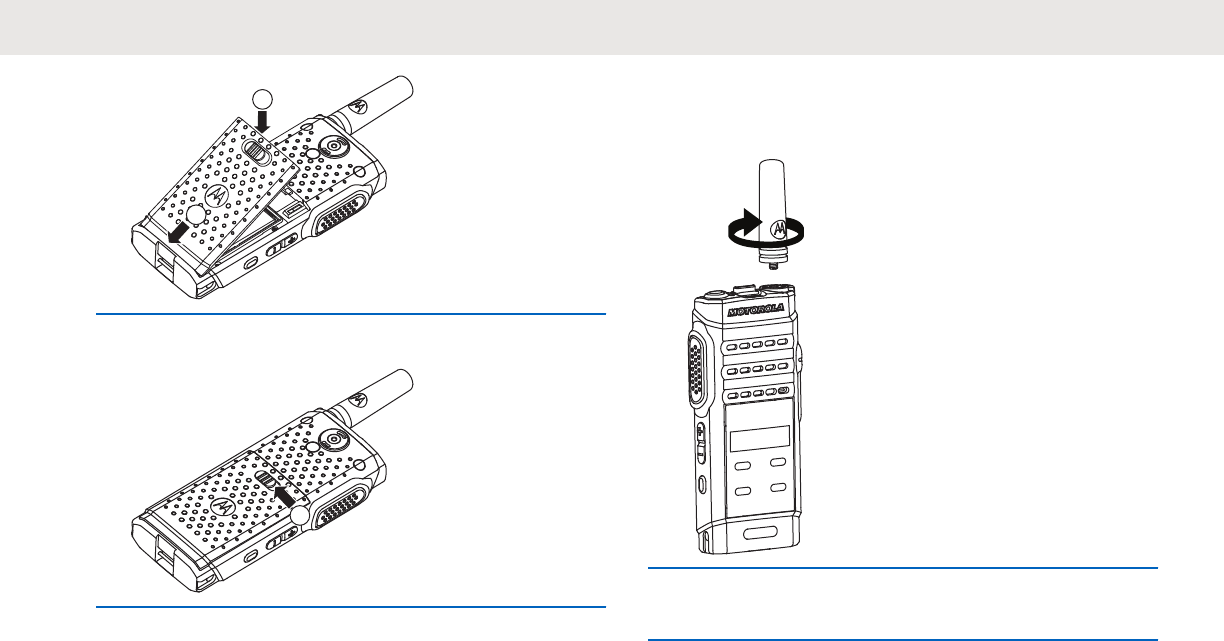Motorola Solutions 89FT7106 2-Way Portable Radio with Bluetooth, Bluetooth LE and WiFi User Manual Print
Motorola Solutions, Inc. 2-Way Portable Radio with Bluetooth, Bluetooth LE and WiFi Print
Contents
- 1. Manual
- 2. RF Safety Manual
Manual
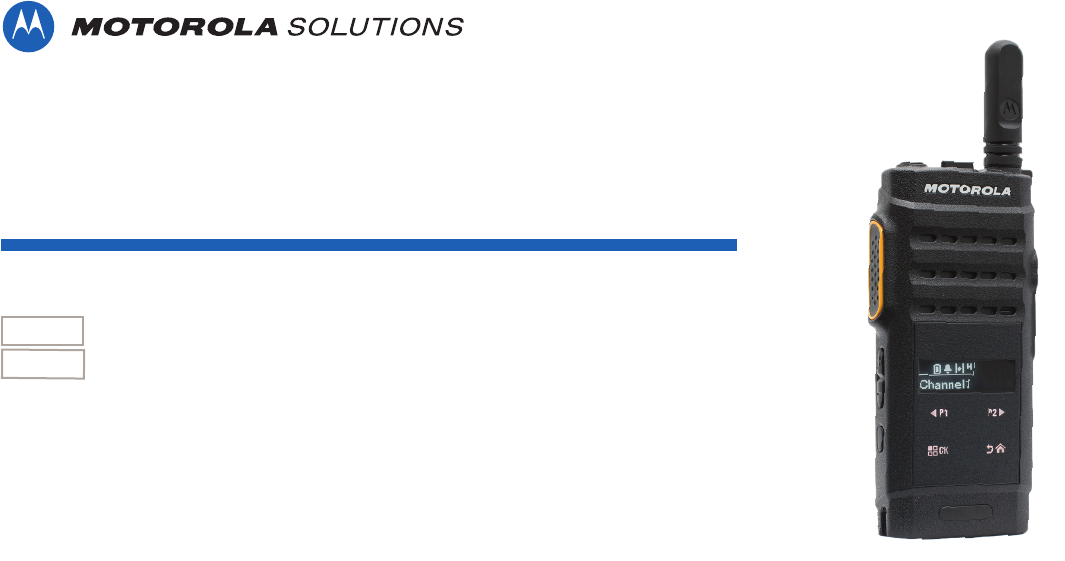
PROFESSIONAL DIGITAL TWO-WAY RADIO
MOTOTRBO™
SL3500e
LIMITED KEYPAD PORTABLE RADIO
USER GUIDE
MARCH 2017
© 2017 Motorola Solutions, Inc. All rights reserved.
MN003119A01-AA
@MN003119A01@
EN-US
FR-CA

Declaration of Conformity
This declaration is applicable to your radio only if your radio is labeled with the FCC logo shown below.
Declaration of Conformity
Per FCC CFR 47 Part 2 Section 2.1077(a)
Responsible Party
Name: Motorola Solutions, Inc.
Address: 1303 East Algonquin Road, Schaumburg, IL 60196-1078, U.S.A.
Phone Number: 1-800-927-2744
Hereby declares that the product:
Model Name: SL3500e
conforms to the following regulations:
FCC Part 15, subpart B, section 15.107(a), 15.107(d), and section 15.109(a)
Table continued…
English
Send Feedback 3

Class B Digital Device
As a personal computer peripheral, this device complies with Part 15 of the FCC Rules. This device complies with
Industry Canada licence-exempt RSS standard(s). Operation is subject to the following two conditions:
1This device may not cause harmful interference, and
2This device must accept any interference received, including interference that may cause undesired operation.
NOTICE:
This equipment has been tested and found to comply with the limits for a Class B digital device, pursuant to
part 15 of the FCC Rules. These limits are designed to provide reasonable protection against harmful inter-
ference in a residential installation. This equipment generates, uses and can radiate radio frequency energy
and, if not installed and used in accordance with the instructions, may cause harmful interference to radio
communications. However, there is no guarantee that interference will not occur in a particular installation.
If this equipment does cause harmful interference to radio or television reception, which can be determined
by turning the equipment off and on, the user is encouraged to try to correct the interference by one or more
of the following measures:
• Reorient or relocate the receiving antenna.
• Increase the separation between the equipment and receiver.
• Connect the equipment into an outlet on a circuit different from that to which the receiver is connected.
• Consult the dealer or an experienced radio or TV technician for help.
English
4 Send Feedback

Contents
Declaration of Conformity...............................................3
Important Safety Information........................................ 11
Notice to Users (FCC and Industry Canada)................13
Software Version.......................................................... 15
Copyrights.................................................................... 17
Computer Software Copyrights.................................... 19
Handling Precautions................................................... 21
Chapter 1: Introduction.................................................23
Icon Information.................................................23
Conventional Analog and Digital Modes............23
IP Site Connect..................................................24
Capacity Plus.....................................................24
Capacity Plus–Single-Site...................... 25
Capacity Plus–Multi-Site.........................25
Chapter 2: Basic Operations........................................ 27
Charging the Battery..........................................27
Attaching the Battery......................................... 27
Attaching the Antenna....................................... 28
Attaching the Earpiece/Audio Accessory...........29
Powering Up the Radio......................................29
Powering Off the Radio..................................... 29
Locking the Radio Display................................. 30
Unlocking the Radio Display..............................30
Adjusting the Volume.........................................30
Chapter 3: Radio Controls............................................31
Programmable Buttons......................................32
Assignable Radio Functions................... 32
Assignable Settings or Utility Functions
................................................................34
Accessing Programmed Functions......... 34
Push-To-Talk (PTT) Button............................... 35
Chapter 4: Status Indicators.........................................37
Icons.................................................................. 37
LED Indicators................................................... 40
Tones.................................................................41
Audio Tones............................................42
Indicator Tones....................................... 42
Chapter 5: Zone and Channel Selections.................... 43
Selecting Zones.................................................43
Selecting Channels............................................43
Chapter 6: Calls............................................................45
English
Send Feedback 5

Group Calls........................................................45
Making Group Calls................................ 46
Responding to Group Calls.....................46
Private Calls ................................................. 47
Making Private Calls ..........................47
Responding to Private Calls .............. 48
All Calls..............................................................49
Making All Calls...................................... 49
Receiving All Calls.................................. 49
Selective Calls ..............................................50
Making Selective Calls............................50
Responding to Selective Calls ...........51
Phone Calls .................................................. 51
Making Phone Calls ...........................52
Making Phone Calls with the
Programmable Phone Button ............ 53
Responding to Phone Calls as Group
Calls ...................................................54
Responding to Phone Calls as Private
Calls ...................................................55
Responding to Phone Calls as All Calls
............................................................56
Stopping Radio Calls ....................................56
Chapter 7: Advanced Features.................................... 59
Talkaround.........................................................59
Toggling Between Repeater and
Talkaround Modes.................................. 59
Monitor Feature................................................. 60
Monitoring Channels...............................60
Permanent Monitor................................. 60
Turning Permanent Monitor On
or Off............................................ 60
Home Channel Reminder.................................. 61
Muting the Home Channel Reminder..... 61
Setting New Home Channels..................61
Remote Monitor................................................. 62
Initiating Remote Monitor........................62
Initiating Remote Monitor by Using the
Contacts List .......................................... 63
Initiating Remote Monitor by Using the
Manual Dial ............................................64
Radio Check .................................................65
English
6 Send Feedback

Sending Radio Checks ...................... 65
Sending Radio Checks by Using the
Contacts List ......................................65
Scan Lists.......................................................... 66
Viewing Entries in the Scan List............. 66
Adding New Entries to the Scan List...... 66
Deleting Entries from the Scan List........ 67
Setting Priority for Entries in the Scan
List.......................................................... 68
Scan.................................................................. 68
Turning Scan On or Off...........................69
Responding to Transmissions During
Scanning.................................................69
Deleting Nuisance Channels.................. 70
Restoring Nuisance Channels................ 70
Vote Scan .....................................................70
Contacts Settings.............................................. 71
Making Group Calls by Using the
Contacts List........................................... 72
Making Private Calls by Using the
Contacts List ......................................73
Setting Default Contact ......................73
Call Indicator Settings........................................74
Activating or Deactivating Call Ringers
for Call Alerts.......................................... 74
Activating or Deactivating Call Ringers
for Private Calls ................................. 75
Activating or Deactivating Call Ringers
for Selective Calls ..............................75
Activating or Deactivating Call Ringers
for Text Messages ............................. 76
Assigning Ring Styles............................. 77
Selecting a Ring Alert Type.................... 78
Configuring Vibrate Style........................ 79
Alarm Tone Volume Escalation.............. 80
Call Log Features.............................................. 80
Viewing Recent Calls .............................80
Deleting Calls from the Call List ........ 81
Viewing Call List Details .................... 81
Call Alert Operation........................................... 82
Responding to Call Alerts....................... 82
Making Call Alerts...................................82
Making Call Alerts by Using the
Contacts List........................................... 83
English
Send Feedback 7

Mute Mode.........................................................83
Turning On Mute Mode...........................84
Setting Mute Mode Timer....................... 84
Exiting Mute Mode.................................. 85
Emergency Operation........................................85
Sending Emergency Alarms .................. 86
Sending Emergency Alarms with Call ....87
Sending Emergency Alarms with Voice
to Follow ............................................ 89
Receiving Emergency Alarms.................90
Reinitiating Emergency Mode.................90
Exiting Emergency Mode After Sending
the Emergency Alarm............................. 91
Privacy ..........................................................91
Turning Privacy On or Off ..................92
Covert Mode...................................................... 93
Entering Covert Mode.............................93
Exiting Covert Mode............................... 93
Security ........................................................ 93
Disabling Radios ................................93
Disabling Radios by Using the
Contacts List ......................................94
Disabling Radios by Using the Manual
Dial .................................................... 95
Enabling Radios ................................ 96
Enabling Radios by Using the Contacts
List ..................................................... 96
Enabling Radios by Using the Manual
Dial .................................................... 97
Lone Worker...................................................... 98
Password Lock Features................................... 98
Accessing Radios by Using Passwords
................................................................98
Unlocking Radios in Locked State.......... 99
Turning Password Lock On or Off.......... 99
Changing Passwords............................100
Notification List................................................ 101
Accessing Notification List.................... 101
Auto-Range Transponder System ..............102
Over-the-Air Programming ......................... 102
Wi-Fi Operation............................................... 103
Turning Wi-Fi On or Off........................ 103
English
8 Send Feedback

Connecting to a Network Access Point.103
Checking Wi-Fi Connection Status....... 104
Viewing Details of Network Access
Points....................................................105
Chapter 8: Utilities...................................................... 107
Squelch Levels................................................ 107
Setting Squelch Levels......................... 107
Power Levels................................................... 108
Setting Power Levels............................ 108
Adjusting Display Brightness........................... 109
Voice Operating Transmission........................ 109
Turning Voice Operating Transmission
On or Off............................................... 110
Setting Display Backlight Timer.......................110
Turning Radio Tones/Alerts On or Off............. 111
Turning Power Up Tone On or Off...................112
Setting Tones/Alerts Volume Offset Levels..... 112
Turning Talk Permit Tone On or Off................ 113
Setting Languages...........................................114
Turning LED Indicators On or Off.................... 114
Turning Introduction Screen On or Off............ 115
Turning Voice Announcement On or Off......... 115
Turning Automatic Call Forwarding On or Off. 116
Setting Menu Timer......................................... 116
Turning Analog Microphone AGC On or Off....117
Turning Digital Microphone AGC On or Off..... 118
Turning Intelligent Audio On or Off.................. 118
Turning Trill Enhancement On or Off...............119
Turning Acoustic Feedback Suppressor On or
Off ...............................................................120
General Radio Information.............................. 120
Accessing Battery Information.............. 121
Checking Radio Alias and ID................ 121
Checking Firmware and Codeplug
Versions................................................121
Checking Software Update Information
..............................................................122
Received Signal Strength Indicator................. 122
Viewing RSSI Values............................123
Front Panel Programming............................... 123
Chapter 9: Authorized Accessories List..................... 125
Batteries and Chargers Warranty...............................129
The Workmanship Warranty............................129
The Capacity Warranty....................................129
English
Send Feedback 9

Limited Warranty........................................................ 131
MOTOROLA SOLUTIONS
COMMUNICATION PRODUCTS.................... 131
I. WHAT THIS WARRANTY COVERS AND
FOR HOW LONG:........................................... 131
II. GENERAL PROVISIONS............................ 132
III. STATE LAW RIGHTS:................................132
IV. HOW TO GET WARRANTY SERVICE......132
V. WHAT THIS WARRANTY DOES NOT
COVER............................................................132
VI. PATENT AND SOFTWARE PROVISIONS
.........................................................................133
VII. GOVERNING LAW................................... 134
English
10 Send Feedback

Important Safety Information
ATTENTION!
This radio is restricted to Occupational use only. Before
using the radio, read the RF Energy Exposure and Product
Safety Guide for Portable Two-Way Radios which contains
important operating instructions for safe usage and RF
energy awareness and control for Compliance with
applicable standards and Regulations.
For a list of Motorola Solutions-approved antennas and
other accessories, visit the following website:
http://www.motorolasolutions.com
Any modification to this device, not expressly authorized by
Motorola Solutions, may void the user's authority to operate
this device.
Under Industry Canada regulations, this radio transmitter
may only operate using an antenna of a type and maximum
(or lesser) gain approved for the transmitter by Industry
Canada. To reduce potential radio interference to other
users, the antenna type and its gain should be so chosen
that the equivalent isotropically radiated power (e.i.r.p.) is
not more than that necessary for successful
communication.
This radio transmitter has been approved by Industry
Canada to operate with Motorola Solutions-approved
antenna with the maximum permissible gain and required
antenna impedance for each antenna type indicated.
Antenna types not included in this list, having a gain
greater than the maximum gain indicated for that type, are
strictly prohibited for use with this device.
English
Send Feedback 11

English
This page intentionally left blank.
12

Notice to Users (FCC and
Industry Canada)
This device complies with Part 15 of the FCC rules and
Industry Canada's license-exempt RSS's per the following
conditions:
• This device may not cause harmful interference.
• This device must accept any interference received,
including interference that may cause undesired
operation.
• Changes or modifications made to this device, not
expressly approved by Motorola Solutions, could void
the authority of the user to operate this equipment.
English
Send Feedback 13

English
This page intentionally left blank.
14

Software Version
All the features described in the following sections are
supported by the software version R02.08.00.0000 or later.
See Checking Firmware and Codeplug Versions on page
121 to determine the software version of your radio.
Check with your dealer or system administrator for more
information.
English
Send Feedback 15

English
This page intentionally left blank.
16

Copyrights
The Motorola Solutions products described in this
document may include copyrighted Motorola Solutions
computer programs. Laws in the United States and other
countries preserve for Motorola Solutions certain exclusive
rights for copyrighted computer programs. Accordingly, any
copyrighted Motorola Solutions computer programs
contained in the Motorola Solutions products described in
this document may not be copied or reproduced in any
manner without the express written permission of Motorola
Solutions.
© 2017 Motorola Solutions, Inc. All Rights Reserved
No part of this document may be reproduced, transmitted,
stored in a retrieval system, or translated into any language
or computer language, in any form or by any means,
without the prior written permission of Motorola Solutions,
Inc.
Furthermore, the purchase of Motorola Solutions products
shall not be deemed to grant either directly or by
implication, estoppel or otherwise, any license under the
copyrights, patents or patent applications of Motorola
Solutions, except for the normal non-exclusive, royalty-free
license to use that arises by operation of law in the sale of
a product.
Disclaimer
Please note that certain features, facilities, and capabilities
described in this document may not be applicable to or
licensed for use on a specific system, or may be dependent
upon the characteristics of a specific mobile subscriber unit
or configuration of certain parameters. Please refer to your
Motorola Solutions contact for further information.
Trademarks
MOTOROLA, MOTO, MOTOROLA SOLUTIONS, and the
Stylized M Logo are trademarks or registered trademarks of
Motorola Trademark Holdings, LLC and are used under
license. All other trademarks are the property of their
respective owners.
European Union (EU) Waste of Electrical and
Electronic Equipment (WEEE) directive
The European Union's WEEE directive requires that
products sold into EU countries must have the crossed out
trash bin label on the product (or the package in some
cases).
As defined by the WEEE directive, this cross-out trash bin
label means that customers and end-users in EU countries
English
Send Feedback 17

Computer Software
Copyrights
The Motorola Solutions products described in this manual
may include copyrighted Motorola Solutions computer
programs stored in semiconductor memories or other
media. Laws in the United States and other countries
preserve for Motorola Solutions certain exclusive rights for
copyrighted computer programs including, but not limited
to, the exclusive right to copy or reproduce in any form the
copyrighted computer program. Accordingly, any
copyrighted Motorola Solutions computer programs
contained in the Motorola Solutions products described in
this manual may not be copied, reproduced, modified,
reverse-engineered, or distributed in any manner without
the express written permission of Motorola Solutions.
Furthermore, the purchase of Motorola Solutions products
shall not be deemed to grant either directly or by
implication, estoppel, or otherwise, any license under the
copyrights, patents or patent applications of Motorola
Solutions, except for the normal non-exclusive license to
use that arises by operation of law in the sale of a product.
The AMBE+2™ voice coding Technology embodied in this
product is protected by intellectual property rights including
patent rights, copyrights and trade secrets of Digital Voice
Systems, Inc.
This voice coding Technology is licensed solely for use
within this Communications Equipment. The user of this
Technology is explicitly prohibited from attempting to
decompile, reverse engineer, or disassemble the Object
Code, or in any other way convert the Object Code into a
human-readable form.
U.S. Pat. Nos. #5,870,405, #5,826,222, #5,754,974,
#5,701,390, #5,715,365, #5,649,050, #5,630,011,
#5,581,656, #5,517,511, #5,491,772, #5,247,579,
#5,226,084 and #5,195,166.
English
Send Feedback 19

English
This page intentionally left blank.
20

Handling Precautions
The MOTOTRBO Series Digital Portable radio meets IP54
specifications, allowing the radio to withstand adverse field
conditions such as being exposed to water or dust.
CAUTION:
Do not disassemble the radio. This could damage
radio seals and result in leak paths into the radio.
Radio maintenance should only be done in service
depot that is equipped to test and replace the seal
on the radio.
• Keep your radio clean and exposure to water should be
avoided to help ensure proper functionality and
performance.
• To clean the exterior surfaces of the radio, use a diluted
solution of mild dishwashing detergent and fresh water
(example, one teaspoon of detergent to one gallon of
water).
• These surfaces should be cleaned whenever a periodic
visual inspection reveals the presence of smudges,
grease, and/or grime.
CAUTION:
The effects of certain chemicals and their vapors
can have harmful results on certain plastics.
Avoid using aerosol sprays, tuner cleaners, and
other chemicals.
English
Send Feedback 21

English
This page intentionally left blank.
22

Introduction
This user guide covers the operation of the MOTOTRBO
radios.
Your dealer or system administrator may have customized
your radio for your specific needs. Check with your dealer
or system administrator for more information.
You can consult your dealer or system administrator about
the following:
• Is your radio programmed with any preset conventional
channels?
• Which buttons have been programmed to access other
features?
• What optional accessories may suit your needs?
• What are the best radio usage practices for effective
communication?
• What maintenance procedures that helps promote
longer radio life?
Icon Information
Throughout this publication, the icons described are used
to indicate features supported in either the conventional
analog or conventional digital mode.
Indicates a conventional Analog Mode-Only feature.
Indicates a conventional Digital Mode-Only feature.
For features that are available in both conventional analog
and digital modes, both icons are not shown.
Conventional Analog and Digital
Modes
Each channel in your radio can be configured as a
conventional analog or conventional digital channel.
Certain features are unavailable when switching from
digital to analog mode. The icons for digital features reflect
English
Send Feedback 23

this change by appearing “grayed out”. The disabled
features are hidden in the menu.
Your radio also has features available in both analog and
digital modes. The minor differences in the way each
feature works do not affect the performance of your radio.
NOTICE:
Your radio also switches between digital and analog
modes during a dual mode scan. See Scan on page
68 for more information.
IP Site Connect
This feature allows your radio to extend conventional
communication beyond the reach of a single site by
connecting to different available sites by using an Internet
Protocol (IP) network.
When the radio moves out of range from one site and into
the range of another, the radio connects to the repeater of
the new site to send or receive calls or data transmissions.
This is done either automatically or manually depending on
your settings.
In an automatic site search, the radio scans through all
available sites when the signal from the current site is weak
or when the radio is unable to detect any signal from the
current site. The radio then locks on to the repeater with
the strongest Received Signal Strength Indicator (RSSI)
value.
In a manual site search, the radio searches for the next site
in the roam list that is currently in range but which may not
have the strongest signal and locks on to the repeater.
NOTICE:
Each channel can only have either Scan or Roam
enabled, not both at the same time.
Channels with this feature enabled can be added to a
particular roam list. The radio searches the channels in the
roam list during the automatic roam operation to locate the
best site. A roam list supports a maximum of 16 channels,
including the selected channel.
NOTICE:
You cannot manually add or delete an entry in the
roam list. Check with your dealer or system
administrator for more information.
Capacity Plus
Capacity Plus is an entry-level trunked system for single
and multiple sites. The single and multi-site dynamic
trunking offers better capacity and coverage.
English
24 Send Feedback

Capacity Plus–Single-Site
Capacity Plus–Single-Site is a single-site trunking
configuration of the MOTOTRBO radio system, which uses
a pool of channels to support hundreds of users and up to
254 Groups. This feature allows your radio to efficiently
utilize the available number of programmed channels while
in Repeater Mode.
You hear a negative indicator tone if you try to access a
feature not applicable to Capacity Plus–Single-Site by
using a programmable button press.
Your radio also has features that are available in
conventional digital mode, IP Site Connect, and Capacity
Plus. However, the minor differences in the way each
feature works does not affect the performance of your
radio.
Check with your dealer or system administrator for more
information on this configuration.
Capacity Plus–Multi-Site
Capacity Plus–Multi-Site is a multi-channel trunking
configuration of the MOTOTRBO radio system, combining
the best of both Capacity Plus and IP Site Connect
configurations.
Capacity Plus–Multi-Site allows your radio to extend
trunking communication beyond the reach of a single site,
by connecting to different available sites which are
connected with an Internet Protocol (IP) network. It also
provides an increase in capacity by efficiently utilizing the
combined available number of programmed channels
supported by each of the available sites.
When the radio moves out of range from one site and into
the range of another, it connects to the repeater of the new
site to send or receive calls/data transmissions. Depending
on your settings, this is done automatically or manually.
If the radio is set to do this automatically, it scans through
all available sites when the signal from the current site is
weak or when the radio is unable to detect any signal from
the current site. It then locks on to the repeater with the
strongest Received Signal Strength Indicator (RSSI) value.
In a manual site search, the radio searches for the next site
in the roam list that is currently in range (but which may not
have the strongest signal) and locks on to it.
Any channel with Capacity Plus–Multi-Site enabled can be
added to a particular roam list. The radio searches these
channels during the automatic roam operation to locate the
best site.
English
Send Feedback 25

NOTICE:
You cannot manually add or delete an entry to the
roam list. Check with your dealer or system
administrator for more information.
Similar to Capacity Plus–Single Site, icons of features not
applicable to Capacity Plus–Multi-Site are not available in
the menu. You hear a negative indicator tone if you try to
access a feature not applicable to Capacity Plus–Multi-Site
by using a programmable button press.
English
26 Send Feedback

Basic Operations
This chapter explains the operations to get you started on
using the radio.
Charging the Battery
Your radio is powered by a Lithium-Ion (Li-lon) battery.
• To comply with warranty terms and avoid damages,
charge the battery using a Motorola Solutions
charger exactly as described in the charger user
guide.
All chargers can charge only Motorola Solutions
authorized batteries. Other batteries may not charge.
Motorola Solutions recommends that your radio
remains powered off while charging.
• Charge a new battery 14 to 16 hours before initial
use for best performance.
• Press the On/Off button when the radio is powered
off while charging.
- The radio plays the battery strength
announcement voice message.
- The LED indicator indicates the battery strength.
- The display shows the battery charging icon and
battery strength level.
Attaching the Battery
Follow the procedure to attach the battery to your radio.
1Align the battery contacts with the contacts inside
the battery compartment. Insert the contact side of
the battery first. Gently push the battery into place.
1
2
2To attach battery cover, align it in place and slide the
battery latch until it snaps into place.
English
Send Feedback 27
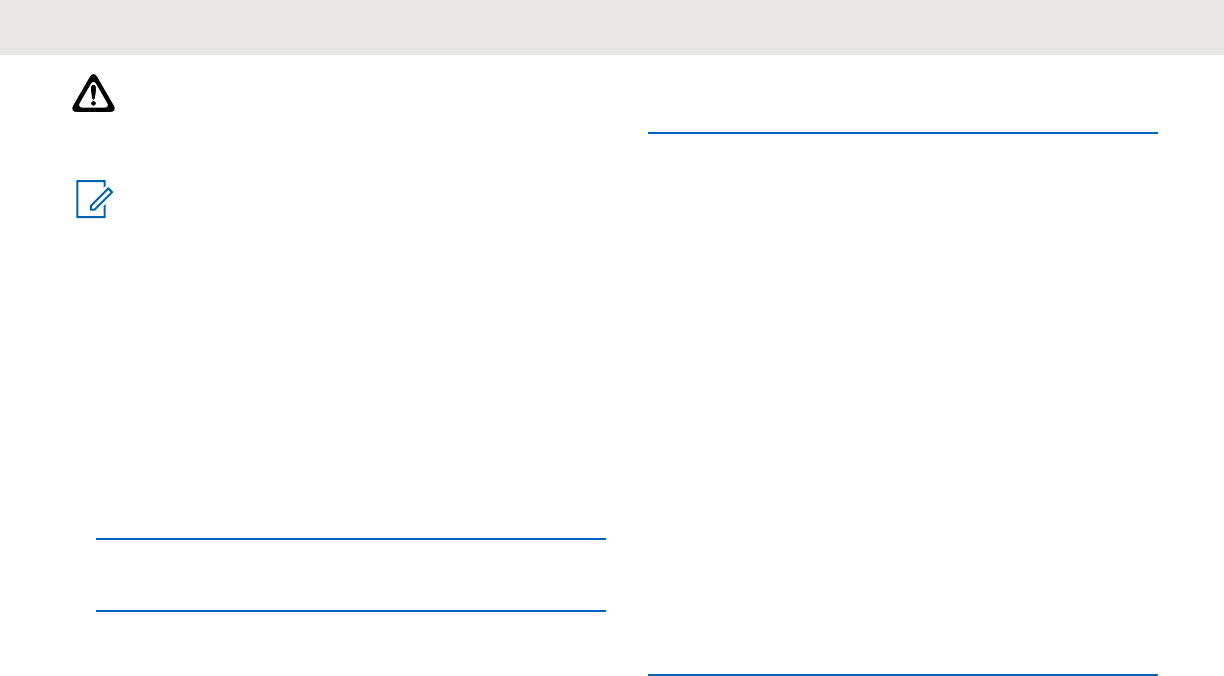
CAUTION:
If the antenna must be replaced, ensure that only
MOTOTRBO antennas are used. Neglecting this
damages your radio.
NOTICE:
When attaching a VHF antenna to the radio, the
CPS configuration for antenna selection must match
the chosen VHF antenna. A mismatch in antennas
results in decreased range.
Attaching the Earpiece/Audio
Accessory
The audio accessory connector is located on the right side
of the radio. Follow the procedure to attach accessories to
your radio.
1Lift the flap of the audio jack cover.
2Align the indicators on both the connector and
housing, then push until it fits in properly.
Powering Up the Radio
Follow the procedure to power up your radio.
Long press the On/Off button to power up the radio
when charging or otherwise.
If successful:
• A tone sounds.
• The green LED lights up.
• The display shows a power-on animation.
When the radio is idle, the LED displays a blinking green
light to indicate that the radio is on. The blinking green light
turns off in the presence of other LED activity and resumes
when radio returns to idle mode.
If the Tones/Alerts function is disabled, there is no tone
upon powering up.
Check your battery if your radio does not power up. Make
sure that it is charged and properly attached. Contact your
dealer if your radio still does not power up.
Powering Off the Radio
Follow the procedure to power off your radio.
Long press the On/Off button.
English
Send Feedback 29

Locking the Radio Display
You can lock your radio screen to avoid an inadvertent key
entry. Follow the procedure to lock the radio display.
Short press the On/Off button.
• The radio display turns off.
• The touch screen keypad is hidden and inactive.
Unlocking the Radio Display
Follow the procedure to unlock the radio display.
Short press the On/Off button.
• The radio display lights up.
• The touch screen keypad becomes visible and
active.
Adjusting the Volume
Follow the procedure to change the volume level of your
radio.
Do one of the following:
• Press the Volume Up button to increase the
volume.
• Press the Volume Down button to decrease the
volume.
NOTICE:
Your radio can be programmed to have a
minimum volume offset where the volume
level cannot be lowered past the
programmed minimum volume. Check with
your dealer or system administrator for more
information.
English
30 Send Feedback
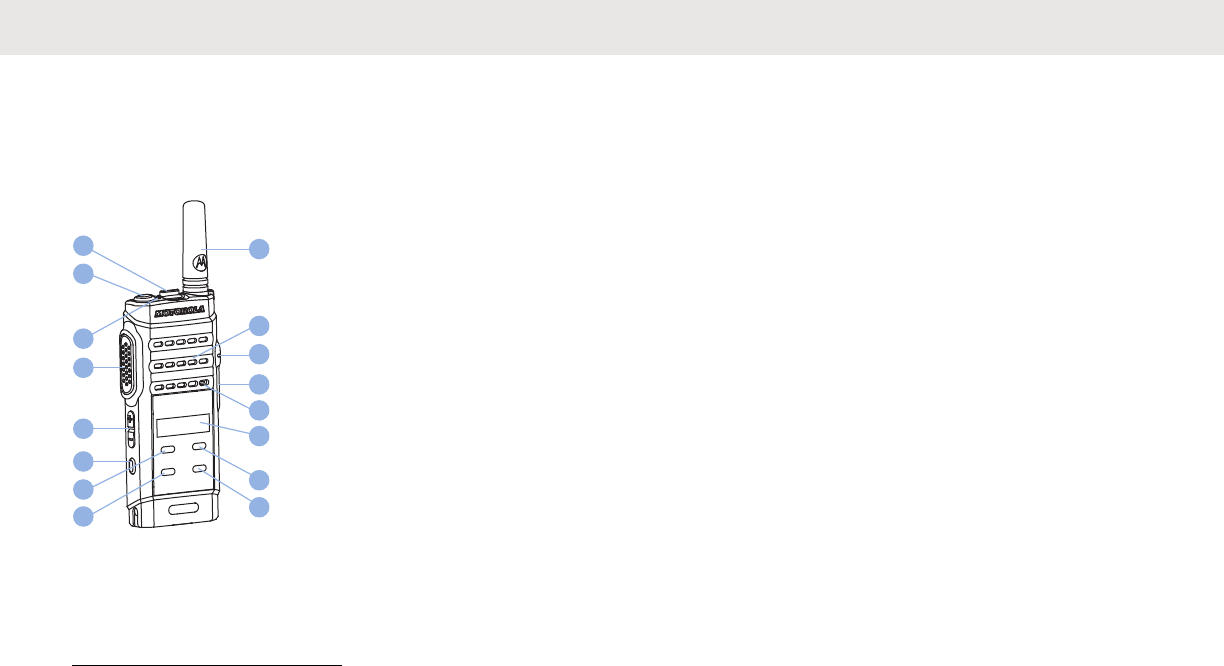
Radio Controls
This chapter explains the buttons and functions to control
the radio.
6
7
8
10
9
1
5
4
14
16
15
13
2
3
12
11
1Channel Rocker
2On/Off Button
3LED Indicator
4Push-to-Talk (PTT) Button
5Volume Button
6Side Button 11
7P1/Left Navigation Button2
8Menu/OK Button2
9Back/Home Button2
10 P2/Right Navigation Button2
11 Display
12 Microphone
13 USB Connector
14 Accessory Connector
15 Speaker
16 Antenna
1This button is programmable.
2These touch screen buttons become visible when the radio is unlocked.
English
Send Feedback 31

Programmable Buttons
Depending on the duration of a button press, your dealer
can program the programmable buttons as shortcuts to
radio functions.
Short press
Pressing and releasing rapidly.
Long press
Pressing and holding for the programmed duration.
NOTICE:
See Emergency Operation on page 85 for more
information on the programmed duration of the
Emergency button.
Assignable Radio Functions
The following radio functions can be assigned to the
programmable buttons.
Audio Toggle
Toggles audio routing between the internal radio
speaker and the speaker of a wired accessory.
Contacts
Provides direct access to the Contacts list.
Call Alert
Provides direct access to the contacts list for you to
select a contact to whom a Call Alert can be sent.
Call Forwarding
Toggles Call Forwarding on or off.
Call Log
Selects the call log list.
Channel Announcement
Plays zone and channel announcement voice
messages for the current channel.
Emergency
Depending on the programming, initiates or cancels an
emergency.
Intelligent Audio
Toggles intelligent audio on or off.
Manual Site Roam 3
Starts the manual site search.
3Not applicable in Capacity Plus.
English
32 Send Feedback

Mic AGC
Toggles the internal microphone automatic gain control
(AGC) on or off.
Monitor
Monitors a selected channel for activity.
Notifications
Provides direct access to the Notifications list.
Nuisance Channel Delete 3
Temporarily removes an unwanted channel, except for
the Selected Channel, from the scan list. The Selected
Channel refers to the selected zone or channel
combination of the user from which scan is initiated.
One Touch Access
Directly initiates a predefined Private, Phone or Group
Call, a Call Alert, or a Quick Text message.
Permanent Monitor 3
Monitors a selected channel for all radio traffic until
function is disabled.
Phone
Provides direct access to the Phone Contacts list.
Privacy
Toggles privacy on or off.
Radio Alias and ID
Provides radio alias and ID.
Radio Check
Determines if a radio is active in a system.
Radio Enable
Allows a target radio to be remotely enabled.
Radio Disable
Allows a target radio to be remotely disabled.
Repeater/Talkaround 3
Toggles between using a repeater and communicating
directly with another radio.
Reset Home Channel
Sets a new home channel.
Silence Home Channel Reminder
Mutes the Home Channel Reminder.
Scan 4
Toggles scan on or off.
4Not applicable in Capacity Plus–Single-Site.
English
Send Feedback 33
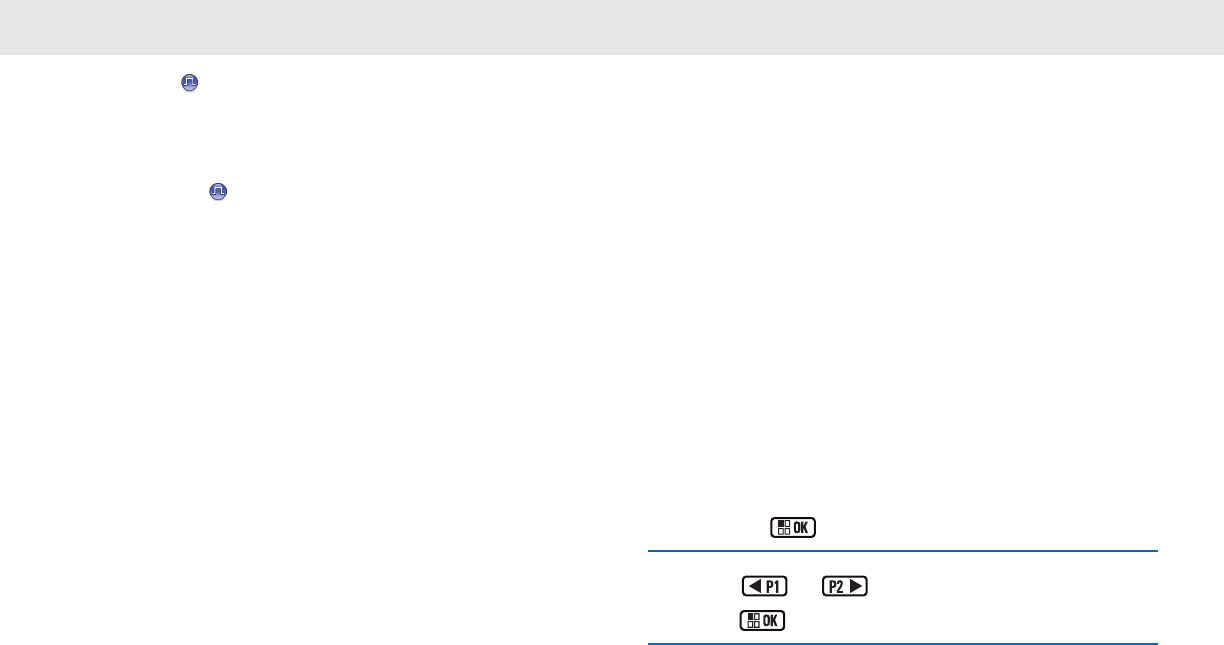
Site Lock 3
When toggled on, the radio searches the current site
only. When toggled off, the radio searches other sites in
addition to the current site.
Text Message
Selects the text message menu.
Transmit Interrupt Remote Dekey
Stops an ongoing interruptible call to free the channel.
Trill Enhancement
Toggles trill enhancement on or off.
Voice Announcement On/Off
Toggles voice announcement on or off.
Voice Operating Transmission (VOX)
Toggles VOX on or off.
Zone Selection
Allows selection from a list of zones.
Assignable Settings or Utility
Functions
The following radio settings or utility functions can be
assigned to the programmable buttons.
Tones/Alerts
Toggles all tones and alerts on or off.
Backlight
Toggles display backlight on or off.
Backlight Brightness
Adjusts the brightness level.
Power Level
Toggles transmit power level between high and low.
Accessing Programmed Functions
Follow the procedure to access programmed functions in
your radio.
1Do one of the following:
• Press the programmed button. Proceed to step 3.
• Press to access the menu.
2Press or to the menu function, and
press to select a function or enter a sub-menu.
3Do one of the following:
English
34 Send Feedback

• Press to return to the previous screen.
• Long press to return to the Home screen.
Your radio automatically exits the menu after a
period of inactivity and returns to the Home screen.
Push-To-Talk (PTT) Button
The PTT button serves two basic purposes.
• While a call is in progress, the PTT button allows the
radio to transmit to other radios in the call. The
microphone is activated when the PTT button is
pressed.
• While a call is not in progress, the PTT button is used to
make a new call (see Calls on page 45).
Long press the PTT button to talk. Release the PTT button
to listen.
If the Talk Permit Tone or the PTT Sidetone is enabled,
wait until the short alert tone ends before talking.
If the Channel Free Indication feature is enabled on your
radio (programmed by your dealer), you will hear a short
alert tone the moment the target radio (the radio that is
receiving your call) releases the PTT button, indicating the
channel is free for you to respond.
You hear a continuous Talk Prohibit Tone if your call is
interrupted, for example when the radio receives an
Emergency call. You should release the PTT button if you
hear a continous Talk Prohibit Tone.
English
Send Feedback 35

English
This page intentionally left blank.
36
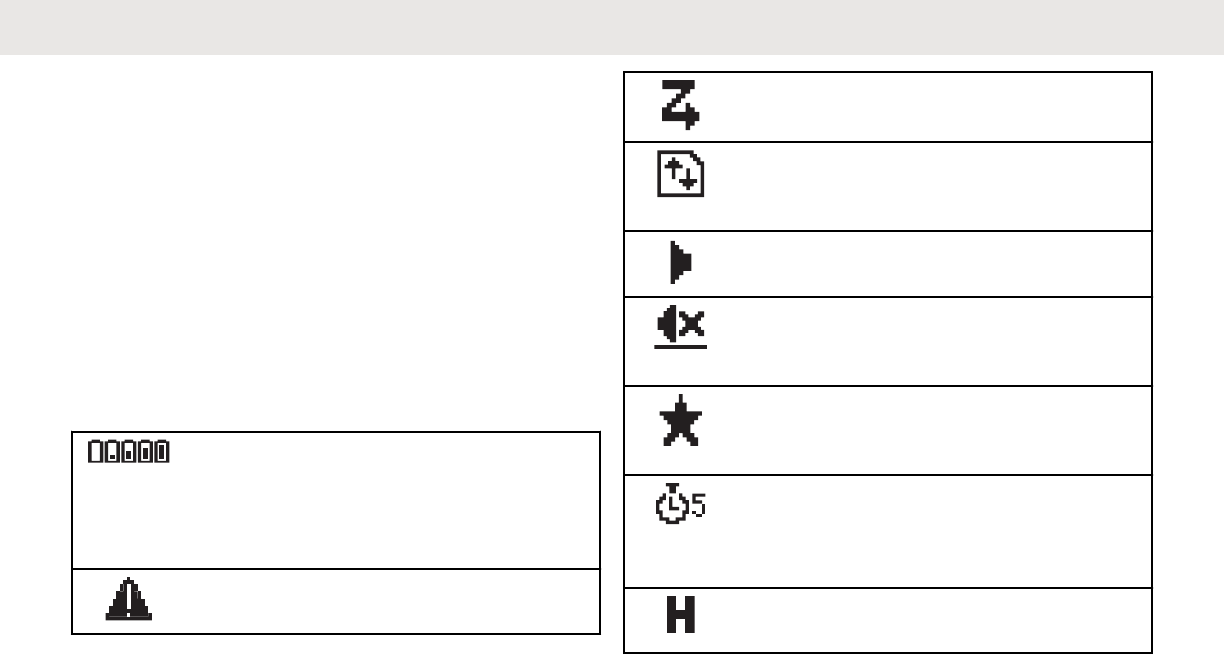
Status Indicators
This chapter explains the status indicators and audio tones
used in the radio.
Icons
The following icons appear on the status bar at the top of
the radio display.
Table 1: Display Icons
The icons are arranged left most in order of appearance or
usage.
Battery
The number of bars (0–4) shown indi-
cates the charge remaining in the bat-
tery. The icon blinks when the battery
bar is at 0.
Emergency
Radio is in Emergency mode.
Table continued…
Flexible Receive List
Flexible receive list is enabled.
High Volume Data
Radio is receiving high volume data
and channel is busy.
Monitor
Selected channel is being monitored.
Mute Mode
Mute Mode is enabled and speaker is
muted.
Notification
Notification List has one or more
missed events.
Over-the-Air Programming Delay Tim-
er
Indicates time left before automatic re-
start of radio.
Power High
Radio is set at High power.
Table continued…
English
Send Feedback 37
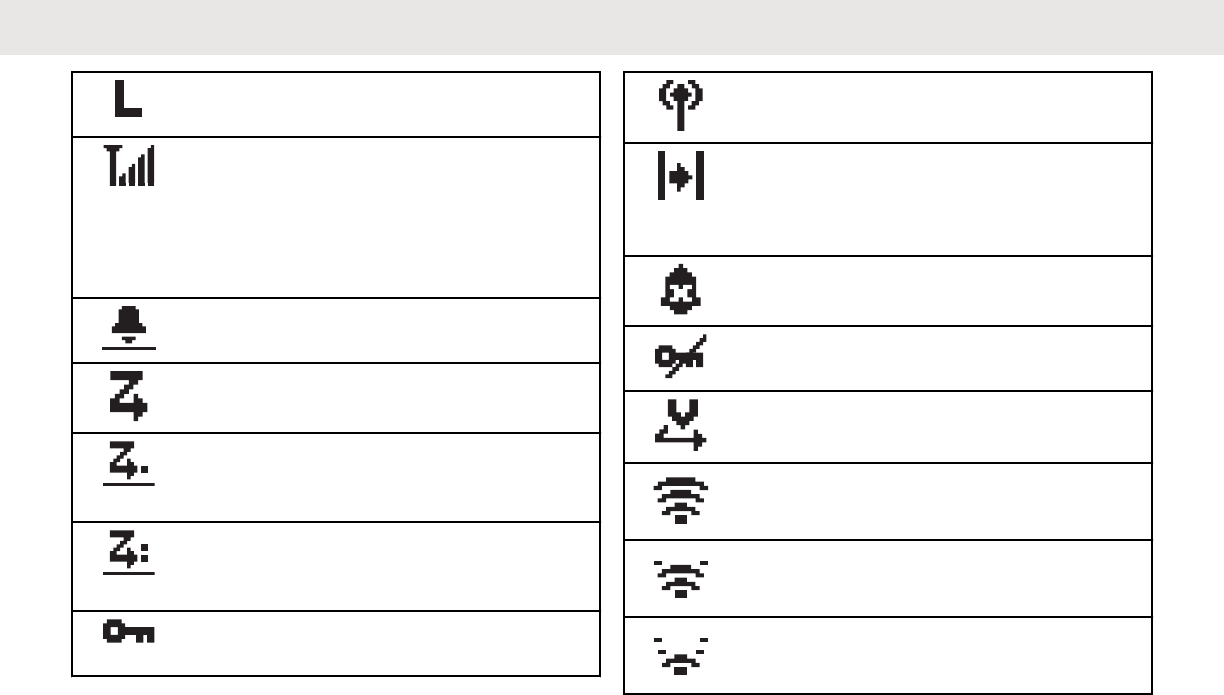
Power Low
Radio is set at Low power.
Received Signal Strength Indicator
(RSSI)
The number of bars displayed repre-
sents the radio signal strength. Four
bars indicate the strongest signal. This
icon is only displayed while receiving.
Ring Only
Ringing mode is enabled.
Scan
Scan feature is enabled.
Scan-Priority 1
Radio detects activity on channel/
group designated as Priority 1.
Scan-Priority 2
Radio detects activity on channel/
group designated as Priority 2.
Secure
The Privacy feature is enabled.
Table continued…
Site Roaming
The site roaming feature is enabled.
Talkaround
In the absence of a repeater, radio is
configured for direct radio-to-radio
communication.
Tones Disable
Tones are turned off.
Unsecure
The Privacy feature is disabled.
Vote Scan
Vote scan feature is enabled.
Wi-Fi Excellent
Wi-Fi signal is excellent.
Wi-Fi Good
Wi-Fi signal is good.
Wi-Fi Average
Wi-Fi signal is average.
Table continued…
English
38 Send Feedback
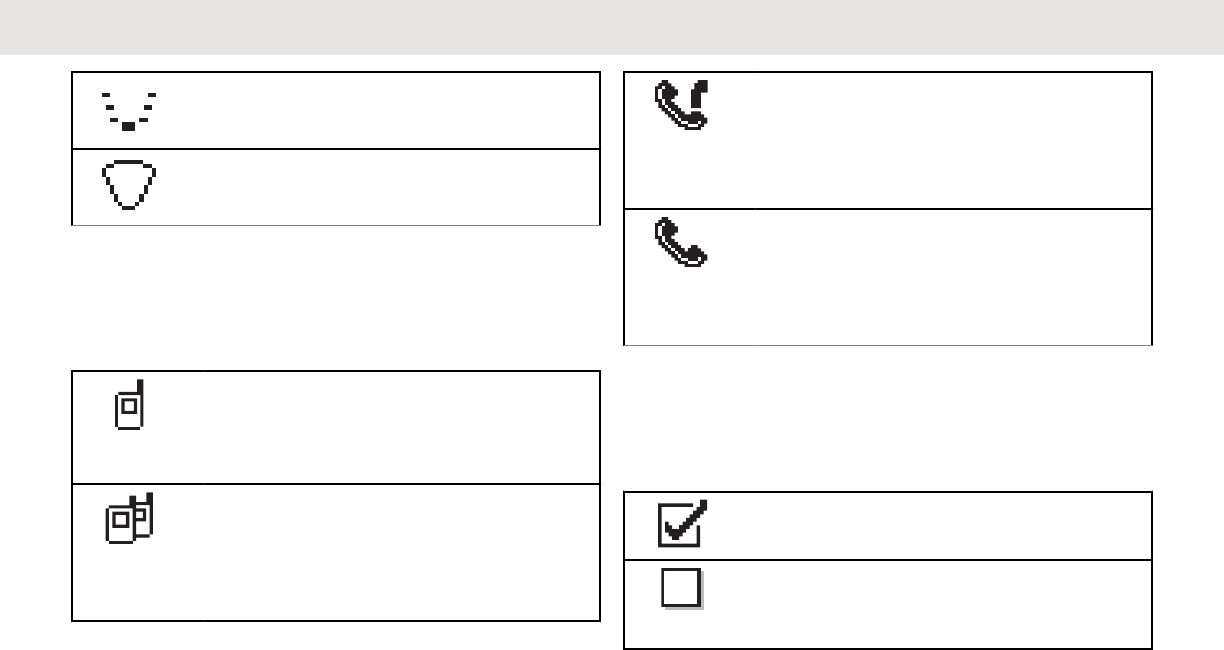
Wi-Fi Poor
Wi-Fi signal is poor.
Wi-Fi Unavailable
Wi-Fi signal is unavailable.
Table 2: Call Icons
The following icons appear on the display during a call.
These icons also appear in the Contacts list to indicate
alias or ID type.
Private Call
Indicates a Private Call in progress. In
the Contacts list, it indicates a sub-
scriber alias (name) or ID (number).
Group Call/All Call
Indicates a Group Call or All Call in
progress. In the Contacts list, it indi-
cates a group alias (name) or ID
(number).
Table continued…
Phone Call as Group/All Call
Indicates a Phone Call as Group Call
or All Call in progress. In the Contacts
list, it indicates a group alias (name)
or ID (number).
Phone Call as Private Call
Indicates a Phone Call as Private Call
in progress. In the Contacts list, it indi-
cates a phone alias (name) or ID
(number).
Table 3: Advance Menu Icons
The following icons appear beside menu items that offer a
choice between two options or as an indication that there is
a sub-menu offering two options.
Checkbox (Checked)
Indicates that the option is selected.
Checkbox (Empty)
Indicates that the option is not selec-
ted.
Table continued…
English
Send Feedback 39
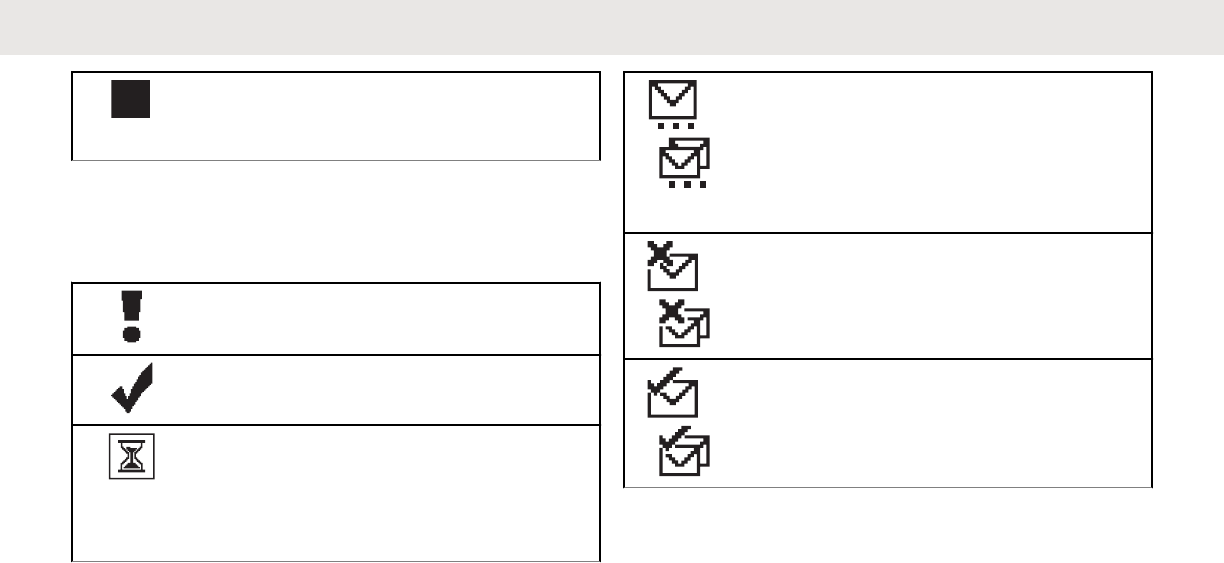
Solid Black Box
Indicates that the option selected for
the menu item with a sub-menu.
Table 4: Mini Notice Icons
The following icons appear momentarily on the display after
an action to perform a task is taken.
Failed Transmission (Negative)
Failed action taken.
Successful Transmission (Positive)
Successful action taken.
Transmission in Progress (Transi-
tional)
Transmitting. This is seen before indi-
cation for Successful Transmission or
Failed Transmission.
Table 5: Sent Items Icons
The following icons appear at the top right corner of the
display in the Sent Items folder.
or
In Progress
The text message to a subscriber
alias or ID is pending transmission,
followed by waiting for acknowledge-
ment. The text message to a group
alias or ID is pending transmission.
or
Send Failed
The text message cannot be sent.
or
Sent Successfully
The text message has been success-
fully sent.
LED Indicators
LED indicators show the operational status of your radio.
Solid Red
Radio is charging.
Blinking Red
Radio has failed the self-test upon powering up.
English
40 Send Feedback

Radio is receiving an emergency transmission.
Radio is transmitting in low battery state.
Radio has moved out of range if Auto-Range
Transponder System is configured.
Radio encountered charging errors.
Mute Mode is enabled.
Solid Green
Radio is powering up.
Radio is transmitting.
Radio is sending a Call Alert or an emergency
transmission.
Blinking Green
Radio is receiving a call or data.
Radio is retrieving Over-the-Air Programming
transmissions.
Radio is detecting activity over the air.
Radio is turned on and idle.
NOTICE:
This activity may or may not affect the
programmed channel of the radio due to the
nature of the digital protocol.
Double Blinking Green
Radio is receiving a privacy-enabled call or data.
Solid Yellow
Radio is monitoring a conventional channel.
Blinking Yellow
Radio is scanning for activity.
Radio is receiving a Call Alert.
Radio has Flexible Receive List enabled.
All Capacity Plus-Multi-Site channels are busy.
Double Blinking Yellow
Radio has Auto Roaming enabled.
Radio is actively searching for a new site.
Radio has yet to respond to a Group Call Alert.
Radio is locked.
Radio is not connected to the repeater while in Capacity
Plus.
All Capacity Plus channels are busy.
Tones
The following are the tones that sound through on the radio
speaker.
English
Send Feedback 41
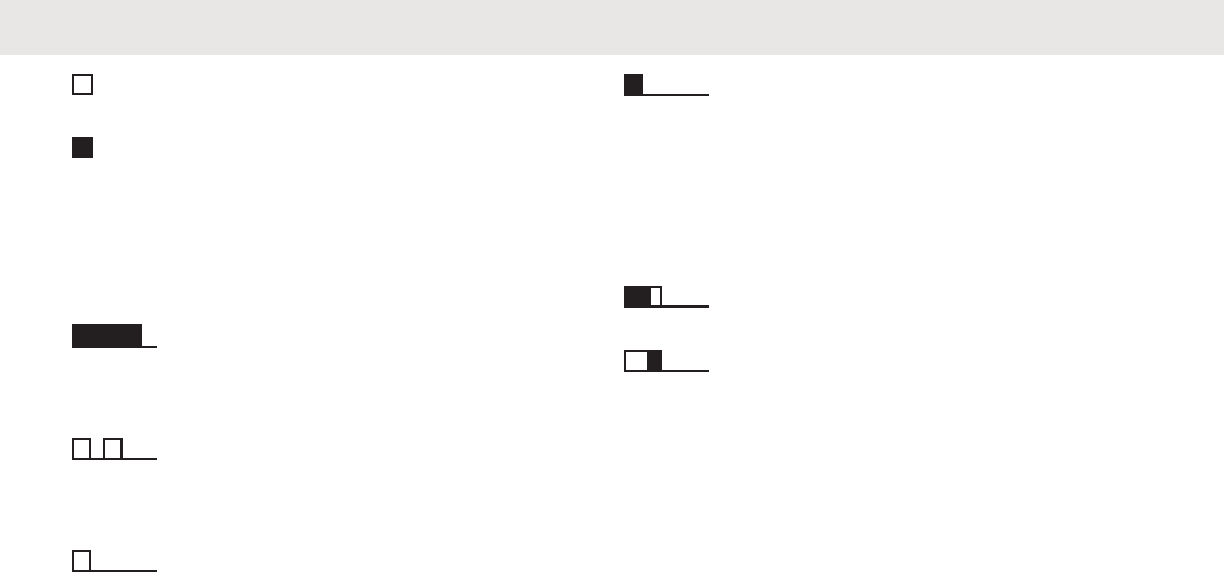
High Pitched Tone
Low Pitched Tone
Audio Tones
Audio tones provide you with audible indications of the
status, or response to data received on the radio.
Continuous Tone
A monotone sound. Sounds continuously until
termination.
Periodic Tone
Sounds periodically depending on the duration set by
the radio. Tone starts, stops, and repeats itself.
Repetitive Tone
A single tone that repeats itself until it is terminated by
the user.
Momentary Tone
Sounds once for a short duration set by the radio.
Indicator Tones
Indicator tones provide you with audible indications of the
status after an action to perform a task is taken.
Positive Indicator Tone
Negative Indicator Tone
English
42 Send Feedback
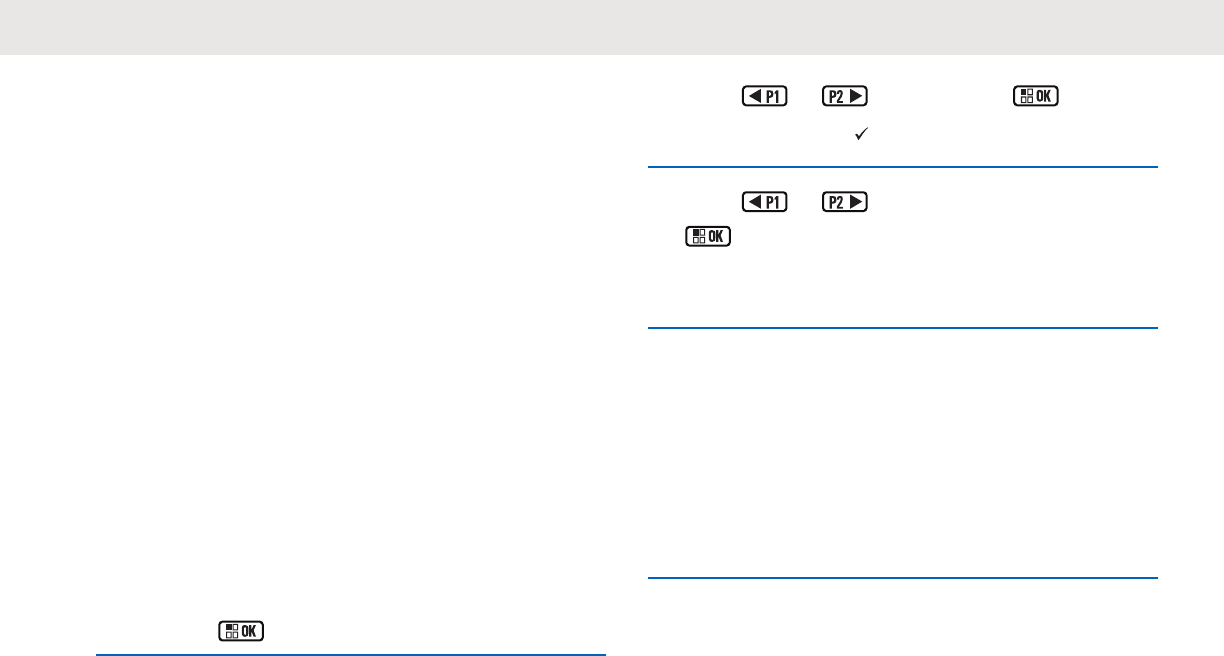
Zone and Channel
Selections
This chapter explains the operations to select a zone or
channel on your radio.
A zone is a group of channels. Your radio supports up to
128 channels and 50 zones, with a maximum of 16
channels per zone.
Each channel can be programmed with different features
and/or support different groups of users.
Selecting Zones
Follow the procedure to select the required zone on your
radio.
1Do one of the following:
• Press the programmed Zone Selection button.
Proceed to step 3.
• Press to access the menu.
2Press or to Zone. Press to select.
The display shows and the current zone.
3Press or to the required zone. Press
to select.
The display shows <Zone> Selected momentarily
and returns to the selected zone screen.
Selecting Channels
Follow the procedure to select the required channel on your
radio after you have selected a zone.
Push the Channel Rocker to select the channel.
The radio displays the current channel and plays the
channel announcement voice message.
English
Send Feedback 43

English
This page intentionally left blank.
44

Calls
This chapter explains the operations to receive, respond to,
make, and stop calls.
You can select a subscriber alias or ID, or group alias or ID
after you have selected a channel by using one of these
features:
Alias Search
This method is used for Group, Private, and All Calls
only with a keypad microphone.
Contacts List
This method provides direct access to the Contacts list.
Manual Dial (by using Contacts)
This method is used for Private and Phone Calls only
with a keypad microphone.
Programmed Number Keys
This method is used for Group, Private, and All Calls
only with a keypad microphone.
NOTICE:
You can only have one alias or ID assigned to a
number key, but you can have more than one
number key associated to an alias or ID. All the
number keys on a keypad microphone can be
assigned. See Assigning Entries to
Programmable Number Keys for more
information.
Programmed One Touch Access Button
This method is used for Group, Private, and Phone
Calls only.
You can only have one ID assigned to a One Touch
Access button with a short or long programmable
button press. Your radio can have multiple One Touch
Access buttons programmed.
Programmable Button
This method is used for Phone Calls only.
Group Calls
Your radio must be configured as part of a group to receive
a call from or make a call to the group of users.
English
Send Feedback 45
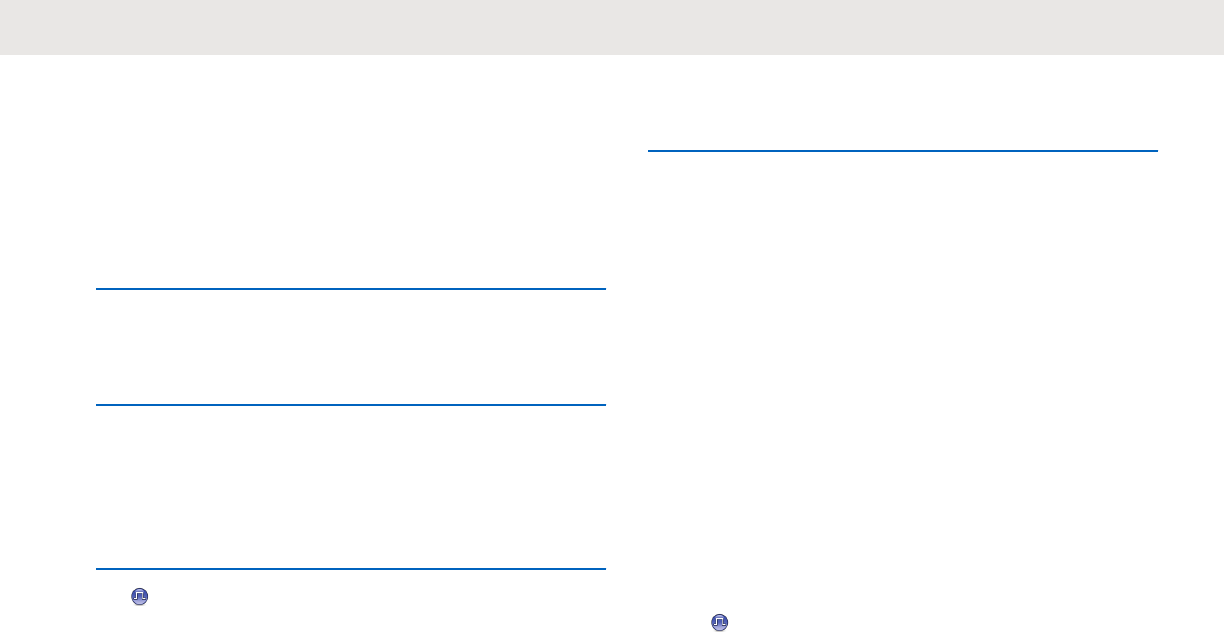
Making Group Calls
Follow the procedure to make Group Calls on your radio.
1Do one of the following:
• Select a channel with the active group alias or ID.
• Press the programmed One Touch Access
button.
2Press the PTT button to make the call.
The green LED lights up. The first text line shows the
Group Call icon and alias.
3Release the PTT button to listen.
The green LED lights up when the target radio
responds. The display shows the Group Call icon,
the group alias or ID, and the transmitting radio alias
or ID.
4 If the Channel Free Indication feature is enabled,
you hear a short alert tone the moment the
transmitting radio releases the PTT button, indicating
the channel is free for you to respond. Press the PTT
button to respond to the call.
The call ends when there is no voice activity for a
predetermined period. The radio returns to the
screen you were on prior to initiating the call.
Responding to Group Calls
To receive a call from a group of users, your radio must be
configured as part of that group. Follow the procedure to
respond to Group Calls on your radio.
When you receive a Group Call:
• The green LED blinks.
• The display shows the Group Call icon at the top right
corner.
• The first text line shows the caller alias.
• The second text line displays the group call alias.
• Your radio unmutes and the incoming call sounds
through the speaker.
1Do one of the following:
• If the Channel Free Indication feature is
enabled, you hear a short alert tone the moment
the transmitting radio releases the PTT button,
English
46 Send Feedback
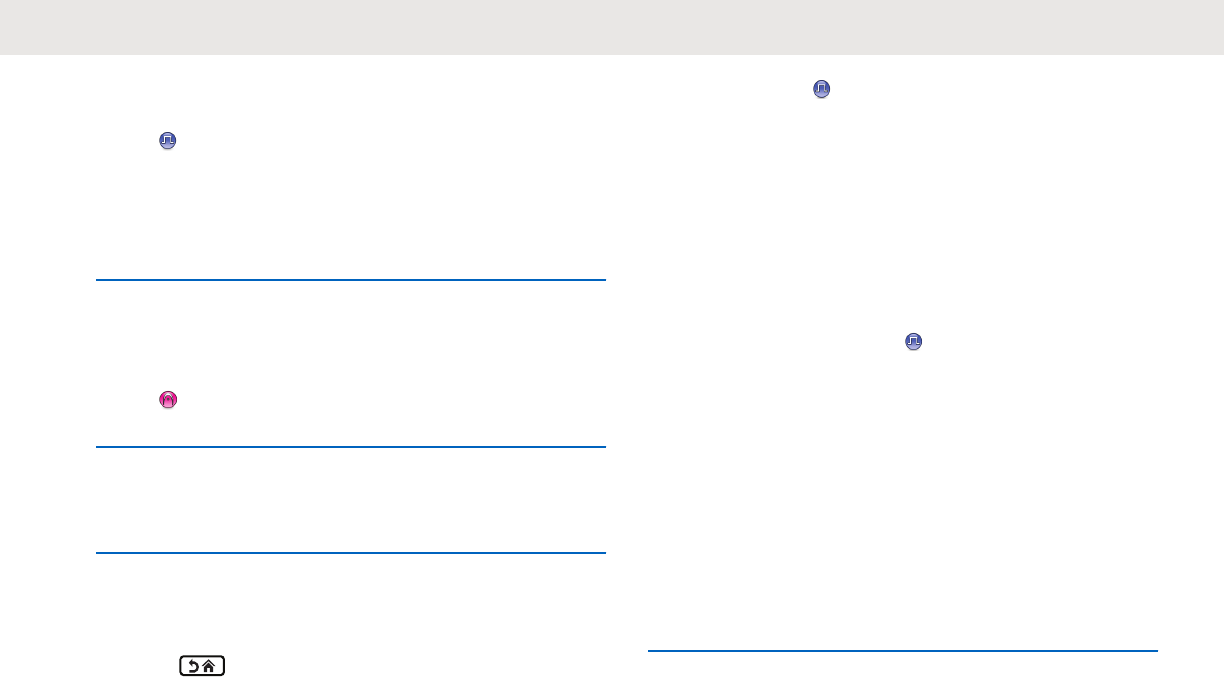
indicating the channel is free for you to respond.
Press the PTT button to respond to the call.
• If the Voice Interrupt feature is enabled, press
the PTT button to interrupt the audio from the
transmitting radio and free the channel for you to
respond.
The green LED lights up.
2Do one of the following:
• Wait for the Talk Permit Tone to end and speak
clearly into the microphone if enabled.
• Wait for the PTT Sidetone to end and speak
clearly into the microphone if enabled.
3Release the PTT button to listen.
The call ends when there is no voice activity for a
predetermined period.
If the radio receives a Group Call while not on the Home
screen, it remains on its current screen prior to answering
the call.
Long press to return to the Home screen to view the
caller alias before replying.
Private Calls
A Private Call is a call from an individual radio to another
individual radio.
There are two ways to set up a Private Call. The first type
sets up the call after performing a radio presence check,
while the second type sets up the call immediately. Only
one of these types can be programmed to your radio by
your dealer.
Making Private Calls
Your radio must be programmed to initiate a Private Call. If
this feature is not enabled, a negative indicator tone
sounds when you initiate the call. Follow the procedure to
make Private Calls on your radio.
1Do one of the following:
• Select a channel with the active subscriber alias
or ID.
• Press the programmed One Touch Access
button.
2Press the PTT button to make the call.
English
Send Feedback 47
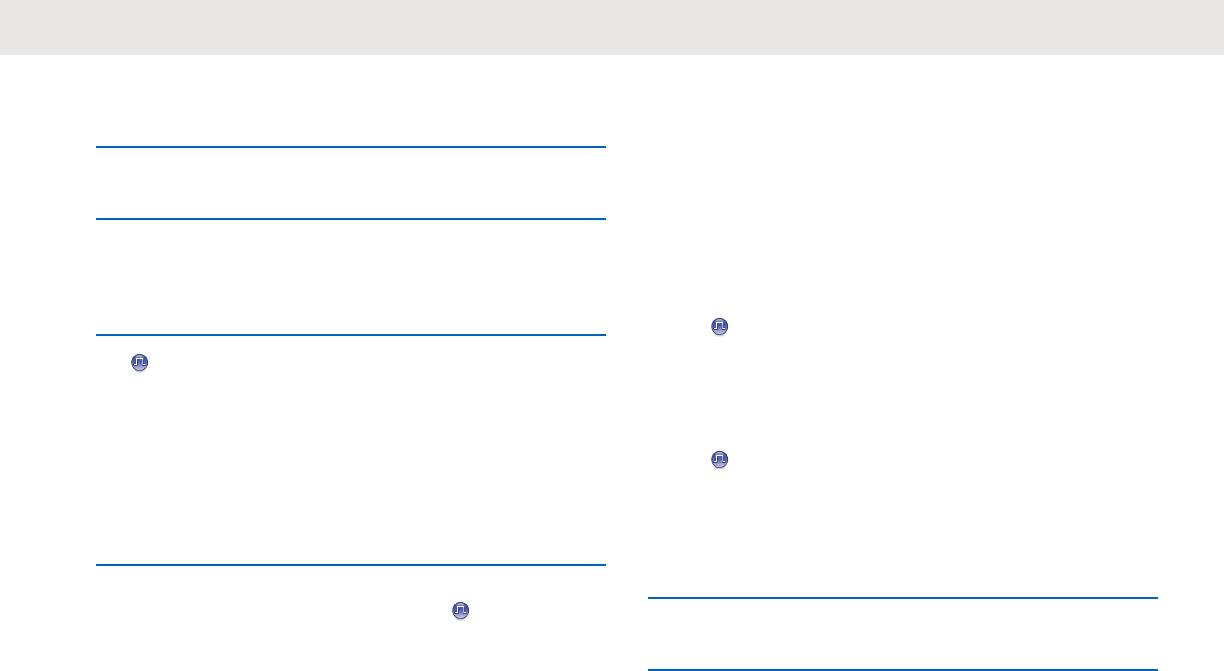
The green LED lights up. The display shows the
Private Call icon and alias.
3Wait for the Talk Permit Tone to end and speak
clearly into the microphone if enabled.
4Release the PTT button to listen.
The green LED blinks when the target radio
responds.
5 If the Channel Free Indication feature is enabled,
you hear a short alert tone the moment the
transmitting radio releases the PTT button, indicating
the channel is free for you to respond. Press the PTT
button to respond to the call.
The call ends when there is no voice activity for a
predetermined period. The display shows Call
Ended.
Responding to Private Calls
Follow the procedure to respond to Private Calls on your
radio.
When you receive a Private Call:
• The green LED blinks.
• The first text line shows the Private Call icon.
• The second text line displays the Private Call alias.
• Your radio unmutes and the incoming call sounds
through the speaker.
1Do one of the following:
• If the Channel Free Indication feature is
enabled, you hear a short alert tone the moment
the transmitting radio releases the PTT button,
indicating the channel is free for you to respond.
Press the PTT button to respond to the call.
• If the Transmit Interrupt Remote Dekey feature
is enabled, press the PTT button to stop an
ongoing interruptible call and free the channel for
you to respond.
The green LED lights up.
2Wait for the Talk Permit Tone to end and speak
clearly into the microphone if enabled.
3Release the PTT button to listen.
English
48 Send Feedback

The call ends when there is no voice activity for a
predetermined period.The display shows Call
Ended.
All Calls
An All Call is a call from an individual radio to every radio
on the channel. An All Call is used to make important
announcements, requiring full attention from the user. The
users on the channel cannot respond to an All Call.
Making All Calls
Your radio must be programmed for you to make an All
Call. Follow the procedure to make All Calls on your radio.
1Select a channel with the active All Call group alias
or ID.
2Press the PTT button to make the call.
The green LED lights up.The display shows the All
Call icon and All Call.
3Do one of the following:
• Wait for the Talk Permit Tone to end and speak
clearly into the microphone if enabled.
• Wait for the PTT Sidetone to end and speak
clearly into the microphone if enabled.
Users on the channel cannot respond to an All Call.
Receiving All Calls
When you receive an All Call:
• A tone sounds.
• The green LED blinks.
• The display shows the caller ID information at the top
right corner.
• The first text line shows the Group Call icon and All
Call.
• Your radio unmutes and the incoming call sounds
through the speaker.
The radio returns to the screen before receiving the All Call
when the call ends.
An All Call does not wait for a predetermined period before
ending.
English
Send Feedback 49

If the Channel Free Indication feature is enabled, you
hear a short alert tone when the transmitting radio releases
the PTT button, indicating the channel is free for you to
use.
You cannot respond to an All Call.
NOTICE:
The radio stops receiving the All Call if you switch to
a different channel while receiving the call.
Selective Calls
A Selective Call is a call from an individual radio to another
individual radio. It is a Private Call on an analog system.
Making Selective Calls
Your radio must be programmed for you to initiate a
Selective Call. Follow the procedure to make Selective
Calls on your radio.
1Select a channel with the active subscriber alias or
ID.
2Press the PTT button to make the call.
The green LED lights up. The display shows the
Private Call icon, the subscriber alias, and call
status.
3Do one of the following:
• Wait for the Talk Permit Tone to end and speak
clearly into the microphone if enabled.
• Wait for the PTT Sidetone to end and speak
clearly into the microphone if enabled.
4Release the PTT button to listen.
The green LED lights up when the target radio
responds.
5 If the Channel Free Indication feature is enabled,
you hear a short alert tone the moment the
transmitting radio releases the PTT button, indicating
the channel is free for you to respond. Press the PTT
button to respond to the call.
The call ends when there is no voice activity for a
predetermined period.
English
50 Send Feedback
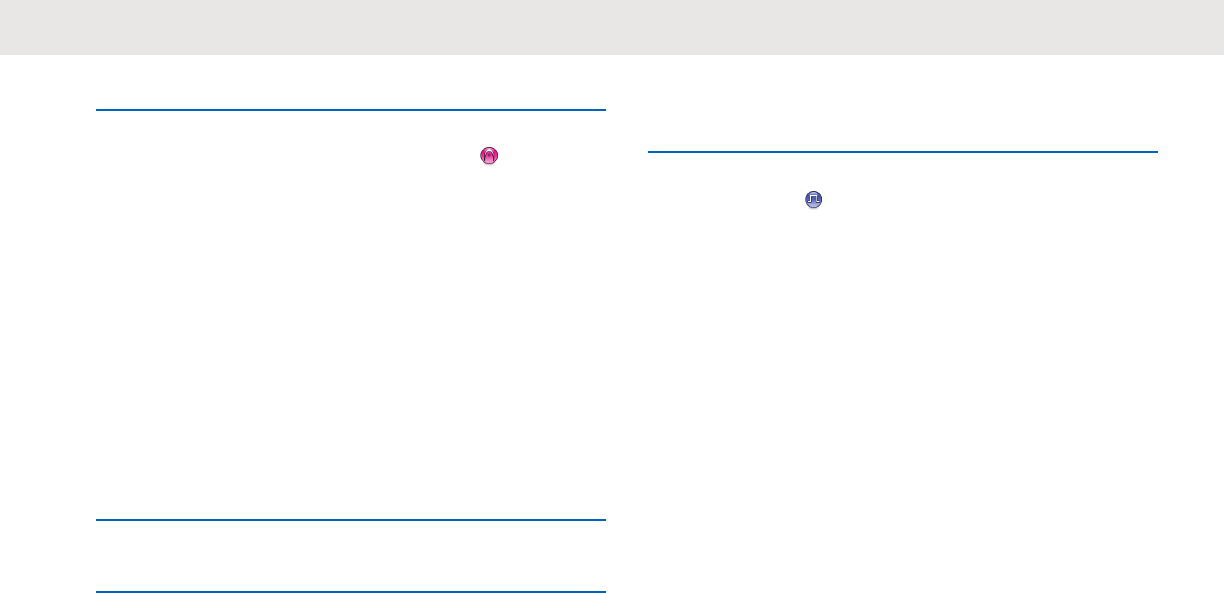
6The display shows Call Ended.
Responding to Selective Calls
Follow the procedure to respond to Selective Calls on your
radio.
When you receive a Selective Call:
• The green LED blinks.
• The first text line shows the Private Call icon and the
caller alias or Selective Call or Alert with Call.
• Your radio unmutes and the incoming call sounds
through the speaker.
1Press the PTT button to respond to the call.
The green LED lights up.
2Wait for the Talk Permit Tone to end and speak
clearly into the microphone if enabled.
3Release the PTT button to listen.
The call ends when there is no voice activity for a
predetermined period. A tone sounds. The display
shows Call Ended.
Phone Calls
A Phone Call is a call from an individual radio to a
telephone.
If Phone Call capability is not enabled in your radio:
• The display shows Unavailable.
• Your radio mutes the call.
• Your radio returns to the previous screen when the call
ends.
During the Phone Call, your radio attempts to end the call
when:
• You press the One Touch Access button with the
deaccess code preconfigured.
• You enter the deaccess code as the input for extra
digits.
During channel access, access or deaccess code, or extra
digits transmission, your radio responds to the On/Off
button, Volume button, and the Channel Rocker only. A
tone sounds for every invalid input.
English
Send Feedback 51
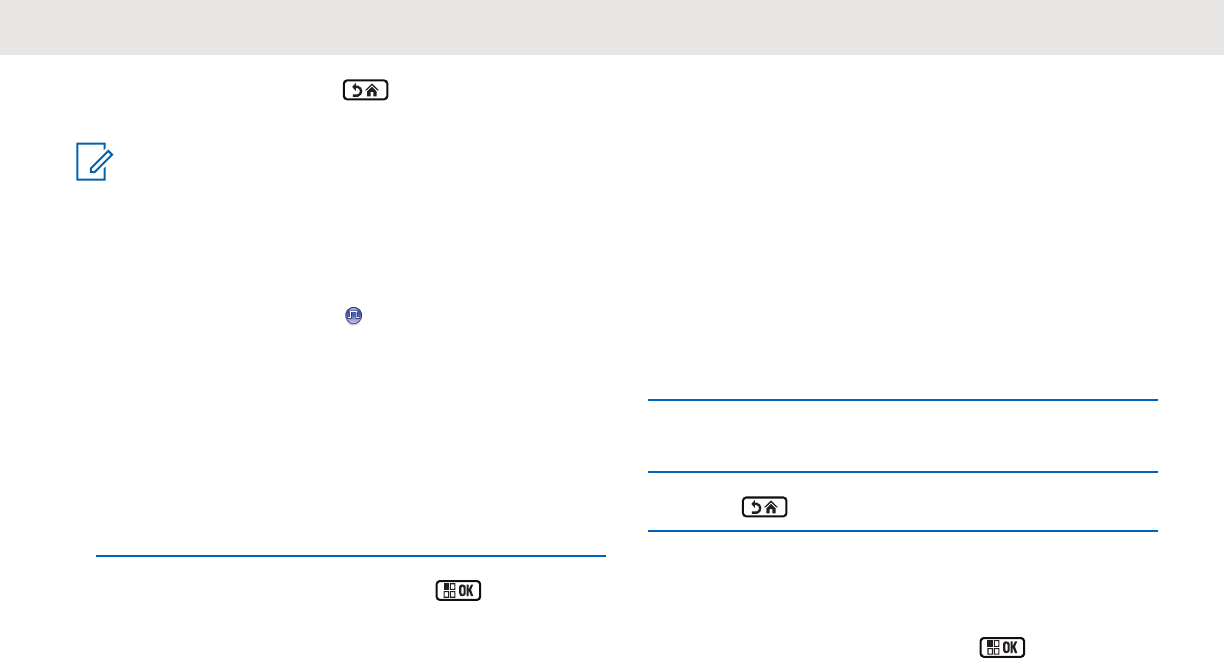
During channel access, press to dismiss the call
attempt. A tone sounds.
NOTICE:
The access or deaccess code cannot be more than
10 characters.
Check with your dealer or system administrator for
more information.
Making Phone Calls
Follow the procedure to make Phone Calls on your radio.
1Press the programmed One Touch Access button
to the predefined alias or ID.
If the entry for the One Touch Access button is
empty, a negative indicator tone sounds. If the
access code is not preconfigured in the Contact List,
the display shows Access Code:.
2Enter the access code, and press to proceed.
The green LED lights up. The display shows the
Phone Call icon at the top right corner. The first text
line shows the subscriber alias. The second text line
shows the call status.
If the call is successful:
• The DTMF Tone sounds.
• You hear the dialing tone of the telephone user.
If the call is unsuccessful:
• A tone sounds.
• The display shows Phone Call Failed and
then, Access Code:.
• If the access code has been preconfigured in the
Contacts list, your radio returns to the screen you
were on before initiating the call.
3Press the PTT button to respond to the call. Release
the PTT button to listen.
4Press to end the call.
5Do one of the following:
• If the deaccess code was not preconfigured,
enter the deaccess code when the display shows
De-Access Code:, and press to proceed.
The radio returns to the previous screen.
English
52 Send Feedback
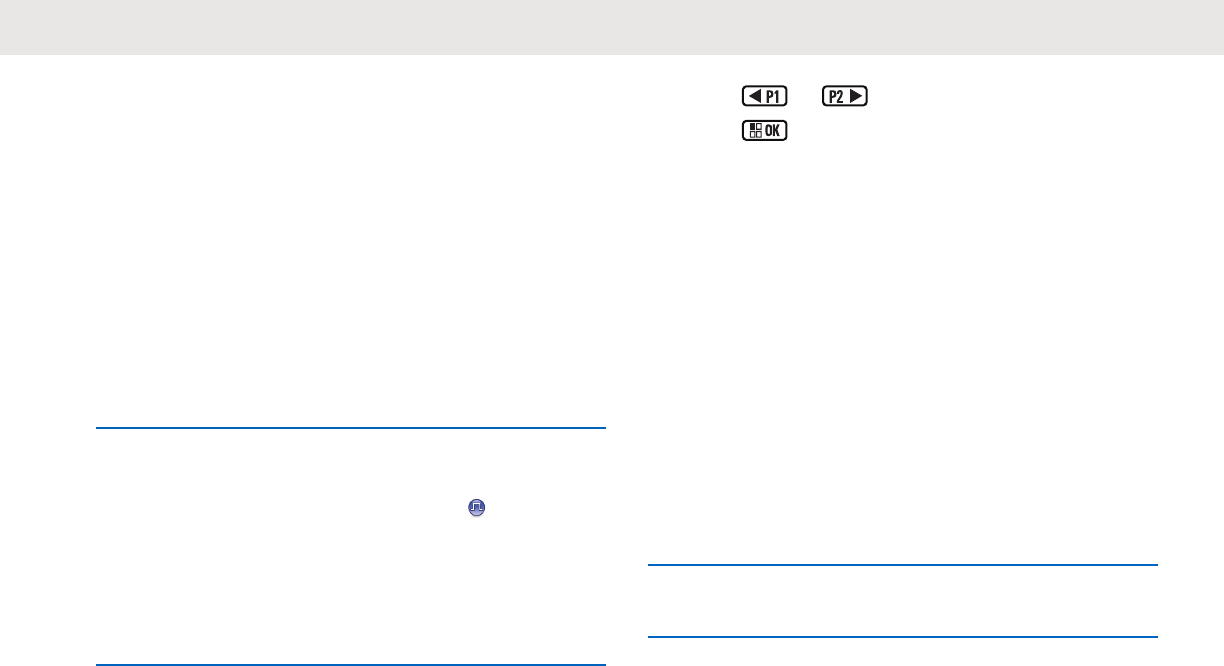
• Press the programmed One Touch Access
button.
If the entry for the One Touch Access button is
empty, a negative indicator tone sounds.
The DTMF Tone sounds and the display shows
Ending Phone Call.
If the call ends successfully:
• A tone sounds.
• The display shows Call Ended.
If the call fails to end, the radio returns to the Phone
Call screen. Repeat the last two steps or wait for the
telephone user to end the call.
Making Phone Calls with the
Programmable Phone Button
Follow the procedure to make a phone call with the
programmable phone button.
1Press the programmed Phone button to enter into
the Phone Entry list.
2Press or to the required alias or ID.
Press to select.
• The green LED lights up. The Phone Call icon
appears in the top right corner. The first text line
shows the subscriber alias. The second text line
displays the call status.
• If the call-setup is successful, the Dual Tone Multi
Frequency (DTMF) tone sounds. You hear the
dialing tone of the telephone user. The first text
line shows the subscriber alias. The Phone Call
icon remains in the top right corner.
• If call-setup is unsuccessful, a tone sounds and
the display shows Phone Call Failed. Your
radio returns to the Access Code input screen. If
the access code was preconfigured in the
Contacts list, the radio returns to the screen you
were on prior to initiating the call.
3Press the PTT button to talk. Release the PTT
button to listen.
4To enter extra digits, if requested by the Phone Call:
English
Send Feedback 53

• Press One Touch Access button. If the entry for
the One Touch Access button is empty, a
negative indicator tone sounds.
5Press to end the call.
• The display shows Ending Phone Call.
• If the end-call-setup is successful, a tone sounds
and the display shows Call Ended.
• If the end-call-setup is unsuccessful, your radio
returns to the Phone Call screen. Repeat step 5
or wait for the telephone user to end the call.
• When you press PTT button while in the Phone
Contacts screen, a tone sounds and the display
shows Press OK to Place Phone Call.
• When the telephone user ends the call, a tone
sounds and the display shows Phone Call
Ended.
• If the call ends while you are entering the extra
digits requested by the Phone Call, your radio
returns to the screen you were on prior to
initiating the call.
NOTICE:
During channel access, press to
dismiss the call attempt and a tone sounds.
During the call, when you press One Touch
Access button with the deaccess code
preconfigured or enter the deaccess code as
the input for extra digits, your radio attempts
to end the call.
Responding to Phone Calls as Group
Calls
Follow the procedure to respond to Phone Calls as Group
Calls on your radio.
When you receive a Phone Call as a Group Call:
• The display shows the Phone Call icon at the top right
corner.
• The display shows the group alias and Phone Call.
If Phone Call capability is not enabled on your radio, the
first line of the display shows Unavailable and your radio
English
54 Send Feedback
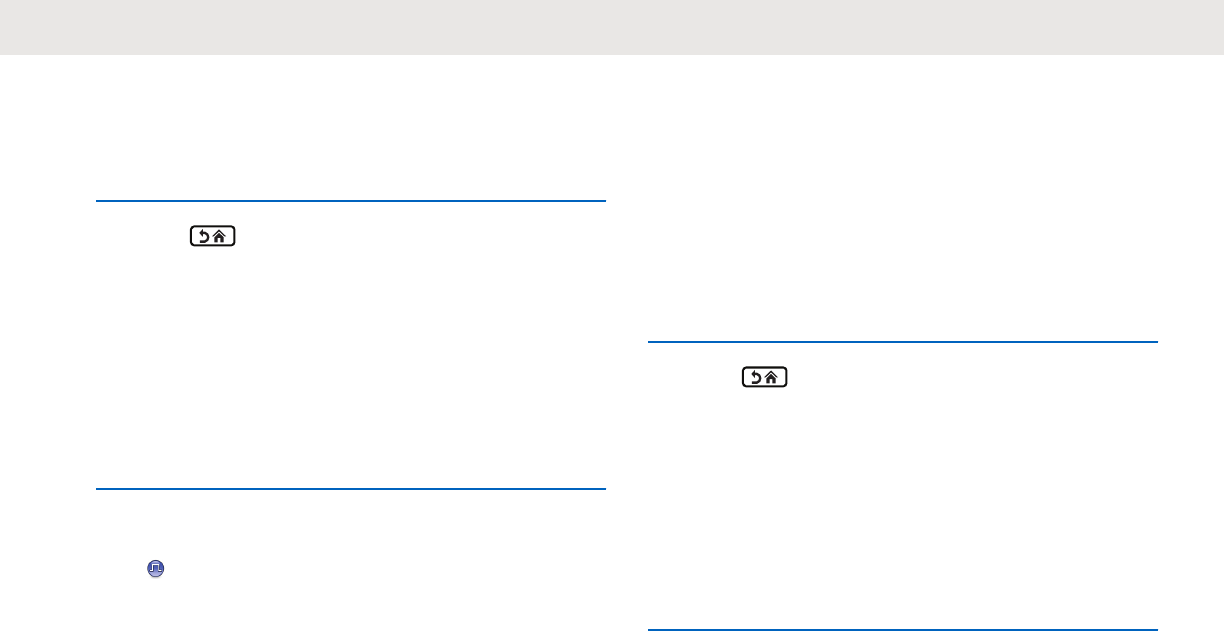
mutes the call. Your radio returns to the previous screen
when the call ends.
1Press the PTT button to respond to the call. Release
the PTT button to listen.
2Press to end the call.
The display shows Ending Phone Call.
If the call ends successfully:
• A tone sounds.
• The display shows Call Ended.
If the call fails to end, the radio returns to the Phone
Call screen. Repeat this step or wait for the
telephone user to end the call.
Responding to Phone Calls as Private
Calls
Follow the procedure to respond to Phone Calls as Private
Calls on your radio.
When you receive a Phone Call as a Private Call:
• The display shows the Phone Call icon at the top right
corner.
• The display shows the caller alias or Phone Call.
If Phone Call capability is not enabled on your radio, the
first line of the display shows Unavailable and your radio
mutes the call. Your radio returns to the previous screen
when the call ends.
1Press the PTT button to respond to the call. Release
the PTT button to listen.
2Press to end the call.
The display shows Ending Phone Call.
If the call ends successfully:
• A tone sounds.
• The display shows Call Ended.
If the call fails to end, the radio returns to the Phone
Call screen. Repeat this step or wait for the
telephone user to end the call.
English
Send Feedback 55

Responding to Phone Calls as All Calls
When you receive a Phone Call as an All Call, you can
respond to or end the call, only if an All Call type is
assigned to the channel. Follow the procedure to respond
to Phone Calls as All Calls on your radio.
When you receive a Phone Call as an All Call:
• The display shows the Phone Call icon at the top right
corner.
• The display shows All Call and Phone Call.
If Phone Call capability is not enabled on your radio, the
first line of the display shows Unavailable and your radio
mutes the call.
Your radio returns to the previous screen when the call
ends.
1Press the PTT button to respond to the call.
2Release the PTT button to listen.
3Press to end the call.
The display shows Ending Phone Call.
If the call ends successfully:
• A tone sounds.
• The display shows All Call and Call Ended.
If the call fails to end, the radio returns to the Phone
Call screen. Repeat step 3 or wait for the telephone
user to end the call.
Stopping Radio Calls
This feature allows you to stop an ongoing Group or Private
Call to free the channel for transmission. For example,
when a radio experiences a "stuck microphone" condition
where the PTT button is inadvertently pressed by the user.
Your radio must be programmed to allow you to use this
feature. Follow the procedure to stop calls on your radio.
1Press the programmed Transmit Interrupt Remote
Dekey button.
2Wait for acknowledgment.
If successful:
• A positive indicator tone sounds.
If unsuccessful:
English
56 Send Feedback

• A negative indicator tone sounds.
• The display shows Remote Dekey Failed.
If an interruptible call is stopped via this feature:
• The display shows Call Interrupted.
• A negative indicator tone sounds on the
interrupted radio until the PTT button is released.
NOTICE:
Check with your dealer or system administrator for
more information.
English
Send Feedback 57

English
This page intentionally left blank.
58
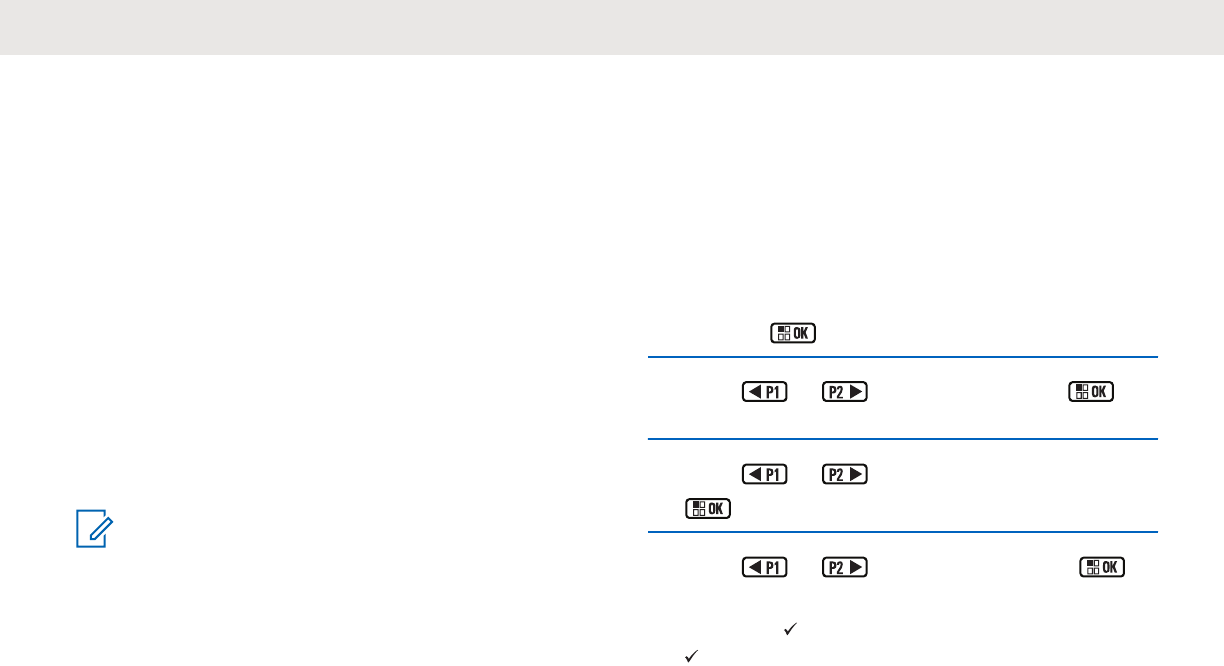
Advanced Features
This chapter explains the operations of the features
available in your radio.
Your dealer or system administrator may have customized
your radio for your specific needs. Check with your dealer
or system administrator for more information.
Talkaround
This feature allows you to continue communication when
your repeater is not operational, or when your radio is out
of range from the repeater but within talking range of other
radios.
The talkaround setting is retained even after powering
down.
NOTICE:
This feature is not applicable in Capacity Plus–
Single-Site, Capacity Plus–Multi-Site, and Citizens
Band channels that are in the same frequency.
Toggling Between Repeater and
Talkaround Modes
Follow the procedure to toggle between Repeater and
Talkaround modes on your radio.
1Do one of the following:
• Press the programmed Repeater/Talkaround
button. Skip the following steps.
• Press to access the menu.
2Press or to Utilities. Press to
select.
3Press or to Radio Settings. Press
to select.
4Press or to Talkaround. Press to
select.
If enabled, appears besides Enabled. If disabled,
disappears beside Enabled.
English
Send Feedback 59

The screen automatically returns to the previous
screen.
Monitor Feature
The monitor feature is used to make sure that a channel is
free before transmitting.
Monitoring Channels
Follow the procedure to monitor channels.
1Long press the programmed Monitor button.
The Monitor icon appears on the display and the
LED lights up solid yellow.
If there is activity on the monitored channel:
If the monitored channel is free, you hear a “white
noise".
2Press the PTT button to talk. Release the PTT
button to listen.
Permanent Monitor
The Permanent Monitor feature is used to continuously
monitor a selected channel for activity.
Turning Permanent Monitor On or Off
Follow the procedure to turn Permanent Monitor on or off
on your radio.
Press the programmed Permanent Monitor button.
When the radio enters the mode:
• An alert tone sounds.
• The yellow LED lights up.
• The display shows Permanent Monitor On and
the Monitor icon.
When the radio exits the mode:
• An alert tone sounds.
• The yellow LED turns off.
• The display shows Permanent Monitor Off.
English
60 Send Feedback

Home Channel Reminder
This feature provides a reminder when the radio is not set
to the home channel for a period of time.
If this feature is enabled through CPS, when your radio is
not set to the home channel for a period of time, the
following occurs periodically:
• The Home Channel Reminder tone and announcement
sound.
• The first line of the display shows Non.
• The second line shows Home Channel.
You can respond to the reminder by performing one of the
following actions:
• Return to the home channel.
• Mute the reminder temporarily using the programmable
button.
• Set a new home channel using the programmable
button.
Muting the Home Channel Reminder
When the Home Channel Reminder sounds, you can
temporarily mute the reminder.
Press the Silence Home Channel Reminder
programmable button.
The first line of the display shows HCR and the
second line shows Silenced.
Setting New Home Channels
When the Home Channel Reminder occurs, you can set a
new home channel.
1Do one of the following:
• Press the Reset Home Channel programmable
button to set the current channel as the new
Home Channel. Skip the following steps.
The first line of the display shows the channel
alias and the second line shows New Home Ch.
• Press to access the menu.
2Press or to Utilities. Press to
select.
English
Send Feedback 61
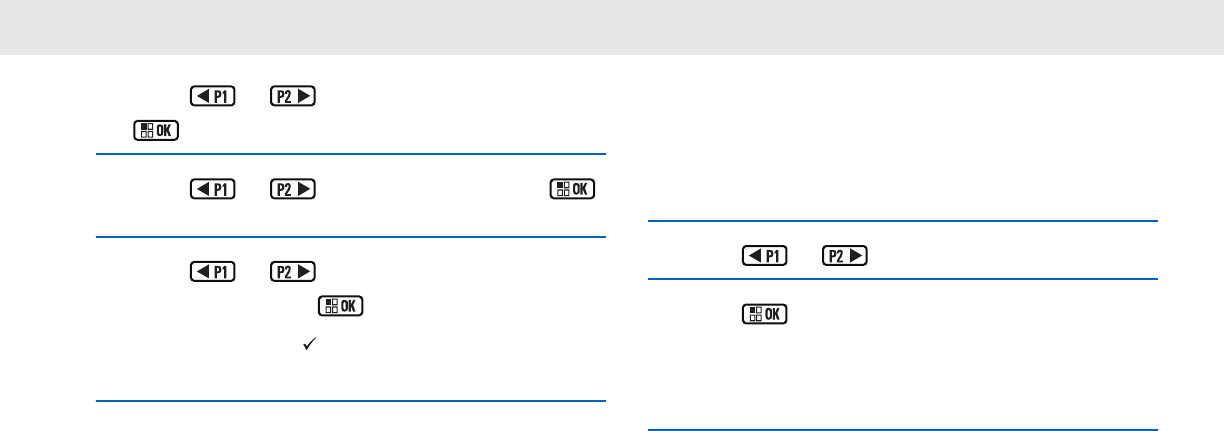
3Press or to Radio Settings. Press
to select.
4Press or to Home Channel. Press
to select.
5Press or to the desired new home
channel alias. Press to select.
The display shows beside the selected home
channel alias.
Remote Monitor
This feature is used to turn on the microphone of a target
radio with a subscriber alias or ID. You can use this feature
to remotely monitor any audible activity surrounding the
target radio.
Both your radio and the target radio must be programmed
to allow you to use this feature.
This feature stops after a programmed duration or when
there is any user operation on the target radio.
Initiating Remote Monitor
Follow the procedure to initiate Remote Monitor on your
radio.
1Press the programmed Remote Monitor button.
2Press or to the required alias or ID.
3Press to select.
The display shows a transitional mini notice,
indicating the request is in progress. The green LED
lights up.
4Wait for acknowledgment.
If successful:
• A positive indicator tone sounds.
• The display shows a positive mini notice.
• The audio from the monitored radio starts playing
for a programmed duration, and the display
shows Rem. Monitor. Once the timer expires, an
alert tone sounds, and the LED turns off.
If unsuccessful:
English
62 Send Feedback
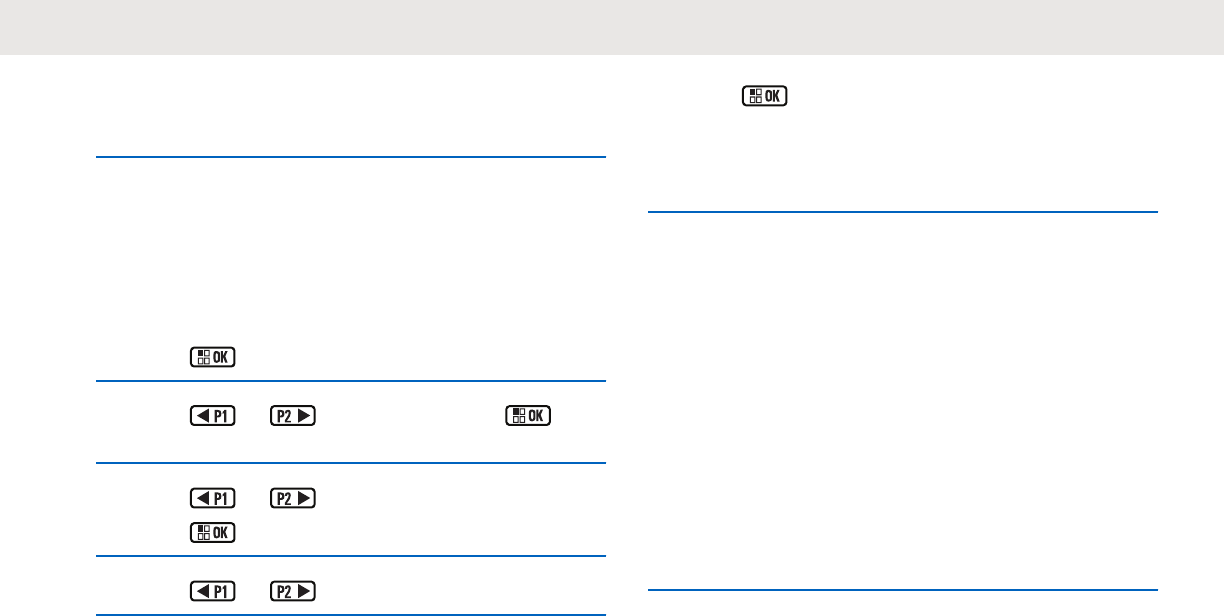
• A negative indicator tone sounds.
• The display shows a negative mini notice.
Initiating Remote Monitor by Using the
Contacts List
Follow the procedure to initiate Remote Monitor on your
radio by using the Contacts list.
1Press to access the menu.
2Press or to Contacts. Press to
select.
3Press or to the required alias or ID.
Press to select.
4Press or to Remote Mon..
5Press to select.
The display shows a transitional mini notice,
indicating the request is in progress. The green LED
lights up.
6Wait for acknowledgment.
If successful:
• A positive indicator tone sounds.
• The display shows a positive mini notice.
• The audio from the monitored radio starts playing
for a programmed duration, and the display
shows Rem. Monitor. Once the timer expires, an
alert tone sounds, and the LED turns off.
If unsuccessful:
• A negative indicator tone sounds.
• The display shows a negative mini notice.
English
Send Feedback 63
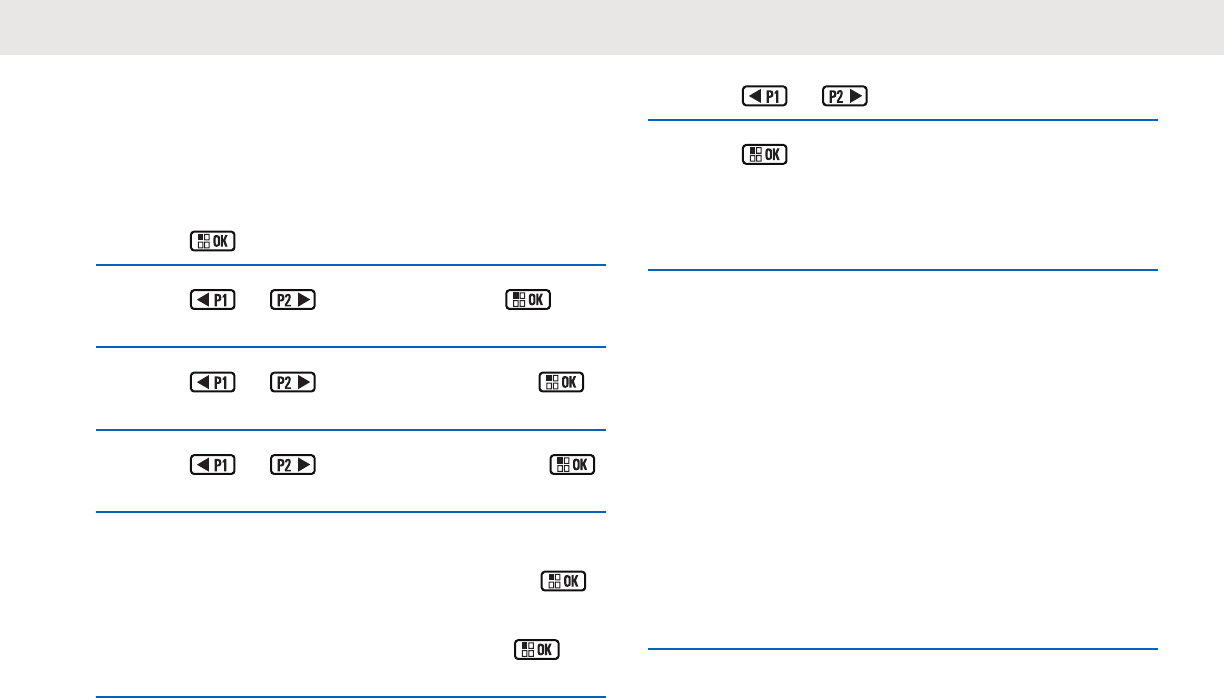
Initiating Remote Monitor by Using the
Manual Dial
Follow the procedure to initiate Remote Monitor on your
radio by using the manual dial.
1Press to access the menu.
2Press or to Contacts. Press to
select.
3Press or to Manual Dial. Press
to select.
4Press or to Radio Number. Press
to select.
5Do one of the following:
• Enter the subscriber alias or ID, and press
to proceed.
• Edit the previously dialed ID, and press to
proceed.
6Press or to Remote Mon..
7Press to select.
The display shows a transitional mini notice,
indicating the request is in progress. The green LED
lights up.
8Wait for acknowledgment.
If successful:
• A positive indicator tone sounds.
• The display shows a positive mini notice.
• The audio from the monitored radio starts playing
for a programmed duration, and the display
shows Rem. Monitor. Once the timer expires, an
alert tone sounds, and the LED turns off.
If unsuccessful:
• A negative indicator tone sounds.
• The display shows a negative mini notice.
English
64 Send Feedback
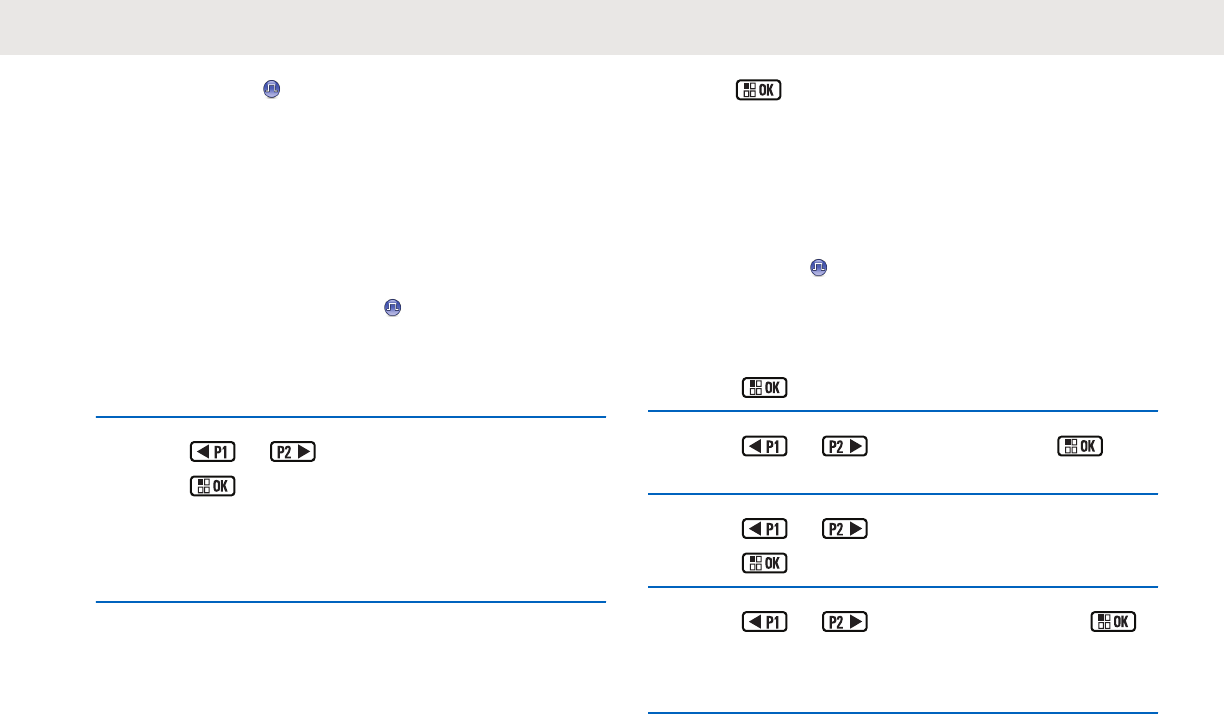
Radio Check
This feature allows you to determine if another radio is
active in a system without disturbing the radio user. No
audible or visual notification is shown on the target radio.
This feature is only applicable for subscriber aliases or IDs.
Your radio must be programmed to allow you to use this
feature.
Sending Radio Checks
Follow the procedure to send radio checks on your radio.
1Press the programmed Radio Check button.
2Press or to the required alias or ID.
Press to select.
The display shows a transitional mini notice,
indicating the request is in progress.The green LED
lights up.
Wait for acknowledgment.
If you press when the radio is waiting for
acknowledgment, a tone sounds, the radio terminates all
retries, and exits Radio Check mode.
The radio returns to the subscriber alias or ID screen.
Sending Radio Checks by Using the
Contacts List
Follow the procedure to send radio checks on your radio by
using the Contacts list.
1Press to access the menu.
2Press or to Contacts. Press to
select.
3Press or to the required alias or ID.
Press to select.
4Press or to Radio Check. Press
to select.
The green LED lights up.
English
Send Feedback 65
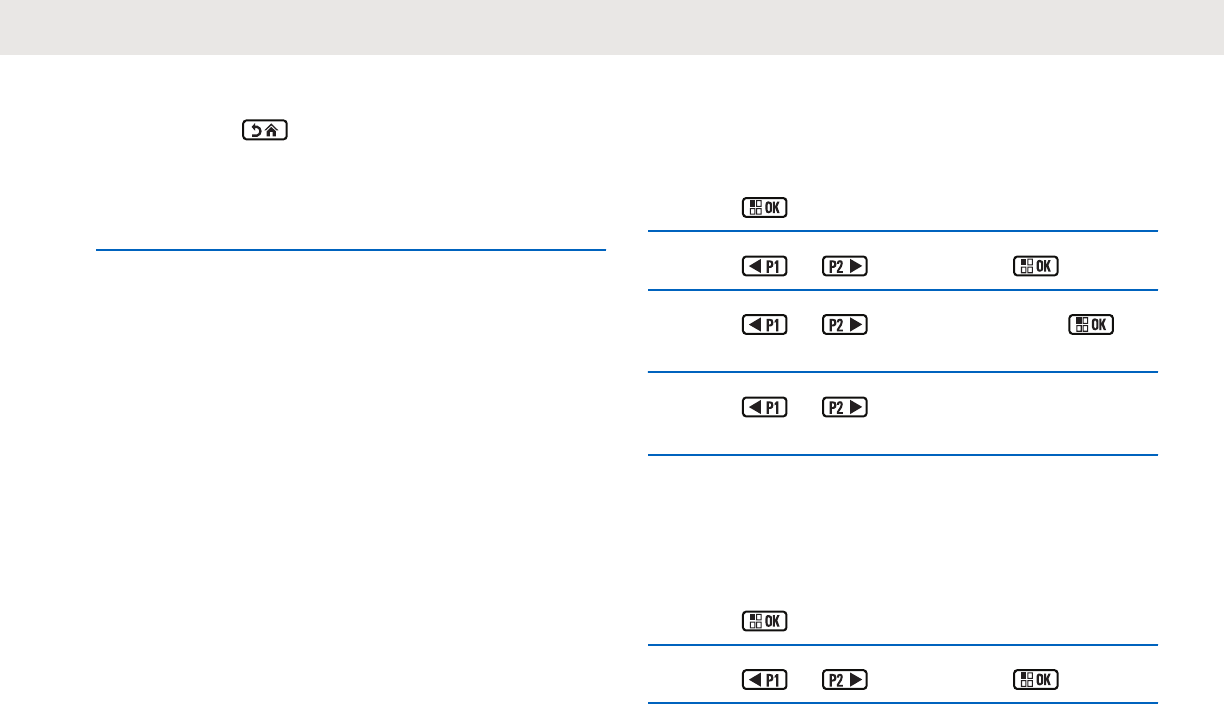
5Wait for acknowledgment.
If you press when the radio is waiting for
acknowledgement, a tone sounds, the radio
terminates all retries, and exits Radio Check mode.
The radio returns to the subscriber alias or ID
screen.
Scan Lists
Scan lists are created and assigned to individual channels
or groups. Your radio scans for voice activity by cycling
through the channel or group sequence specified in the
scan list for the current channel or group.
Your radio can support up to 250 scan lists, with a
maximum of 16 members in a list. Each scan list supports a
mixture of both analog and digital entries.
You can add, delete, or prioritize channels by editing a
scan list.
The Priority icon appears on the left of the member alias, if
set, to indicate whether the member is on a Priority 1 or
Priority 2 channel list. You cannot have multiple Priority 1
or Priority 2 channels in a scan list. There is no Priority
icon if priority is set to None.
Viewing Entries in the Scan List
Follow the procedure to view the entries in the Scan list on
your radio.
1Press to access the menu.
2Press or to Scan. Press to select.
3Press or to Scan List. Press to
select.
4Press or to view each member on the
list.
Adding New Entries to the Scan List
Follow the procedure to add new entries to the Scan list on
your radio.
1Press to access the menu.
2Press or to Scan. Press to select.
English
66 Send Feedback
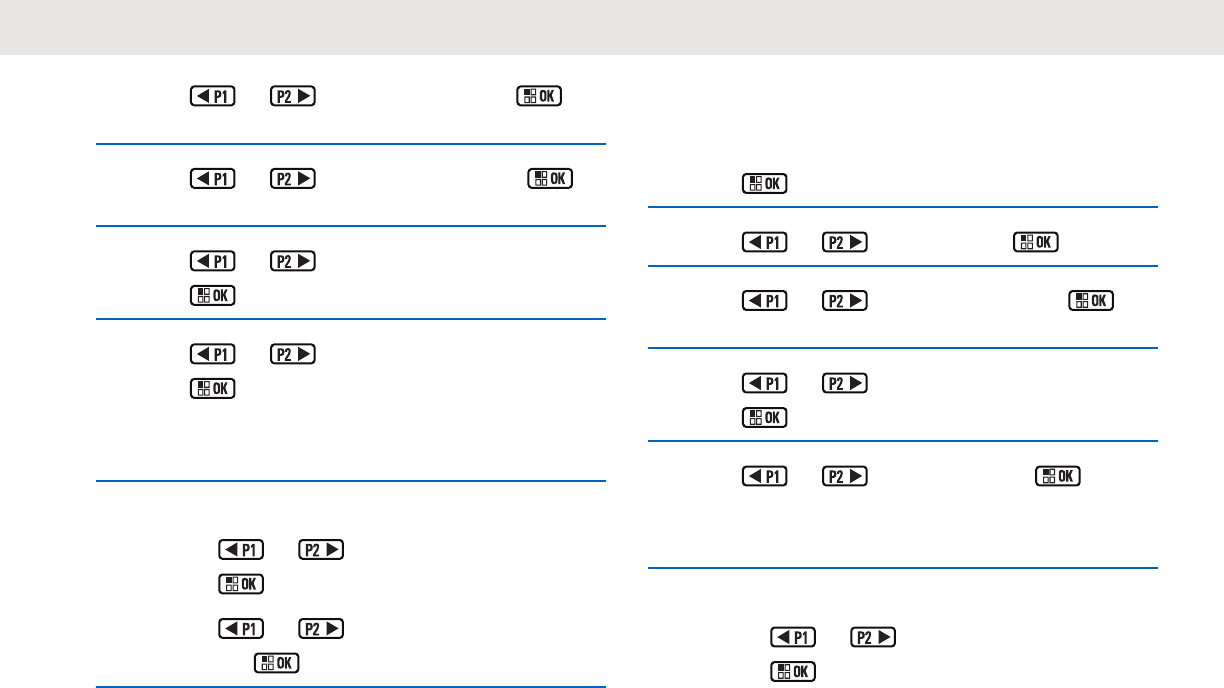
3Press or to Scan List. Press to
select.
4Press or to Add Member. Press to
select.
5Press or to the required alias or ID.
Press to select.
6Press or to the required priority level.
Press to select.
The display shows a positive mini notice and then,
Add Another?.
7Do one of the following:
• Press or to Yes to add another entry.
Press to select. Repeat step 5 and step 6.
• Press or to No to save the current
list. Press to select.
Deleting Entries from the Scan List
Follow the procedure to delete entries from the Scan list.
1Press to access the menu.
2Press or to Scan. Press to select.
3Press or to Scan List. Press to
select.
4Press or to the required alias or ID.
Press to select.
5Press or to Delete. Press to
select.
The display shows Delete Entry?.
6Do one of the following:
• Press or to Yes to delete the entry.
Press to select.
The display shows a positive mini notice.
English
Send Feedback 67
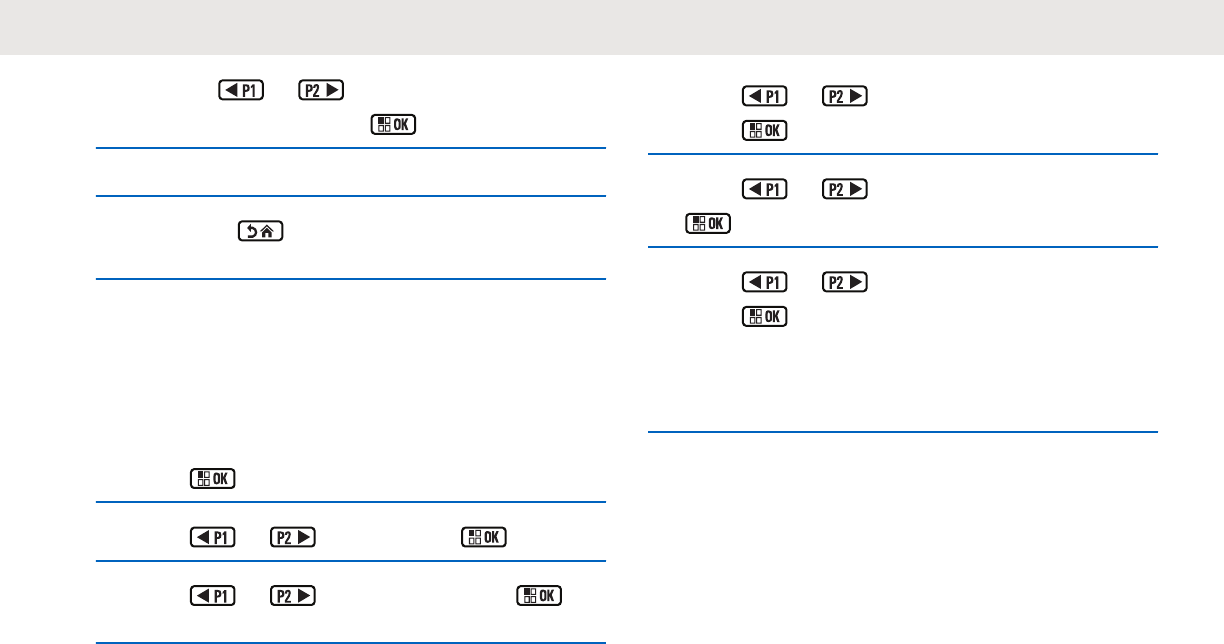
• Press or to No to return to the
previous screen. Press to select.
7Repeat step 4 to step 6 to delete other entries.
8Long press to return to the Home screen after
deleting all required aliases or IDs.
Setting Priority for Entries in the Scan
List
Follow the procedure to set priorities for entries in the Scan
list on your radio.
1Press to access the menu.
2Press or to Scan. Press to select.
3Press or to Scan List. Press to
select.
4Press or to the required alias or ID.
Press to select.
5Press or to Edit Priority. Press
to select.
6Press or to the required priority level.
Press to select.
The display shows a positive mini notice before
returning to the previous screen. The Priority icon
appears on the left of the member alias.
Scan
Your radio cycles through the programmed scan list for the
current channel looking for voice activity when you start a
scan.
There are two ways of initiating scan:
•Main Channel Scan (Manual) : Your radio scans all the
channels or groups in your scan list. On entering scan,
your radio may, depending on the settings,
English
68 Send Feedback
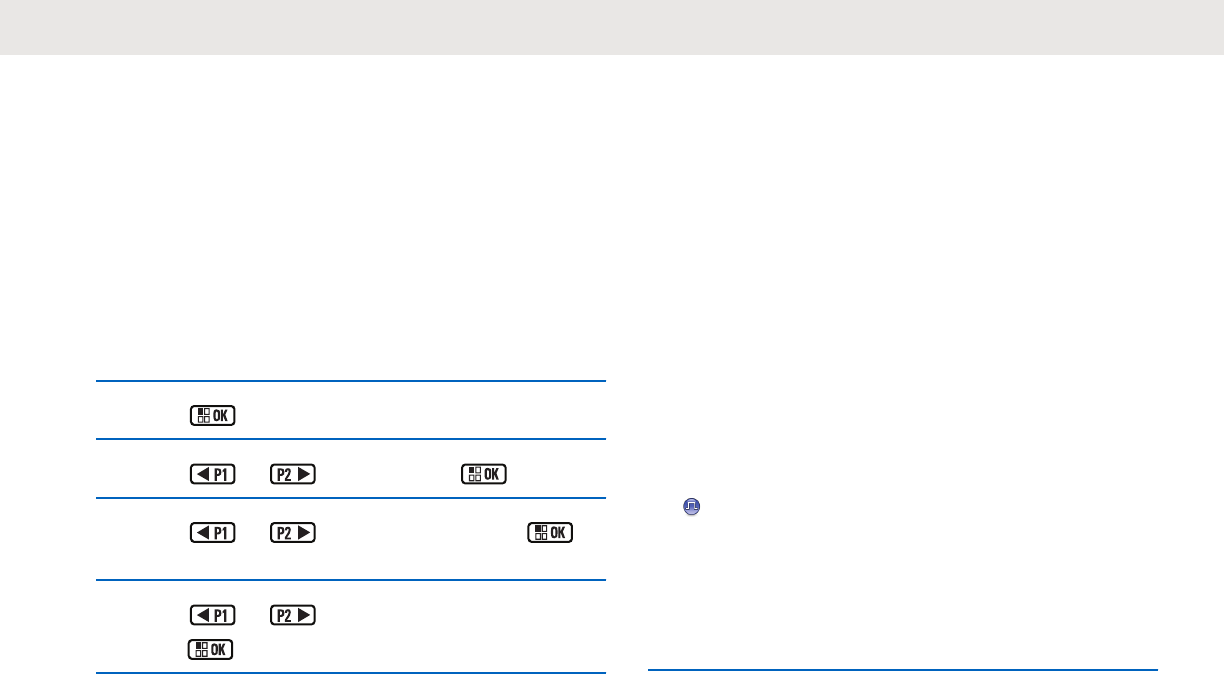
automatically start on the last scanned active channel or
group, or on the channel where scan was initiated.
•Auto Scan (Automatic) : Your radio automatically
starts scanning when you select a channel or group that
has Auto Scan enabled.
Turning Scan On or Off
Follow the procedure to turn scan on or off on your radio.
1Push the Channel Rocker to select a channel
programmed with Auto Scan enabled.
2Press to access the menu.
3Press or to Scan. Press to select.
4Press or to Scan State. Press to
select.
5Press or to the required scan state and
press to select.
If scan is enabled:
• The display shows Scan On and Scan icon.
• The yellow LED blinks.
If scan is disabled:
• The display shows Scan Off.
• The Scan icon disappears.
• The LED turns off.
Responding to Transmissions During
Scanning
During scanning, your radio stops on a channel or group
where activity is detected. The radio stays on that channel
for a programmed duration known as hang time. Follow the
procedure to respond to transmissions during scanning.
1 If the Channel Free Indication feature is enabled,
you hear a short alert tone the moment the
transmitting radio releases the PTT button, indicating
the channel is free for you to respond. Press the PTT
button during hang time.
The green LED lights up.
2Do one of the following:
English
Send Feedback 69
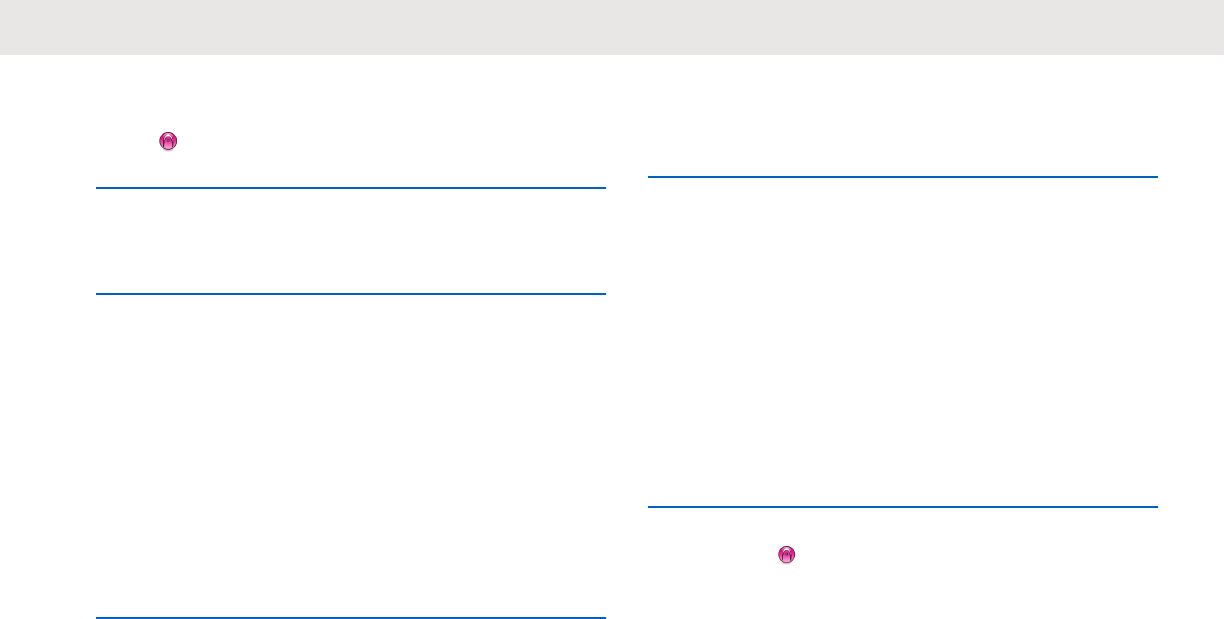
• Wait for the Talk Permit Tone to end and speak
clearly into the microphone if enabled.
• Wait for the PTT Sidetone to end and speak
clearly into the microphone if enabled.
3Release the PTT button to listen.
The radio returns to scanning other channels or
groups if you do not respond within the hang time.
Deleting Nuisance Channels
If a channel continually generates unwanted calls or noise,
(termed a "nuisance" channel), you can temporarily remove
the unwanted channel from the scan list. This capability
does not apply to the channel designated as the Selected
Channel. Follow the procedure to delete nuisance channels
on your radio.
1When your radio locks on to an unwanted or
nuisance channel, press the programmed Nuisance
Channel Delete button until you hear a tone.
2Release the programmed Nuisance Channel
Delete button.
The nuisance channel is deleted.
Restoring Nuisance Channels
Follow the procedure to restore nuisance channels on your
radio.
Do one of the following:
• Turn the radio off and then power it on again.
• Stop and restart a scan using the programmed
Scan button or menu.
• Change the channel using the Channel Rocker
button.
Vote Scan
Vote Scan provides you with wide area coverage in areas
where there are multiple base stations transmitting identical
information on different analog channels.
Your radio scans analog channels of multiple base stations
and performs a voting process to select the strongest
English
70 Send Feedback

received signal. Once that is established, your radio
receives transmissions from that base station.
During a vote scan, the yellow LED blinks and the display
shows the Vote Scan icon.
Follow the same procedures as Responding to
Transmissions During Scanning on page 69, to respond to
a transmission during a vote scan.
Contacts Settings
Contacts provides address book capabilities on your radio.
Each entry corresponds to an alias or ID that you use to
initiate a call. The entries are alphabetically sorted.
Each entry, depending on context, associates with the
different call types: Group Call, Private Call, All Call, PC
Call, or Dispatch Call.
PC Call and Dispatch Call are data-related. They are only
available with the applications. Refer to the data
applications documentation for further details.
Additionally, Contacts menu allows you to assign each
entry to a programmable number key or more on a keypad
microphone. If an entry is assigned to a number key, your
radio can perform a quick dial on the entry.
NOTICE:
You see a checkmark before each number key that
is assigned to an entry. If the checkmark is before
Empty, you have not assign a number key to the
entry.
Your radio supports two Contacts lists, each for Analog
contacts and Digital contacts, with a maximum of 500
members for each Contacts list.
Each entry within Contacts displays the following
information:
• Call Type
• Call Alias
• Call ID
English
Send Feedback 71
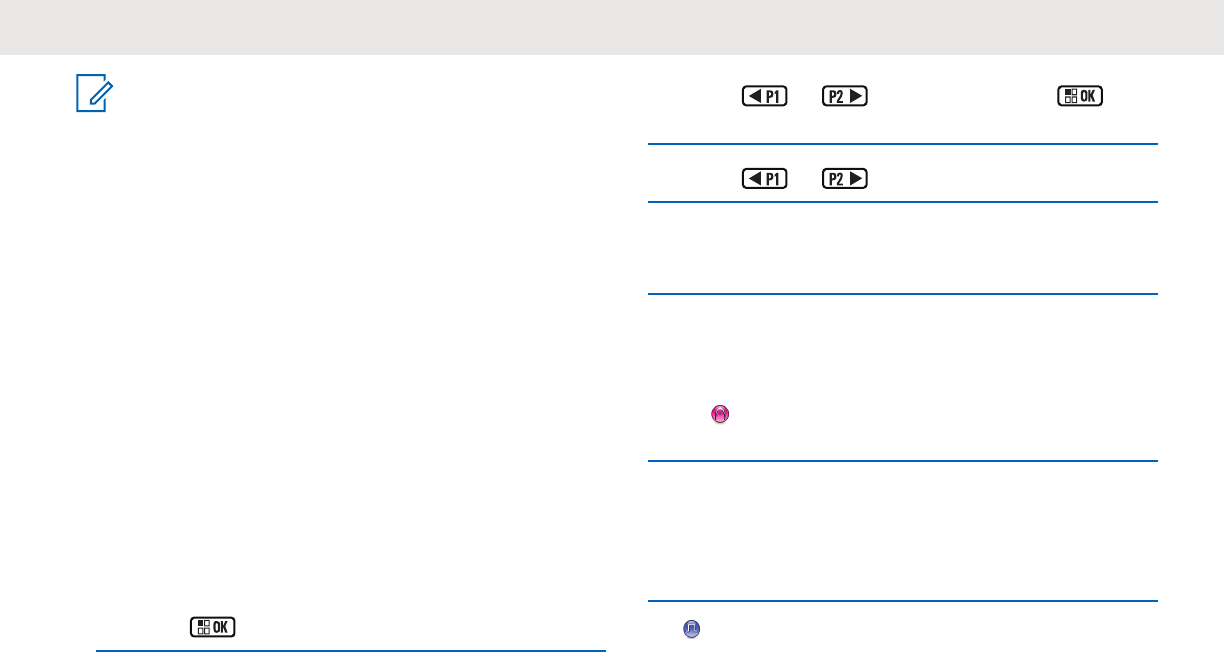
NOTICE:
You can add, or edit subscriber IDs for the Digital
Contacts list. Deleting subscriber IDs can only be
performed by your dealer.
You can only view the subscriber IDs, edit the
subscriber IDs, and initiate a Call Alert for the
Analog Contacts list. Adding and deleting
capabilities can only be performed by your dealer.
If the Privacy feature is enabled on a channel, you
can make privacy-enabled Group Calls, Private
Calls, and All Calls on that channel. Only target
radios with the same Privacy Key, or the same Key
Value and Key ID as your radio will be able to
decrypt the transmission.
Making Group Calls by Using the
Contacts List
Follow the procedure to make Group Calls on your radio by
using the Contacts list.
1Press to access the menu.
2Press or to Contacts. Press to
select.
3Press or to the required alias or ID.
4Press the PTT button to make the call.
The green LED lights up.
5Do one of the following:
• Wait for the Talk Permit Tone to end and speak
clearly into the microphone if enabled.
• Wait for the PTT Sidetone to end and speak
clearly into the microphone if enabled.
6Release the PTT button to listen.
The green LED blinks when any user in the group
responds. The display shows the Group Call icon,
and alias or ID, and the transmitting radio alias or ID.
7 If the Channel Free Indication feature is enabled,
you hear a short alert tone the moment the
transmitting radio releases the PTT button, indicating
English
72 Send Feedback
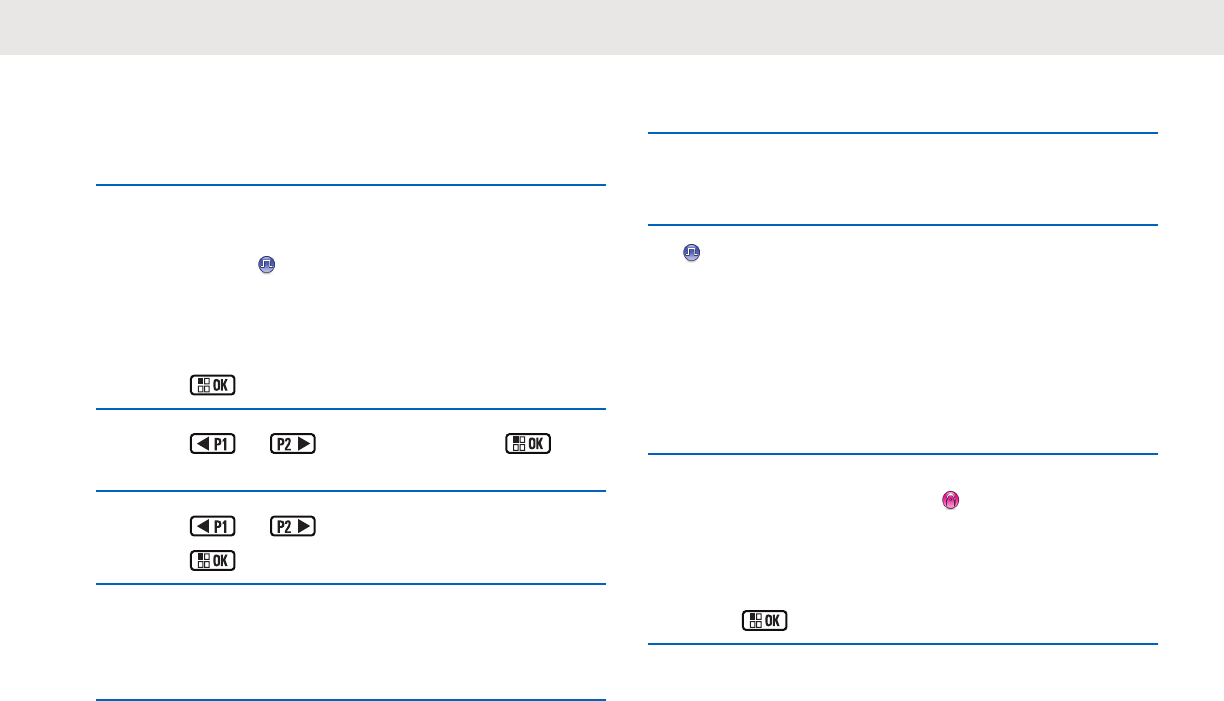
the channel is free for you to respond. Press the PTT
button to respond to the call.
The call ends when there is no voice activity for a
predetermined period.
Making Private Calls by Using the
Contacts List
Follow the procedure to make Private Calls on your radio
by using the Contacts list.
1Press to access the menu.
2Press or to Contacts. Press to
select.
3Press or to the required alias or ID.
Press to select.
4Press the PTT button to make the call.
The green LED lights up. The display shows the
destination alias.
5Wait for the Talk Permit Tone to end and speak
clearly into the microphone if enabled.
6Release the PTT button to listen.
The display shows the transmitting user alias or ID.
7 If the Channel Free Indication feature is enabled,
you hear a short alert tone the moment the
transmitting radio releases the PTT button, indicating
the channel is free for you to respond. Press the PTT
button to respond to the call.
The call ends when there is no voice activity for a
predetermined period. A tone sounds. The display
shows Call Ended.
Setting Default Contact
Follow the procedure to set the default contact on your
radio.
1Press to access the menu.
English
Send Feedback 73
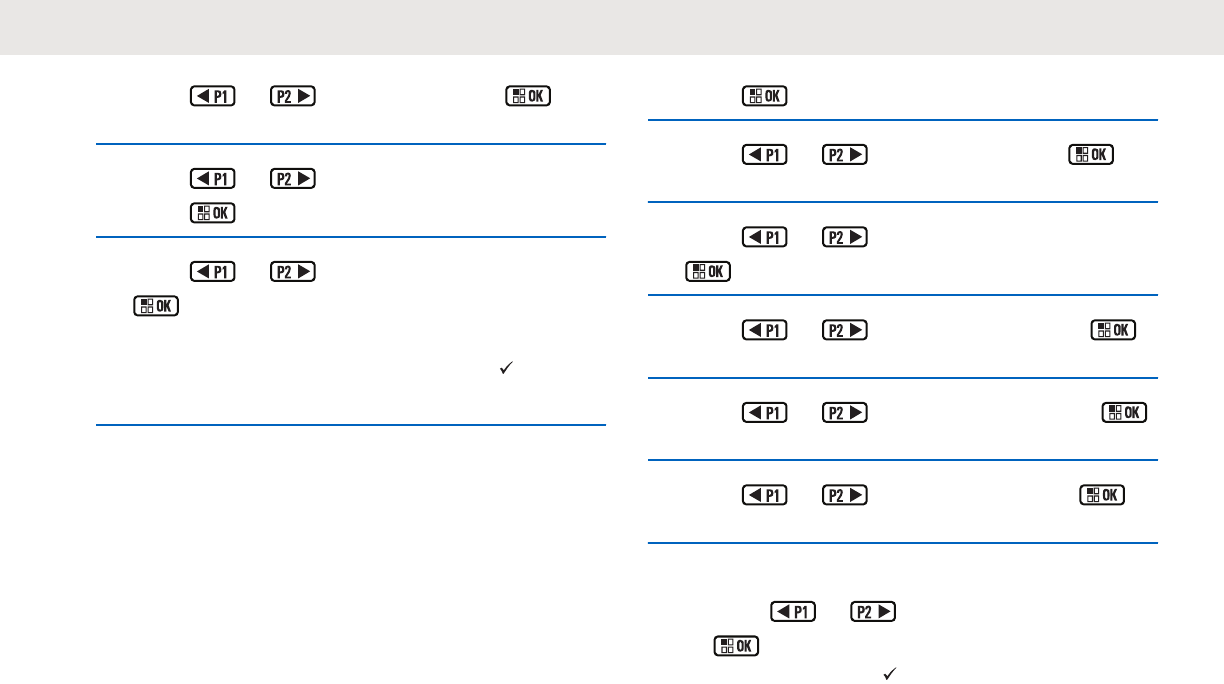
2Press or to Contacts. Press to
select.
3Press or to the required alias or ID.
Press to select.
4Press or to Set as Default. Press
to select.
A positive indicator tone sounds. The display shows
a positive mini notice. The display shows beside
the selected default alias or ID.
Call Indicator Settings
This feature allows the radio users to configure call or text
message ringing tones.
Activating or Deactivating Call Ringers
for Call Alerts
Follow the procedure to activate or deactivate call ringers
for Call Alerts on your radio.
1Press to access the menu.
2Press or to Utilities. Press to
select.
3Press or to Radio Settings. Press
to select.
4Press or to Tones/Alert. Press
to select.
5Press or to Call Ringers. Press
to select.
6Press or to Call Alert. Press to
select.
7Do one of the following:
• Press or to the required tone. Press
to select.
The display shows and the selected tone.
English
74 Send Feedback
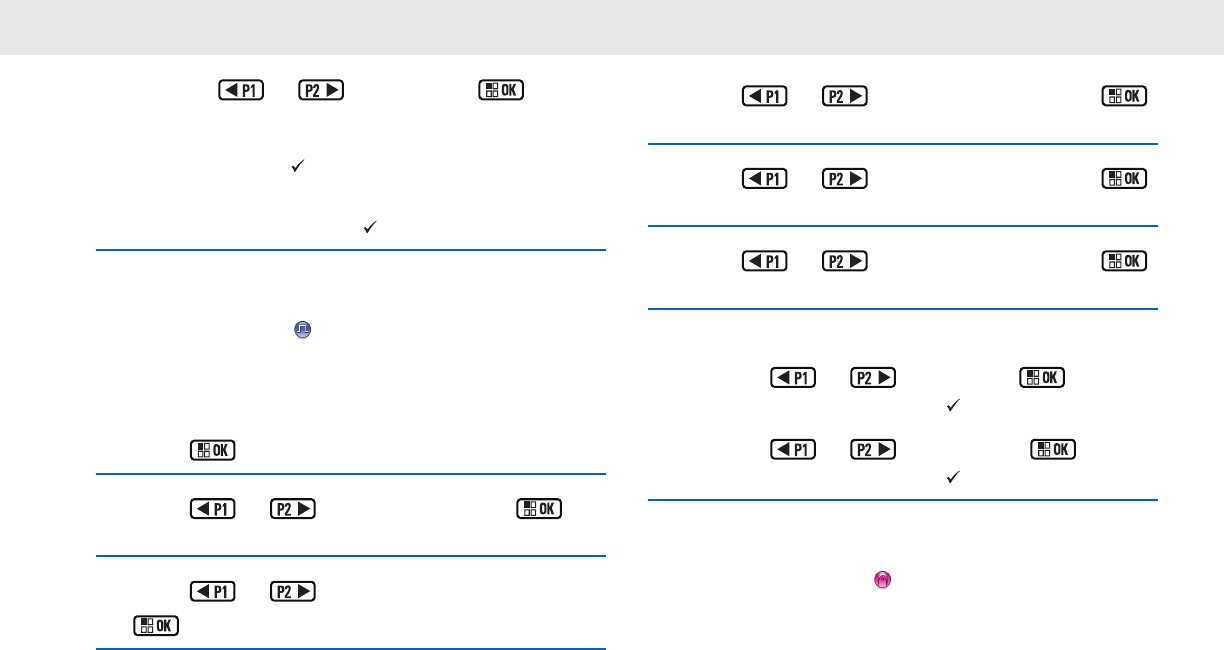
• Press or to Off. Press to
select.
If the ringing tones were earlier enabled, the
display shows beside Off.
If the ringing tones were earlier disabled, the
display does not show beside Off.
Activating or Deactivating Call Ringers
for Private Calls
Follow the procedure to activate or deactivate call ringers
for Private Calls on your radio.
1Press to access the menu.
2Press or to Utilities. Press to
select.
3Press or to Radio Settings. Press
to select.
4Press or to Tones/Alerts. Press
to select.
5Press or to Call Ringers. Press
to select.
6Press or to Private Call. Press
to select.
7Do one of the following:
• Press or to On. Press to
select. The display shows beside On.
• Press or to Off. Press to
select. The display shows beside Off.
Activating or Deactivating Call Ringers
for Selective Calls
Follow the procedure to activate or deactivate call ringers
for Selective Calls on your radio.
English
Send Feedback 75
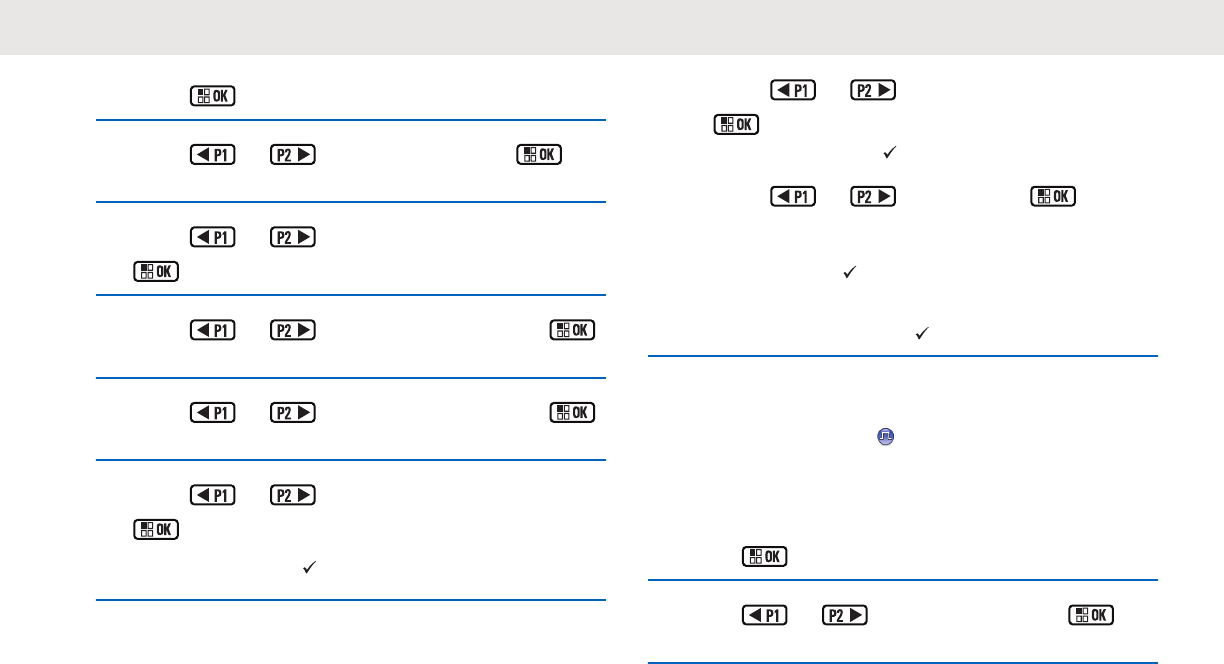
1Press to access the menu.
2Press or to Utilities. Press to
select.
3Press or to Radio Settings. Press
to select.
4Press or to Tones/Alerts. Press
to select.
5Press or to Call Ringers. Press
to select.
6Press or to Selective Call. Press
to select.
The display shows and the current tone.
7Do one of the following:
• Press or to the required tone. Press
to select.
The display shows and the selected tone.
• Press or to Off. Press to
select.
If the ringing tones were earlier enabled, the
display shows beside Off.
If the ringing tones were earlier disabled, the
display does not show beside Off.
Activating or Deactivating Call Ringers
for Text Messages
Follow the procedure to activate or deactivate call ringers
for text messages on your radio.
1Press to access the menu.
2Press or to Utilities. Press to
select.
English
76 Send Feedback
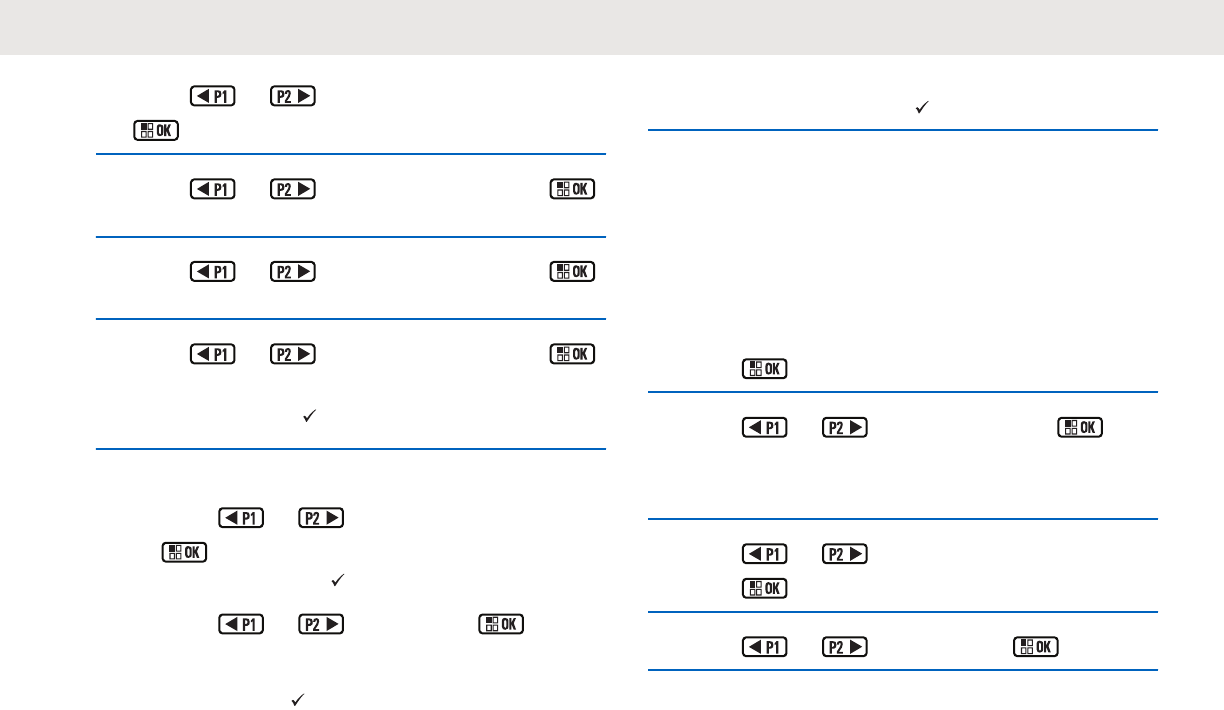
3Press or to Radio Settings. Press
to select.
4Press or to Tones/Alerts. Press
to select.
5Press or to Call Ringers. Press
to select.
6Press or to Text Message. Press
to select.
The display shows and the current tone.
7Do one of the following:
• Press or to the required tone. Press
to select.
The display shows and the selected tone.
• Press or to Off. Press to
select.
If the ringing tones were earlier enabled, the
display shows beside Off.
If the ringing tones were earlier disabled, the
display does not show beside Off.
Assigning Ring Styles
The radio can be programmed to sound one of ten
predefined ringing tones when receiving a Call Alert or a
Text Message from a particular contact. The radio sounds
out each ring style as you navigate through the list. Follow
the procedure to assign ring styles on your radio.
1Press to access the menu.
2Press or to Contacts. Press to
select.
The entries are alphabetically sorted.
3Press or to the required alias or ID.
Press to select.
4Press or to Edit. Press to select.
English
Send Feedback 77
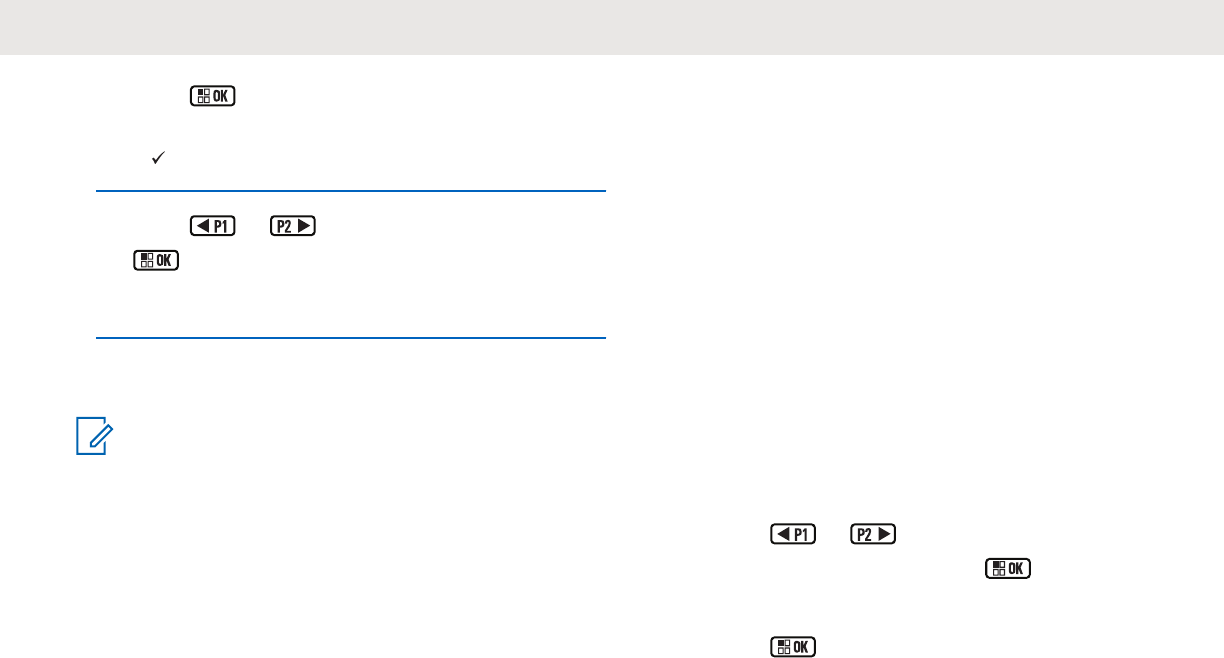
5Press until display shows Edit Ringtone
menu.
A indicates the current selected tone.
6Press or to the required tone. Press
to select.
The display shows Contact Saved
Selecting a Ring Alert Type
NOTICE:
The programmed Ring Alert Type button is
assigned by your dealer or system administrator.
Check with your dealer or system administrator to
determine how your radio has been programmed.
You can program the radio calls to one predetermined
vibrate call. If All Tones status is disabled, the radio
displays the All Tone Mute icon. If All Tones status is
enabled, the related ring alert type is displayed.
The radio vibrates once if it is a momentary ring style. The
radio vibrates repetitively if it is a repetitive ring style. When
set to Ring and Vibrate, the radio sounds a specific ring
tone if there is any incoming radio transaction (for example,
Call Alert or Message). It sounds like a positive indicator
tone or missed call.
For radios with batteries that support the vibrate feature
and are attached to a vibrating belt clip, the available Ring
Alert Type options are Silent, Ring, Vibrate, and Ring and
Vibrate.
For radios with batteries that do not support the vibrate
feature and are not attached to a vibrating belt clip, Ring
Alert Type is automatically set to Ring. The available Ring
Alert Type options are Silent and Ring.
You can select a Ring Alert Type by performing one of the
following actions.
• Press the programmed Ring Alert Type button to
access the Ring Alert Type menu.
a. Press or to Ring, Vibrate, Ring &
Vibrate or Silent and press to select.
• Access this feature through the menu.
a. Press to access the menu.
English
78 Send Feedback
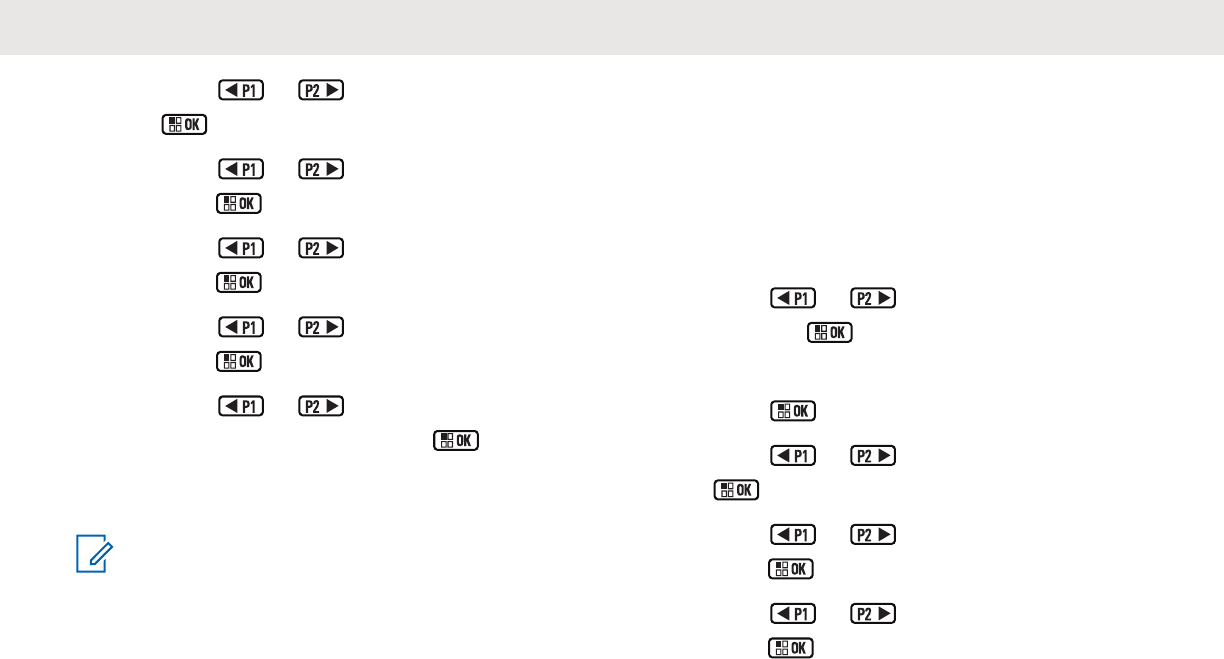
b. Press or to Utilities and press
to select.
c. Press or to Radio Settings and
press to select.
d. Press or to Tones/Alerts and
press to select.
e. Press or to Ring Alert Type and
press to select.
f. Press or to Ring, Vibrate, Ring &
Vibrate or Silent and press to select.
Configuring Vibrate Style
NOTICE:
The programmed Vibrate Style button is assigned
by your dealer or system administrator. Check with
your dealer or system administrator to determine
how your radio has been programmed.
Vibrate Style is enabled when the Vibrating Belt Clip is
attached to the radio with a battery that supports the vibrate
feature.
You can configure the vibrate style by performing one of
the following actions.
• Press the programmed Vibrate Style button to
access the Vibrate Style menu.
a. Press or to Short, Medium, or Long
and press to select.
• Access this feature via the menu.
a. Press to access the menu.
b. Press or to Utilities and press
to select.
c. Press or to Radio Settings and
press to select.
d. Press or to Tones/Alerts and
press to select.
English
Send Feedback 79
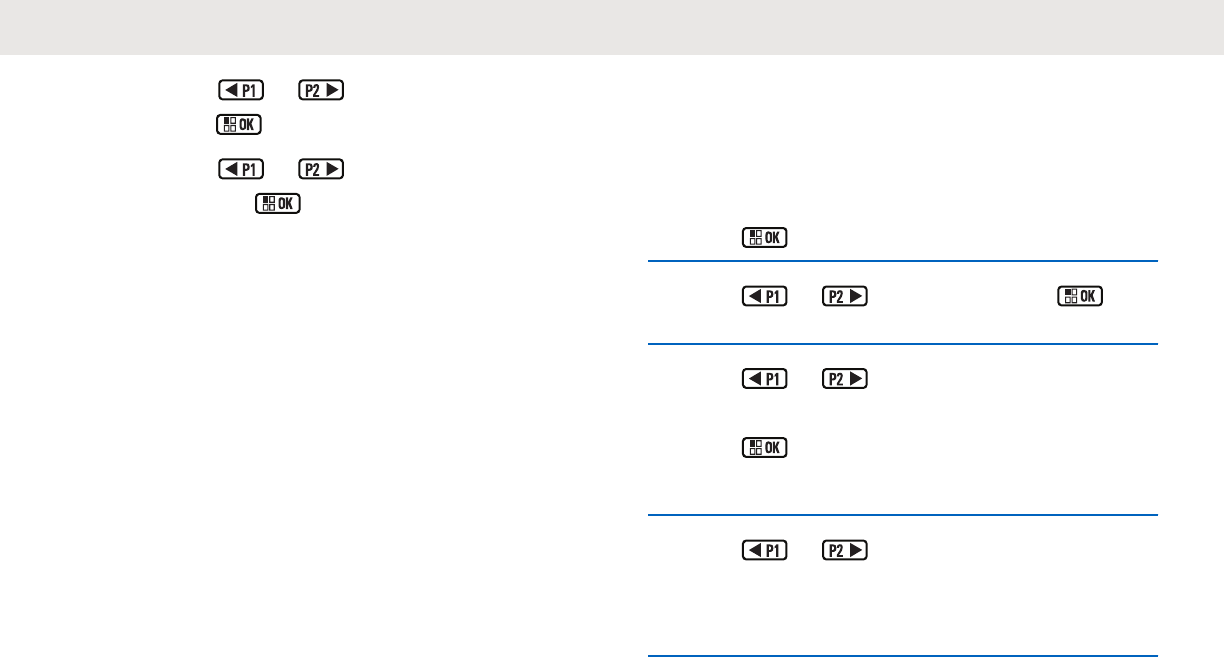
e. Press or to Vibrate Style and
press to select.
f. Press or to Short, Medium, or Long
and press to select.
Alarm Tone Volume Escalation
Your radio can be programmed by your dealer to
continually alert you when a radio call remains
unanswered.
This is done by automatically increasing the alarm tone
volume over time. This feature is known as Escalert.
Call Log Features
Your radio keeps track of all recent outgoing, answered,
and missed Private Calls. The call log feature is used to
view and manage recent calls.
Missed Call Alerts may be included in the call logs,
depending on the system configuration on your radio. You
can perform the following tasks in each of your call lists:
• Delete Call
• View Details
Viewing Recent Calls
Follow the procedure to view recent calls on your radio.
1Press to access the menu.
2Press or to Call Log. Press to
select.
3Press or to the preferred list. The
options are Missed, Answered, and Outgoing lists.
Press to select.
The display shows the most recent entry.
4Press or to view the list.
You can start a Private Call with the alias or ID the
display is currently showing by pressing the PTT
button.
English
80 Send Feedback
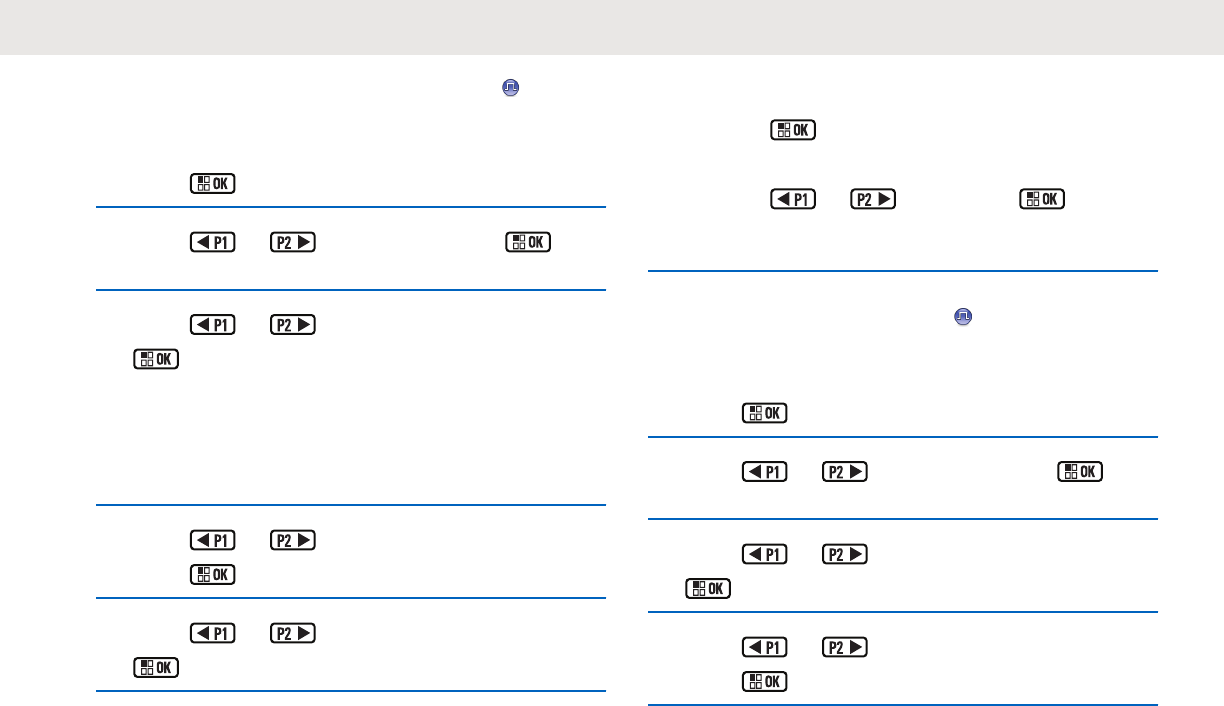
Deleting Calls from the Call List
Follow the procedure to delete calls from the Call list.
1Press to access the menu.
2Press or to Call Log. Press to
select.
3Press or to the required list. Press
to select.
If the list is empty:
• A tone sounds.
• The display shows List Empty.
4Press or to the required alias or ID.
Press to select.
5Press or to Delete Entry?. Press
to select.
6Do one of the following:
• Press to select Yes to delete the entry.
The display shows Entry Deleted.
• Press or to No. Press to
select.
The radio returns to the previous screen.
Viewing Call List Details
Follow the procedure to view call details on your radio.
1Press to access the menu.
2Press or to Call Log. Press to
select.
3Press or to the required list. Press
to select.
4Press or to the required alias or ID.
Press to select.
English
Send Feedback 81
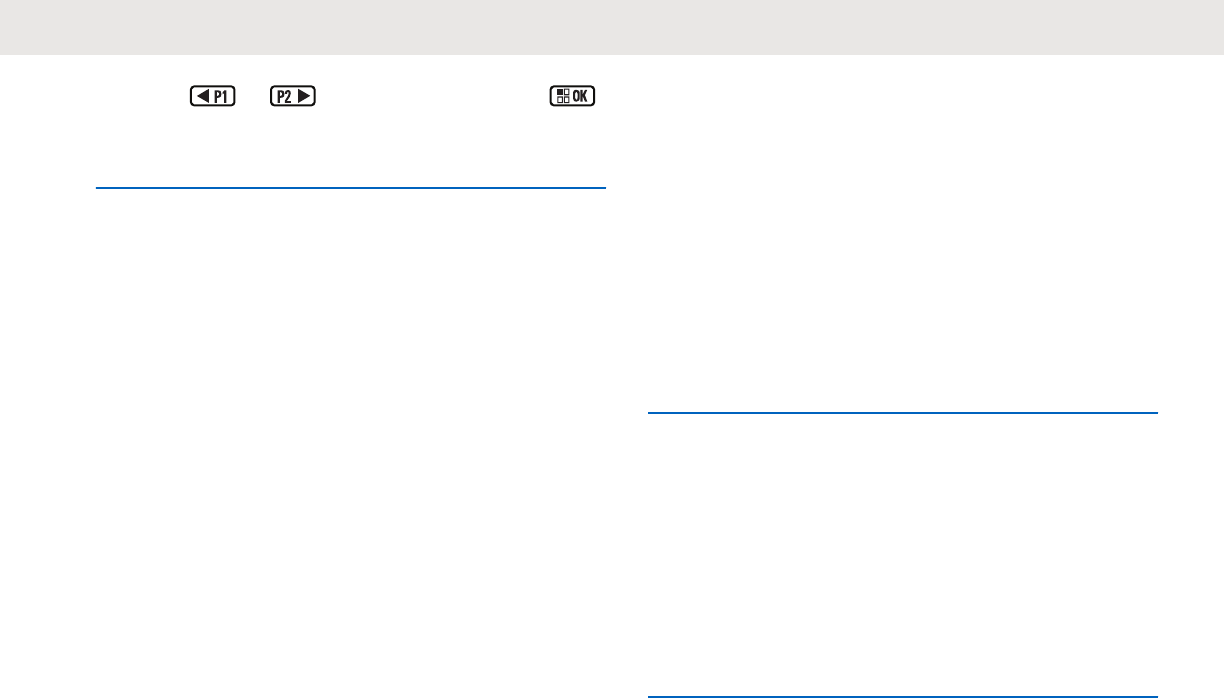
5Press or to View Details. Press
to select.
The display shows the call details.
Call Alert Operation
Call Alert paging enables you to alert a specific radio user
to call you back.
This feature is applicable for subscriber aliases or IDs only
and is accessible through the menu using Contacts or a
programmed One Touch Access button.
Responding to Call Alerts
Follow the procedure to respond to Call Alerts on your
radio.
When you receive a Call Alert:
• A repetitive tone sounds.
• The yellow LED blinks.
• The display shows the notification list listing a Call Alert
with the alias or ID of the calling radio.
Depending on the configuration by your dealer or
system administrator, you can respond to a Call Alert
by doing one of the following:
• Press the PTT button and respond with a Private
Call directly to the caller.
• Press the PTT button to continue normal
talkgroup communication.
The Call Alert is moved to the Missed Call option
at the Call Log menu. You can respond to the
caller from the Missed Called log.
See Notification List on page 101 and Call Log Features
on page 80 for more information.
Making Call Alerts
Follow the procedure to make Call Alerts on your radio.
1Press the programmed One Touch Access button.
The display shows Call Alert and the subscriber
alias or ID. The green LED lights up.
English
82 Send Feedback
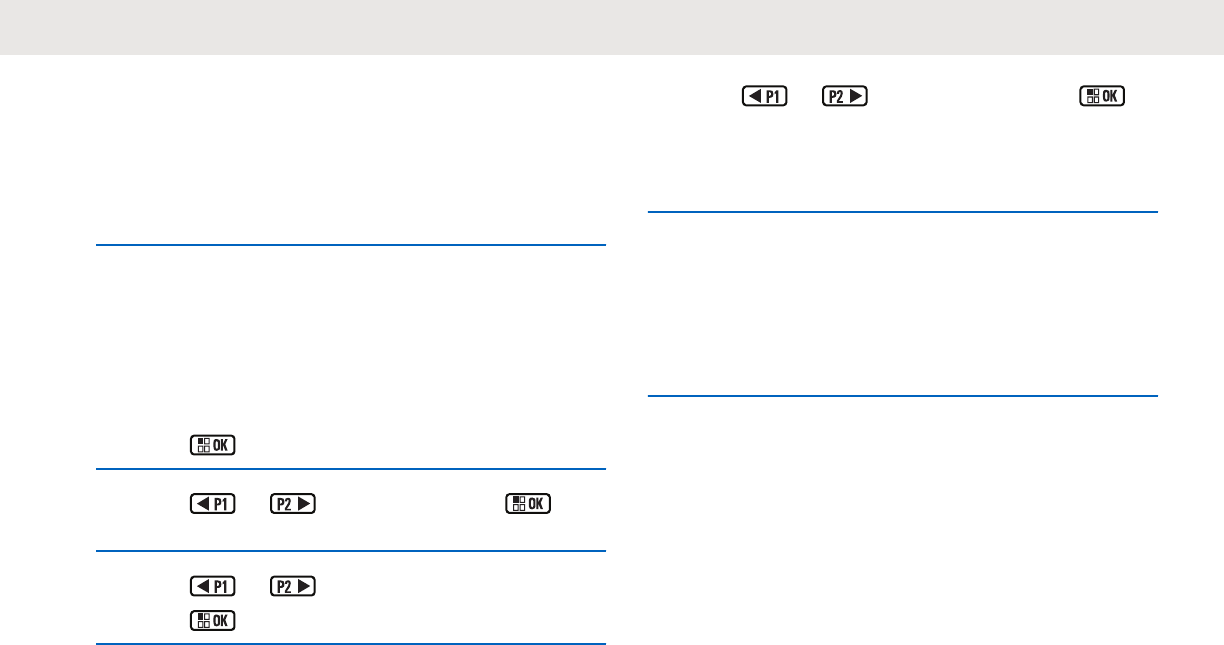
2Wait for acknowledgment.
If the Call Alert acknowledgment is received, the
display shows a positive mini notice.
If the Call Alert acknowledgment is not received, the
display shows a negative mini notice.
Making Call Alerts by Using the
Contacts List
Follow the procedure to make Call Alerts on your radio by
using the Contacts list.
1Press to access the menu.
2Press or to Contacts. Press to
select.
3Press or to the required alias or ID.
Press to select.
4Press or to Call Alert. Press to
select.
The display shows Call Alert and the subscriber
alias or ID. The green LED lights up.
5Wait for acknowledgment.
• If the Call Alert acknowledgment is received, the
display shows a positive mini notice.
• If the Call Alert acknowledgment is not received,
the display shows a negative mini notice.
Mute Mode
Mute Mode provides an option to the user to silence all
audio indicators of the radio.
Once Mute Mode feature is initiated, all audio indicators are
muted except higher priority features such as Emergency
operations.
When Mute Mode is exited, the radio resumes playing
ongoing tones and audio transmissions.
English
Send Feedback 83
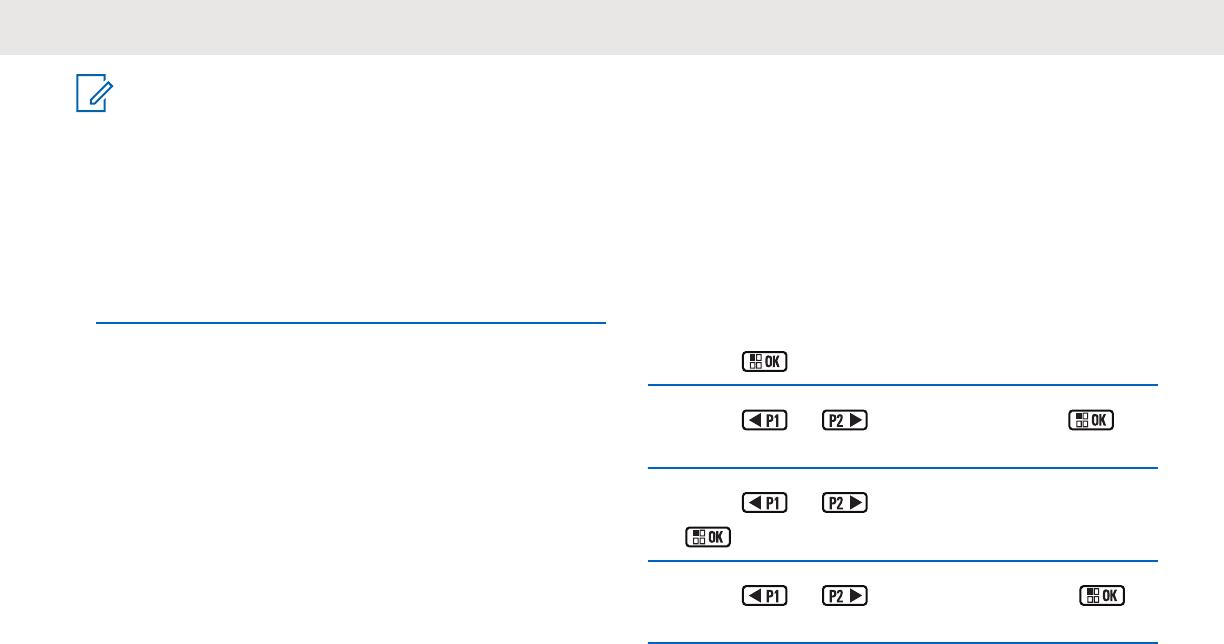
NOTICE:
This is a purchasable feature. Check with your
dealer or system administrator for more information.
Turning On Mute Mode
Follow the procedure to turn on Mute Mode.
Access this feature by using the programmed Mute
Mode button.
The following occurs when Mute mode is enabled:
• Positive Indicator Tone sounds.
• Display shows Mute Mode On.
• The red LED light starts blinking and remains blinking
until Mute Mode is exited.
• Display shows Mute Mode icon on home screen.
• Radio is muted.
• Mute Mode Timer begins counting down the duration
that is configured.
Setting Mute Mode Timer
Mute Mode feature can be enabled for a pre-configured
amount of time by setting the Mute Mode Timer. The timer
duration is configured in the radio menu and can range
between 0.5–6 hours. Mute Mode is exited once the timer
expires.
If the timer is left at 0, the radio remains in Mute mode for
an indefinite period until the programmed Mute Mode
button is pressed.
1Press to access the menu.
2Press or to Utilities. Press to
select.
3Press or to Radio Settings. Press
to select.
4Press or to Mute Timer. Press to
select.
English
84 Send Feedback

5Press or to edit the numeric value of
each digit, and press .
Exiting Mute Mode
This feature can be exited automatically once the Mute
Mode Timer expires.
Do one of the following to exit Mute mode manually:
• Press the programmed Mute Mode button.
• Press the PTT button on any entry.
The following occurs when Mute mode is disabled:
• Negative Indicator Tone sounds.
• Display shows Mute Mode Off.
• The blinking red LED turns off.
•Mute Mode icon disappears from home screen.
• Your radio unmutes and speaker state is restored.
• If the timer has not expired, Mute mode timer is
stopped.
NOTICE:
Mute Mode is also exited if the user transmits voice
or switches to an unprogrammed channel.
Emergency Operation
An Emergency Alarm is used to indicate a critical situation.
You are able to initiate an Emergency at any time even
when there is activity on the current channel.
Your dealer can set the duration of a button press for the
programmed Emergency button, except for long press,
which is similar with all other buttons:
Short Press
Duration between 0.05 seconds and 0.75 seconds.
Long Press
Duration between 1.00 second and 3.75 seconds.
The Emergency button is assigned with the Emergency
On/Off feature. Check with your dealer for the assigned
operation of the Emergency button.
English
Send Feedback 85

NOTICE:
If a short press to the Emergency button initiates
Emergency mode, then a long press to the same
enables the radio to exit Emergency mode.
If a long press to the Emergency button initiates
Emergency mode, then a short press to the same
enables the radio to exit Emergency mode.
Your radio supports three Emergency Alarms:
• Emergency Alarm
• Emergency Alarm with Call
• Emergency Alarm with Voice to Follow
NOTICE:
Only one of the Emergency Alarms above can be
assigned to the programmed Emergency button.
In addition, each alarm has the following types:
Regular
Radio transmits an alarm signal and shows audio
and/or visual indicators.
Silent
Radio transmits an alarm signal without any audio or
visual indicators. Radio receives calls without any
sound through the speaker, until the programmed hot
mic transmission period is over and/or you press the
PTT button.
Silent with Voice
Radio transmits an alarm signal without any audio or
visual indicators, but allow incoming calls to sound
through the speaker. If hot mic is enabled, the incoming
calls sound through the speaker after the programmed
hot mic transmission period is over. The indicators only
appear once you press the PTT button.
Sending Emergency Alarms
This feature allows you to send an Emergency Alarm, a
non-voice signal, which triggers an alert indication on a
group of radios. Your radio does not display any audio or
visual indicators during Emergency mode when it is set to
Silent.
Follow the procedure to send Emergency Alarms on your
radio.
1Press the programmed Emergency On button.
You see one of these results:
• The display shows Tx Alarms and the
destination alias.
English
86 Send Feedback

• The display shows Tx Telegram and the
destination alias.
The green LED lights up. The Emergency icon
appears.
NOTICE:
If programmed, the Emergency Search tone
sounds. This tone is muted when the radio
transmits or receives voice, and stops when
the radio exits Emergency mode. The
Emergency Search tone can be programmed
through CPS.
2Wait for acknowledgment.
If successful:
• The Emergency tone sounds.
• The green LED blinks.
• The display shows Alarm Sent.
If unsuccessful after all retries have been exhausted:
• A tone sounds.
• The display shows Alarm Failed.
The radio exits the Emergency Alarm mode and
returns to the Home screen.
Sending Emergency Alarms with Call
This feature allows you to send an Emergency Alarm with
Call to a group of radios. Upon acknowledgement by a
radio within the group, the group of radios can
communicate over a programmed Emergency channel.
Follow the procedure to send Emergency Alarms with call
on your radio.
1Press the programmed Emergency On button.
You see the following:
• The display shows Tx Telegram and the
destination alias.
The green LED lights up. The Emergency icon
appears.
English
Send Feedback 87
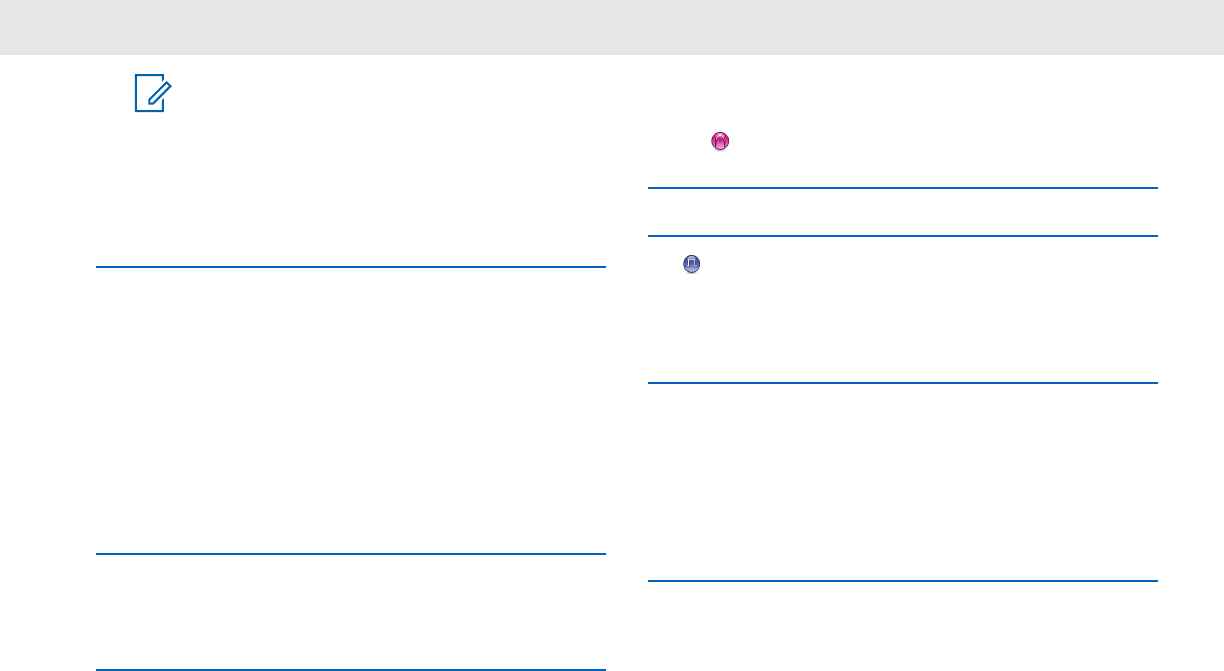
NOTICE:
If programmed, the Emergency Search tone
sounds. This tone is muted when the radio
transmits or receives voice, and stops when
the radio exits Emergency mode. The
Emergency Search tone can be programmed
by your dealer or system administrator.
2Wait for acknowledgment.
If successful:
• The Emergency tone sounds.
• The green LED blinks.
• The display shows Alarm Sent.
• Your radio enters the Emergency call mode when
the display shows Emergency and the destination
group alias.
3Press the PTT button to make the call.
The green LED lights up. The display shows the
Group Call icon.
4Do one of the following:
• Wait for the Talk Permit Tone to end and speak
clearly into the microphone if enabled.
• Wait for the PTT Sidetone to end and speak
clearly into the microphone if enabled.
5Release the PTT button to listen.
6 If the Channel Free Indication feature is enabled,
you hear a short alert tone the moment the
transmitting radio releases the PTT button, indicating
the channel is free for you to respond. Press the PTT
button to respond to the call.
7To exit the Emergency mode once the call ends,
press the Emergency Off button.
If you do not press the Emergency Off button to exit
the Emergency mode, the red LED blinks and the
radio stays in Emergency mode.
The radio returns to the Home screen.
English
88 Send Feedback

Sending Emergency Alarms with Voice
to Follow
This feature allows you to send an Emergency Alarm with
Voice to Follow to a group of radios. Your radio microphone
is automatically activated, allowing you to communicate
with the group of radios without pressing the PTT button.
This activated microphone state is also known as hot mic.
If your radio has Emergency Cycle Mode enabled,
repetitions of hot mic and receiving period are made for a
programmed duration. During Emergency Cycle Mode,
received calls sound through the speaker.
If you press the PTT button during the programmed
receiving period, you hear a prohibit tone, indicating that
you should release the PTT button. The radio ignores the
PTT button press and remains in Emergency mode.
If you press the PTT button during hot mic, and continue to
press it after the hot mic duration expires, the radio
continues to transmit until you release the PTT button.
If the Emergency Alarm request fails, the radio does not
retry to send the request, and enters the hot mic state
directly.
NOTICE:
Some accessories may not support hot mic. Check
with your dealer or system administrator for more
information.
Follow the procedure to send Emergency Alarms with voice
to follow on your radio.
1Press the programmed Emergency On button.
You see one of these results:
• The display shows Tx Alarm and the destination
alias.
• The display shows Tx Telegram and the
destination alias.
The green LED lights up. The Emergency icon
appears.
2Once the Emergency tone sounds, speak clearly into
the microphone.
The radio automatically stops transmitting when:
• The cycling duration between hot mic and
receiving calls expires, if Emergency Cycle Mode
is enabled.
English
Send Feedback 89
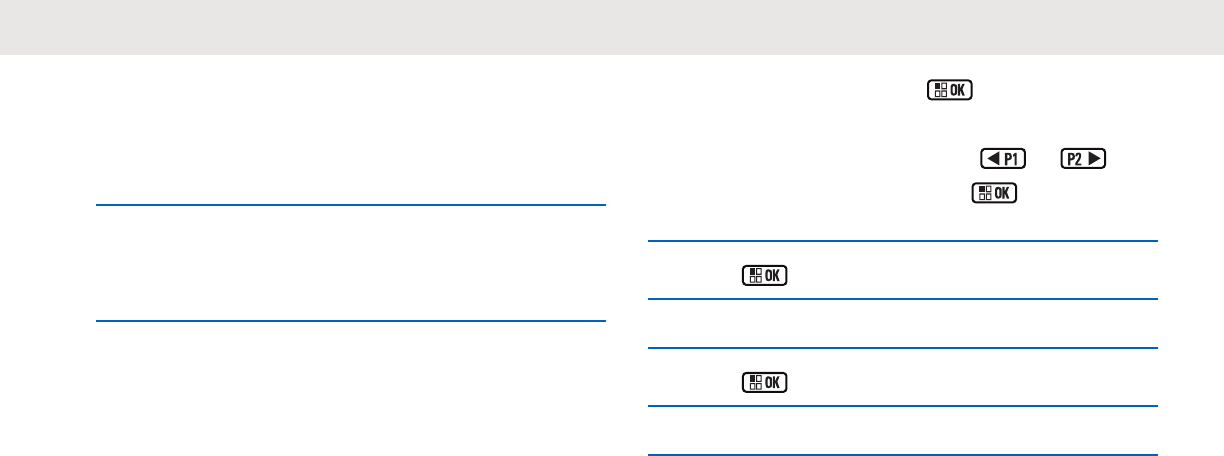
• The hot mic duration expires, if Emergency Cycle
Mode is disabled.
The red LED blinks. The radio remains in
Emergency mode.
3Press the Emergency Off button to exit the
Emergency mode.
The radio returns to the Home screen.
Receiving Emergency Alarms
Follow the procedure to receive Emergency Alarms on your
radio.
When you receive an Emergency Alarm:
• A tone sounds.
• The red LED blinks.
• The display shows the Emergency icon, and the
Emergency caller alias or if there is more than one
alarm, all emergency caller aliases are displayed in an
Alarm List.
1Do one of the following:
• If only one alarm, press to view more
details.
• If more than one alarm, press or to
the required alias, and press to view more
details.
2Press to view the action options.
3Press and select Yes to exit the Alarm list.
4Press to access the menu.
5Select Alarm List to revisit the Alarm list.
Reinitiating Emergency Mode
This feature is only applicable to the radio sending the
Emergency Alarm. Follow the procedure to reinitiate
Emergency mode on your radio.
Do one of the following:
• Change the channel while the radio is in
Emergency mode. The radio exits the Emergency
English
90 Send Feedback
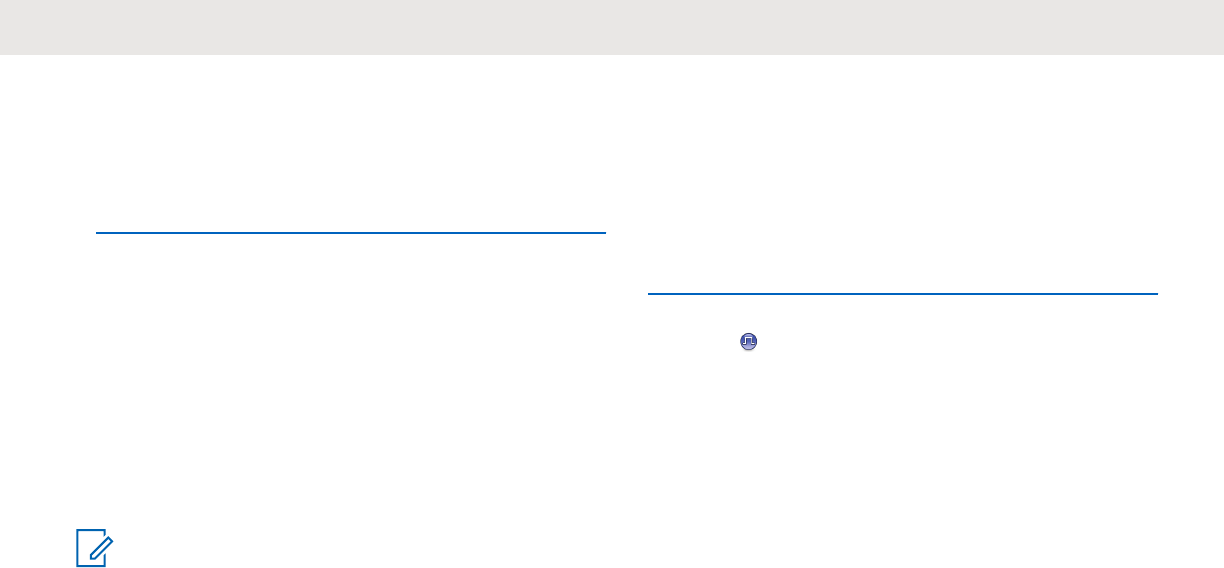
mode, and reinitiates Emergency, if Emergency
Alarm is enabled on the new channel.
• Press the programmed Emergency On button
during an Emergency initiation or transmission
state. The radio exits this state, and reinitiates
Emergency.
Exiting Emergency Mode After Sending
the Emergency Alarm
This feature is only applicable to the radio sending the
Emergency Alarm.
Your radio exits Emergency mode when:
• An acknowledgment is received (for Emergency Alarm
only).
• All retries to send the alarm have been exhausted.
NOTICE:
If your radio is powered off, it exits the Emergency
mode. The radio will not reinitiate the Emergency
mode automatically when it is turned on again.
Follow the procedure to exit Emergency mode on your
radio.
Do one of the following:
• Press the programmed Emergency Off button.
• Change the channel to a new channel that has no
emergency system configured.
The display shows No Emergency.
Privacy
This feature helps to prevent eavesdropping by
unauthorized users on a channel by the use of a software-
based scrambling solution. The signaling and user
identification portions of a transmission are not scrambled.
Your radio must have privacy enabled on the channel to
send a privacy-enabled transmission, although this is not a
necessary requirement for receiving a transmission. While
on a privacy-enabled channel, the radio is still able to
receive clear or unscrambled transmissions.
Some radio models may not offer Privacy feature, or may
have a different configuration. Check with your dealer or
system administrator for more information.
English
Send Feedback 91
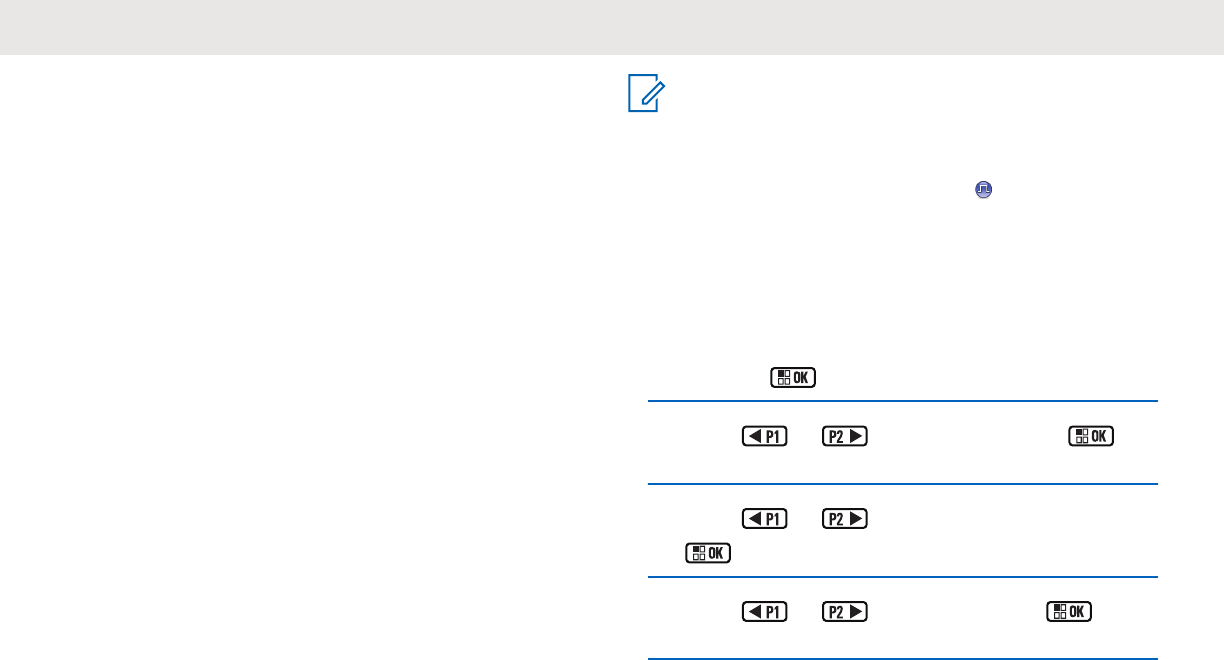
Your radio supports two types of privacy, but only one can
be assigned to your radio. They are:
• Basic Privacy
• Enhanced Privacy
To unscramble a privacy-enabled call or data transmission,
your radio must be programmed to have the same Privacy
Key for Basic Privacy, or the same Key Value and Key ID
for Enhanced Privacy as the transmitting radio.
If your radio receives a scrambled call that is of a different
Privacy Key, or different Key Value and Key ID, you will
either hear a garbled transmission for Basic Privacy or
nothing at all for Enhanced Privacy.
On a privacy-enabled channel, your radio is able to receive
clear or unscrambled calls, depending on how your radio is
programmed. In addition, your radio may play a warning
tone or not, depending on how it is programmed.
If the radio has a privacy type assigned, the Home Screen
shows the Secure or Unsecure icon, except when the
radio is sending or receiving an Emergency call or alarm.
The green LED lights up when the radio is transmitting, and
blinks rapidly when the radio is receiving an ongoing
privacy-enabled transmission.
NOTICE:
This feature is not applicable in Citizens Band
channels that are in the same frequency.
Turning Privacy On or Off
Follow the procedure to turn privacy on or off on your radio.
1Do one of the following:
• Press the programmed Privacy button. Skip the
steps below.
• Press to access the menu.
2Press or to Utilities. Press to
select.
3Press or to Radio Settings. Press
to select.
4Press or to Privacy. Press to
select.
5Do one of the following:
English
92 Send Feedback
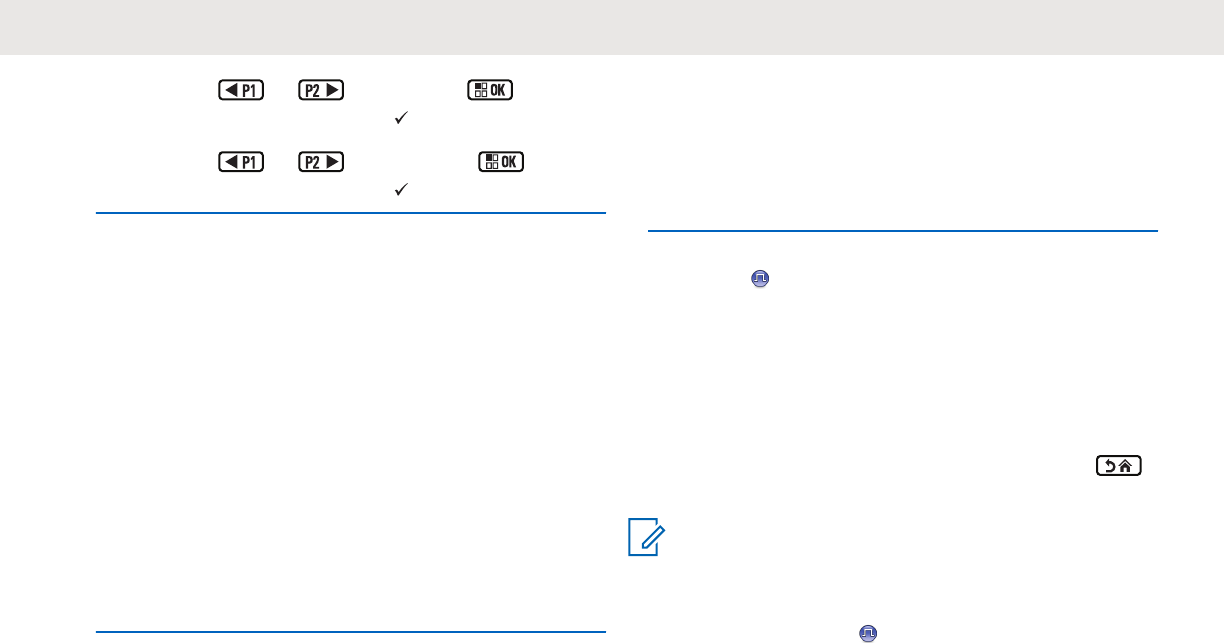
• Press or to On. Press to
select. The display shows beside On.
• Press or to Off. Press to
select. The display shows beside Off.
Covert Mode
Your radio is capable of Covert Mode. During covert mode,
all keypad and programmed button access are blocked.
When enabled, all visual indications (display, LEDs and
backlight) are disabled.
This feature allows audio or tone only by using a wired
accessory or a Bluetooth accessory.
Entering Covert Mode
Press Volume Up and Volume Down button
alternately 6 times (+ - + - + -), all in five seconds.
Radio enters into Covert Mode.
Exiting Covert Mode
Press Volume Up and Volume Down button
alternately 6 times (+ - + - + -), all in five seconds.
Radio returns to normal mode.
Security
This feature allows you to enable or disable any radio in the
system.
For example, you may want to disable a stolen radio to
prevent unauthorized users from using it, and enable the
radio when it is recovered.
You will not receive an acknowledgment if you press
during Radio Enable or Radio Disable operation.
NOTICE:
Check with your dealer or system administrator for
more information.
Disabling Radios
Follow the procedure to disable your radio.
English
Send Feedback 93
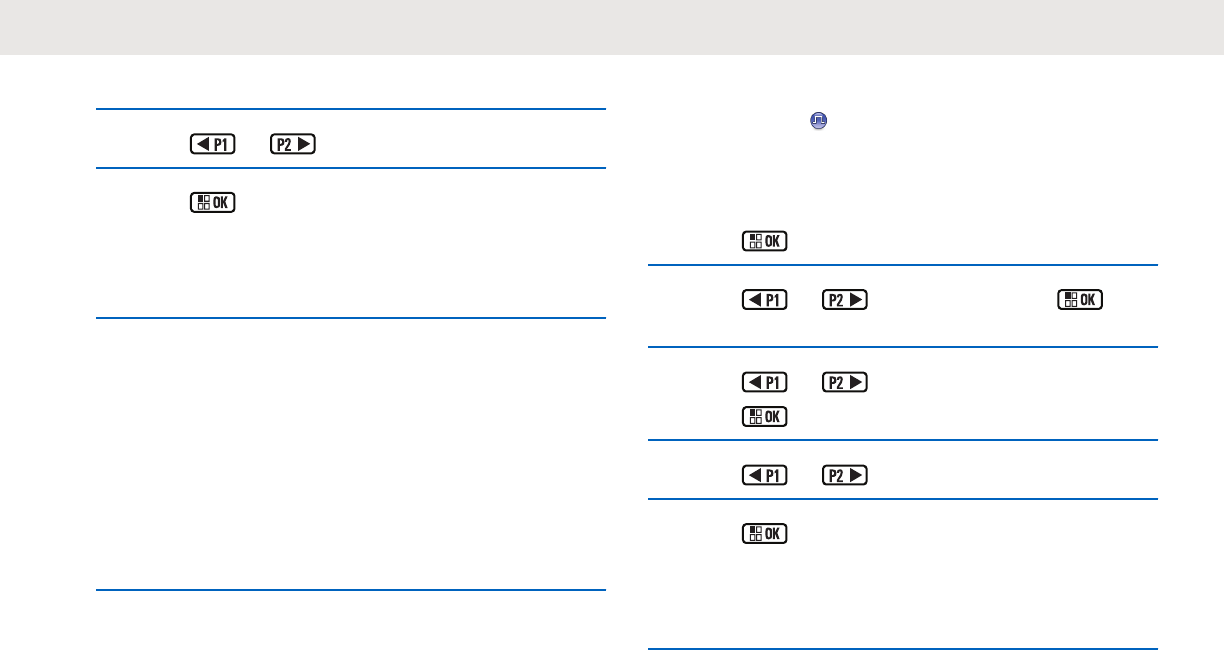
1Press the programmed Radio Disable button.
2Press or to the required alias or ID.
3Press to select.
The display shows a transitional mini notice,
indicating the request is in progress. The green LED
blinks.
4Wait for acknowledgment.
If successful:
• A positive indicator tone sounds.
• The display shows a positive mini notice.
If unsuccessful:
• A negative indicator tone sounds.
• The display shows a negative mini notice.
Disabling Radios by Using the
Contacts List
Follow the procedure to disable your radio by using the
Contacts list.
1Press to access the menu.
2Press or to Contacts. Press to
select.
3Press or to the required alias or ID.
Press to select.
4Press or to Radio Disable.
5Press to select.
The display shows a transitional mini notice,
indicating the request is in progress.The green LED
blinks.
English
94 Send Feedback
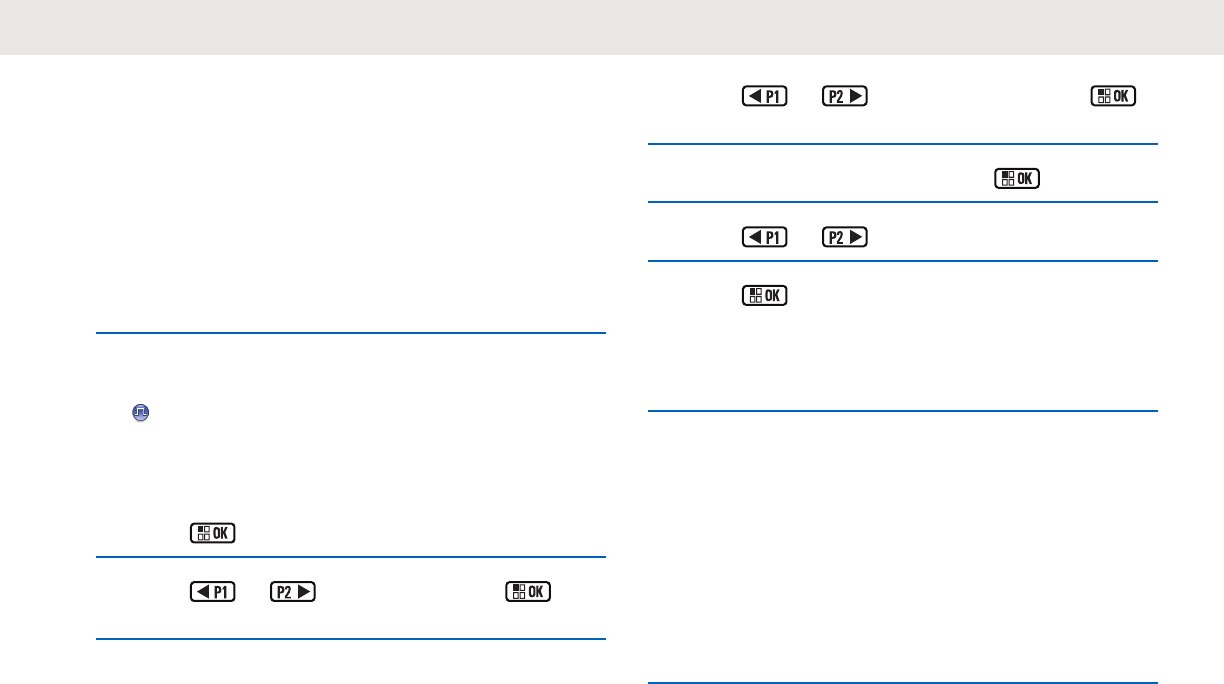
6Wait for acknowledgment.
If successful:
• A positive indicator tone sounds.
• The display shows a positive mini notice.
If unsuccessful:
• A negative indicator tone sounds.
• The display shows a negative mini notice.
Disabling Radios by Using the Manual
Dial
Follow the procedure to disable your radio by using the
manual dial.
1Press to access the menu.
2Press or to Contacts. Press to
select.
3Press or to Manual Dial. Press
to select.
4Enter the subscriber ID, and press to proceed.
5Press or to Radio Disable.
6Press to select.
The display shows a transitional mini notice,
indicating the request is in progress. The green LED
blinks.
7Wait for acknowledgment.
If successful:
• A positive indicator tone sounds.
• The display shows a positive mini notice.
If unsuccessful:
• A negative indicator tone sounds.
• The display shows a negative mini notice.
English
Send Feedback 95
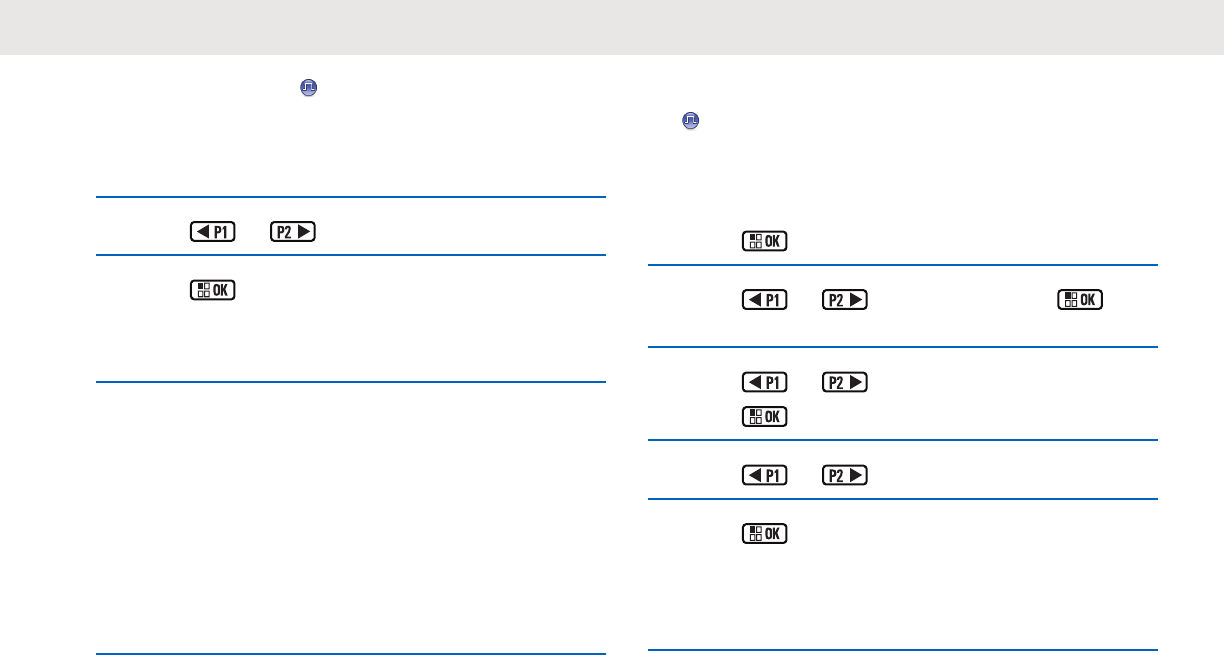
Enabling Radios
Follow the procedure to enable your radio.
1Press the programmed Radio Enable button.
2Press or to the required alias or ID.
3Press to select.
The display shows Radio Enable and the
subscriber alias or ID. The green LED lights up.
4Wait for acknowledgment.
If successful:
• A positive indicator tone sounds.
• The display shows a positive mini notice.
If unsuccessful:
• A negative indicator tone sounds.
• The display shows a negative mini notice.
Enabling Radios by Using the Contacts
List
Follow the procedure to enable your radio by using the
Contacts list.
1Press to access the menu.
2Press or to Contacts. Press to
select.
3Press or to the required alias or ID.
Press to select.
4Press or to Radio Enable.
5Press to select.
The green LED blinks. The display shows Radio
Enable and the subscriber alias or ID. The green
LED lights up.
English
96 Send Feedback
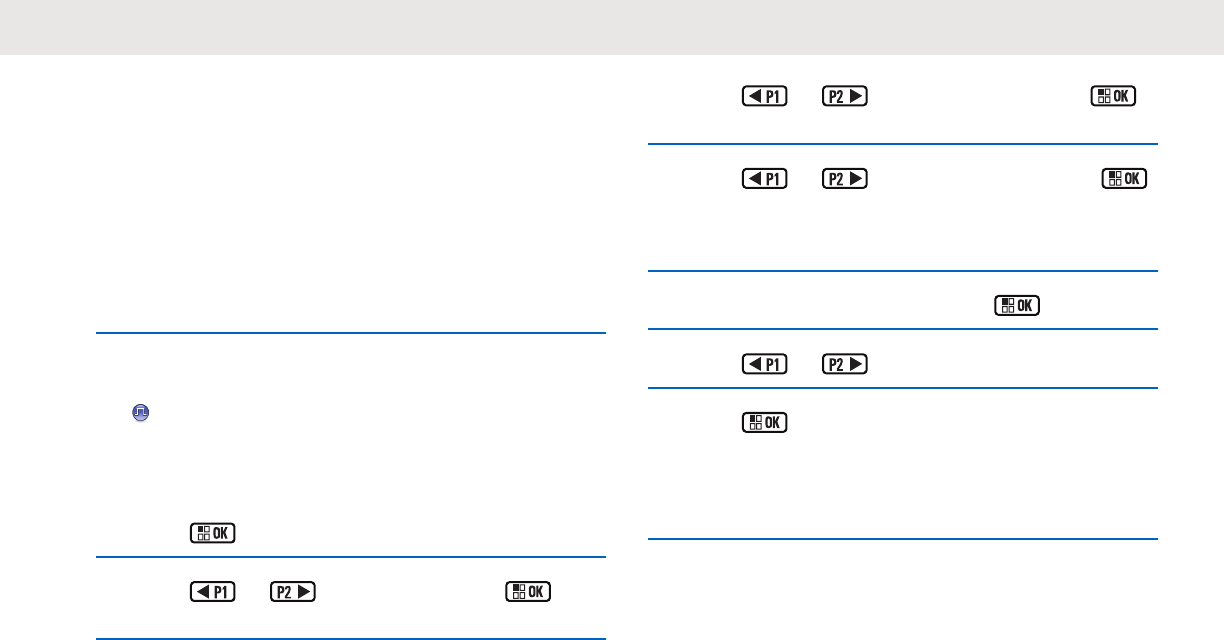
6Wait for acknowledgment.
If successful:
• A positive indicator tone sounds.
• The display shows a positive mini notice.
If unsuccessful:
• A negative indicator tone sounds.
• The display shows a negative mini notice.
Enabling Radios by Using the Manual
Dial
Follow the procedure to enable your radio by using the
manual dial.
1Press to access the menu.
2Press or to Contacts. Press to
select.
3Press or to Manual Dial. Press
to select.
4Press or to Private Call. Press
to select.
The first text line shows Radio Number:.
5Enter the subscriber ID, and press to proceed.
6Press or to Radio Enable.
7Press to select.
The green LED blinks. The display shows Radio
Enable and the subscriber alias or ID. The green
LED lights up.
8Wait for acknowledgment.
If successful:
• A positive indicator tone sounds.
• The display shows a positive mini notice.
If unsuccessful:
English
Send Feedback 97
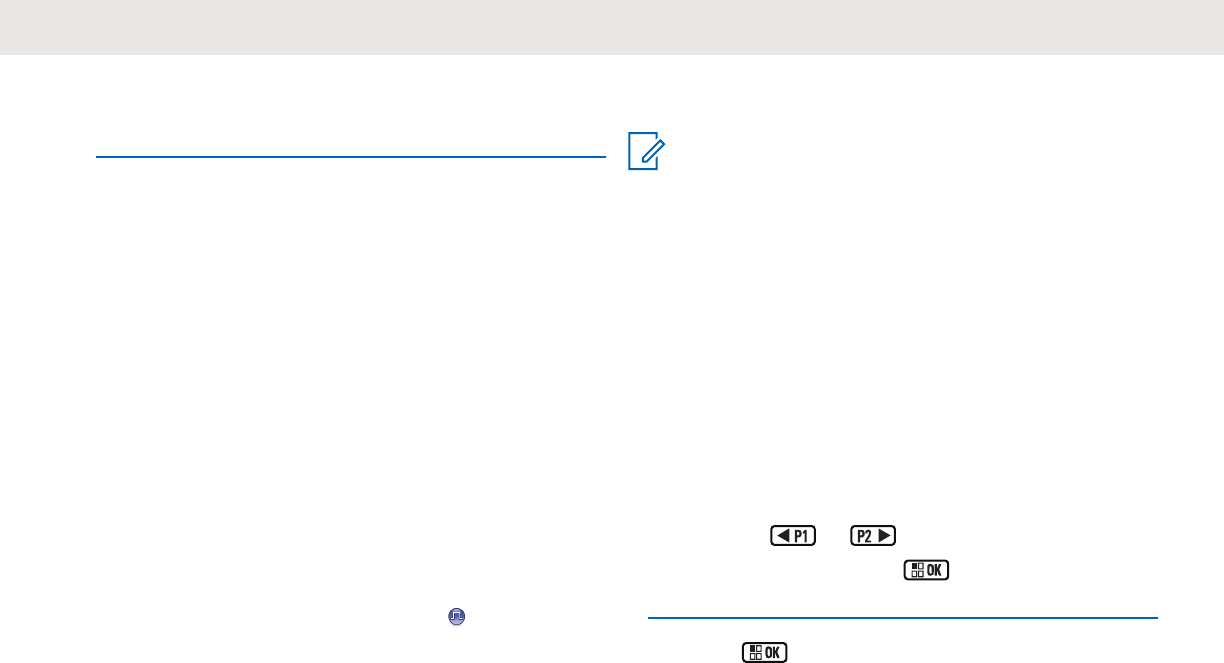
• A negative indicator tone sounds.
• The display shows a negative mini notice.
Lone Worker
This feature prompts an emergency to be raised if there is
no user activity, such as any radio button press or channel
selection, for a predefined time.
Following no user activity for a programmed duration, the
radio pre-warns you using an audio indicator once the
inactivity timer expires.
If there is still no acknowledgment by you before the
predefined reminder timer expires, the radio initiates an
Emergency Alarm.
Only one of the following Emergency Alarms is assigned to
this feature:
• Emergency Alarm
• Emergency Alarm with Call
• Emergency Alarm with Voice to Follow
The radio remains in the emergency state, allowing voice
messages to proceed until action is taken. See Emergency
Operation on page 85 for more information on ways to exit
Emergency.
NOTICE:
Check with your dealer or system administrator for
more information.
Password Lock Features
This feature allows you to restrict access to the radio by
asking for a password when the device is turned on.
Accessing Radios by Using Passwords
Follow the procedure to access your radio by using a
password.
1Enter the current four-digit password.
• Press or to edit the numeric value of
each digit, and press to enter and move to
the next digit.
2Press to enter the password.
If successful, the radio powers up.
English
98 Send Feedback
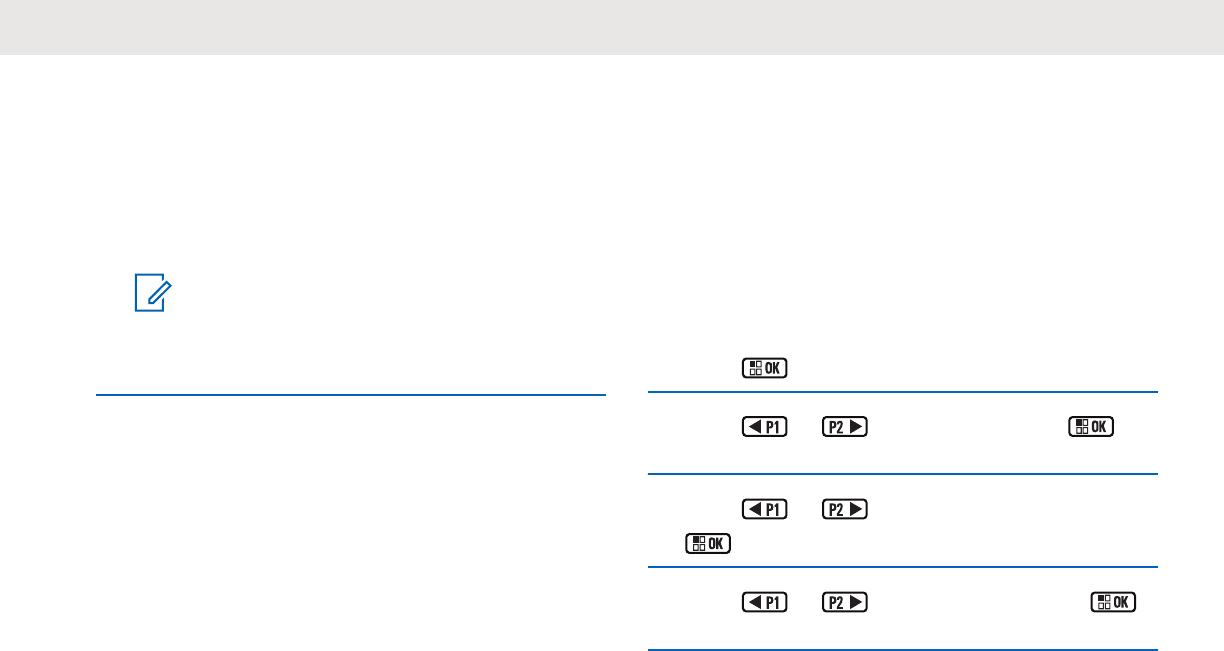
If unsuccessful:
• After the first and second attempt, the display
shows Wrong Password. Repeat step 1.
• After the third attempt, the display shows Wrong
Password and then, Radio Locked. A tone
sounds. The yellow LED double blinks. Your
radio enters into locked state for 15 minutes.
NOTICE:
In locked state, your radio responds to inputs
from the On/Off and programmed Backlight
button only.
Unlocking Radios in Locked State
Your radio is unable to receive any call, including
emergency calls, in locked state. Follow the procedure to
unlock your radio in locked state.
Do one of the following:
• If the radio is powered on, wait for 15 minutes and then
repeat the steps in Accessing Radios by Using
Passwords on page 98 to access the radio.
• If the radio is powered off, power up the radio. Your
radio restarts the 15-minute timer for locked state.
A tone sounds. The yellow LED double blinks. The
display shows Radio Locked.
Wait for 15 minutes and then repeat the steps in
Accessing Radios by Using Passwords on page 98 to
access the radio.
Turning Password Lock On or Off
Follow the procedure to turn password lock on or off on
your radio.
1Press to access the menu.
2Press or to Utilities. Press to
select.
3Press or to Radio Settings. Press
to select.
4Press or to Passwd Lock. Press
to select.
5Enter the current four-digit password.
English
Send Feedback 99
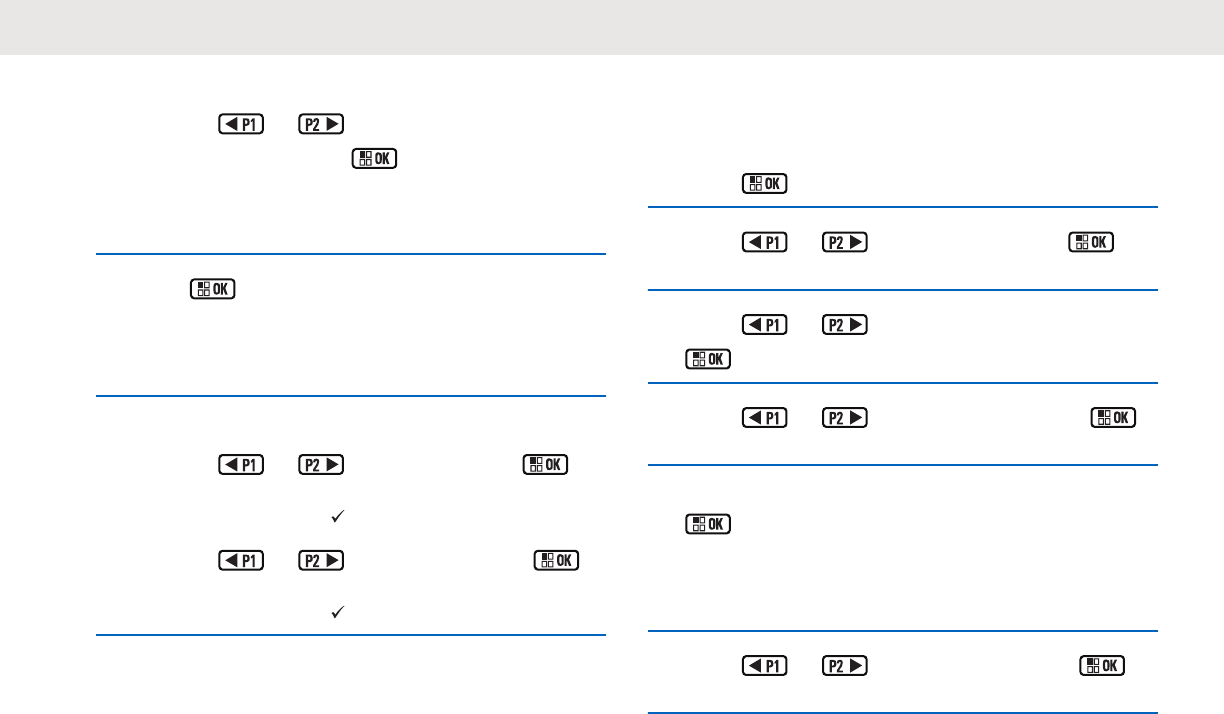
• Use a keypad microphone.
• Press or to edit the numeric value of
each digit, and press to enter and move to
the next digit.
A positive indicator tone sounds for every digit
pressed.
6Press to enter the password.
If the password is incorrect, the display shows Wrong
Password and automatically returns to the previous
menu.
7Do one of the following:
• Press or to Turn On. Press to
select.
The display shows beside Turn On.
• Press or to Turn Off. Press
to select.
The display shows beside Turn Off.
Changing Passwords
Follow the procedure to change passwords on your radio.
1Press to access the menu.
2Press or to Utilities. Press to
select.
3Press or to Radio Settings. Press
to select.
4Press or to Passwd Lock. Press
to select.
5Enter the current four-digit password, and press
to proceed.
If the password is incorrect, the display shows Wrong
Password and automatically returns to the previous
menu.
6Press or to Change PWD. Press to
select.
English
100 Send Feedback
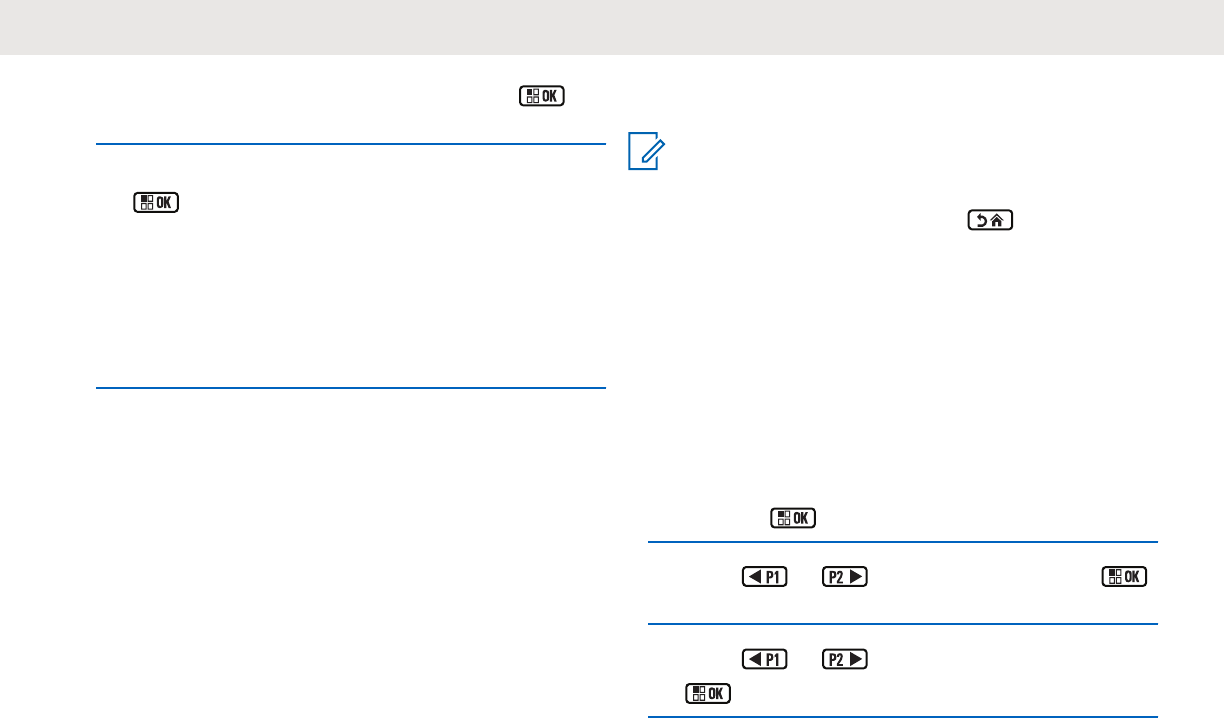
7Enter a new four-digit password, and press to
proceed.
8Re-enter the new four-digit password, and press
to proceed.
If successful, the display shows Password Changed.
If unsuccessful, the display shows Passwords Do
Not Match.
The screen automatically returns to the previous
menu.
Notification List
Your radio has a Notification list that collects all your
unread events on the channel, such as unread text
messages, telegrams, missed calls, and call alerts.
The display shows the Notification icon when the
Notification list has one or more events.
For text messages, missed calls, and call alert events, the
maximum number of notifications are 30 text messages
and 10 missed calls or call alerts. This maximum number
depends on individual feature (job tickets or text messages
or missed calls or call alerts) list capability.
NOTICE:
Your radio suspends Scan when the Notification list
is displayed. Scanning resumes when your radio
exits the Notification list. Press , or wait for
the menu timer to expire to exit the Notification list.
Accessing Notification List
Follow the procedure to access the Notification list on your
radio.
1Do one of the following:
• Press the programmed Notification button. Skip
the steps below.
• Press to access the menu.
2Press or to Notification. Press
to select.
3Press or to the required event. Press
to select.
English
Send Feedback 101

4Long press to return to the Home screen.
Auto-Range Transponder System
The Auto-Range Transponder System (ARTS) is an
analog-only feature designed to inform you when your radio
is out-of-range of other ARTS-equipped radios.
ARTS-equipped radios transmit or receive signals
periodically to confirm that they are within range of each
other.
Your radio provides indications of states as follows:
First-Time Alert
A tone sounds.
The display shows In Range after the channel alias.
ARTS-in-Range Alert
A tone sounds, if programmed.
The display shows In Range after the channel alias.
ARTS-Out-of-Range Alert
A tone sounds. The red LED rapidly blinks.
The display shows Out of Range alternating with the
Home screen.
NOTICE:
Check with your dealer or system administrator for
more information.
Over-the-Air Programming
Your dealer can remotely update your radio through Over-
the-Air Programming (OTAP) without any physical
connection. Additionally, some settings can also be
configured by using OTAP.
When your radio undergoes OTAP, the green LED blinks.
When your radio receives high volume data:
• The display shows the High Volume Data icon.
• The channel becomes busy.
• A negative tone sounds if you press the PTT button.
When OTAP completes, depending on the configuration:
• A tone sounds. The display shows Updating
Restarting. Your radio restarts by powering off and on
again.
• You can select Restart Now or Postpone. When you
select Postpone, your radio returns to the previous
screen. The display shows the OTAP Delay Timer icon
until the automatic restart occurs.
English
102 Send Feedback

When your radio powers up after automatic restart:
• If successful, the display shows Sw Update
Completed.
• If unsuccessful, the display shows Sw Update Failed.
See Checking Software Update Information on page 122
for the updated software version.
Wi-Fi Operation
Wi-Fi® is a registered trademark of Wi-Fi Alliance®.
This feature allows you to setup and connect to a Wi-Fi
network. Wi-Fi supports updates for radio firmware,
codeplug, and resources such as language packs and
voice announcement.
Turning Wi-Fi On or Off
The programmed Wi-Fi On or Off button is assigned by
default. Check with your dealer or system administrator to
determine how your radio has been programmed.
Voice Announcements for the programmed Wi-Fi On or
Off button can be customized through CPS according to
user requirements. Check with your dealer or system
administrator for more information.
You can turn on or turn off Wi-Fi by performing one of the
following actions.
• Press the programmed Wi-Fi On or Off button.
Voice Announcement sounds Turning On Wi-Fi or
Turning Off Wi-Fi.
• Access this feature using the menu.
a. Press to access the menu.
b. Press or to WiFi and press to
select.
c. Press or to Turn On and press
to select.
The radio displays Turning On WiFi.
Connecting to a Network Access Point
When you turn on Wi-Fi, the radio scans and connects to a
network access point.
1Press to access the menu.
English
Send Feedback 103

2Press or to WiFi and press to
select.
3Press or to Networks and press
to select.
4Press or to a network access point and
press to select.
5Press or to Connect and press to
select.
When the connection is successful, the radio displays a
notice and the network access point is saved into the
profile list.
Checking Wi-Fi Connection Status
Follow the procedure to check the Wi-Fi Connection status.
Press the programmed Wi-Fi Status Query button for the
connection status by using Voice Announcement. Voice
Announcement sounds Wi-Fi is Off, Wi-Fi is On but No
Connection, or Wi-Fi is On with Connection.
• The display shows WiFi Off when the Wi-Fi is
turned off.
• The display shows WiFi On, Connected when the
radio is connected to a network.
•The display shows WiFi On, Disconnected when
the Wi-Fi is turned on but the radio is not connected
to any network.
Voice Announcements for the Wi-Fi status query
results can be customized through CPS according to
user requirements. Check with your dealer or system
administrator for more information.
NOTICE:
The programmed Wi-Fi Status Query button
is assigned by default. Check with your
dealer or system administrator to determine
how your radio has been programmed.
English
104 Send Feedback

Viewing Details of Network Access
Points
Follow the procedure to view details of network access
points.
1Press to access the menu.
2Press or to WiFi and press to
select.
3Press or to a network access point and
press to select.
4Press or to view Network SSID,
Security Mode, IP Address, and MAC Address.
For a non-connected network access point, only the
Service Set Identifier (SSID) and Security Mode are
displayed.
English
Send Feedback 105

English
This page intentionally left blank.
106
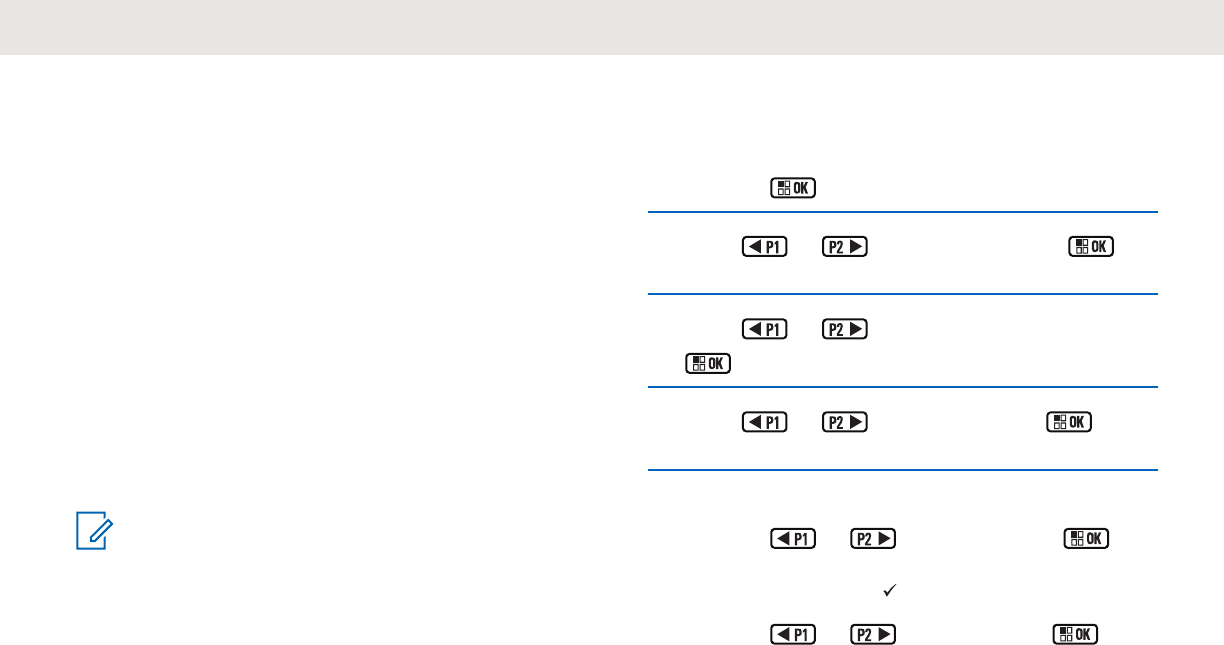
Utilities
This chapter explains the operations of the utility functions
available in your radio.
Squelch Levels
You can adjust the squelch level to filter out unwanted calls
with low signal strength or channels with noise higher than
normal background.
Normal
This is the default setting.
Tight
This setting filters out unwanted calls and/or
background noise. Calls from remote locations may also
be filtered out.
NOTICE:
This feature is not applicable in Citizens Band
channels that are in the same frequency.
Setting Squelch Levels
Follow the procedure to set the squelch levels on your
radio.
1Do one of the following:
• Press the programmed Squelch button. Skip the
following steps.
• Press to access the menu.
2Press or to Utilities. Press to
select.
3Press or to Radio Settings. Press
to select.
4Press or to Squelch. Press to
select.
5Do one of the following:
• Press or to Normal. Press to
select.
The display shows beside Normal.
• Press or to Tight. Press to
select.
English
Send Feedback 107
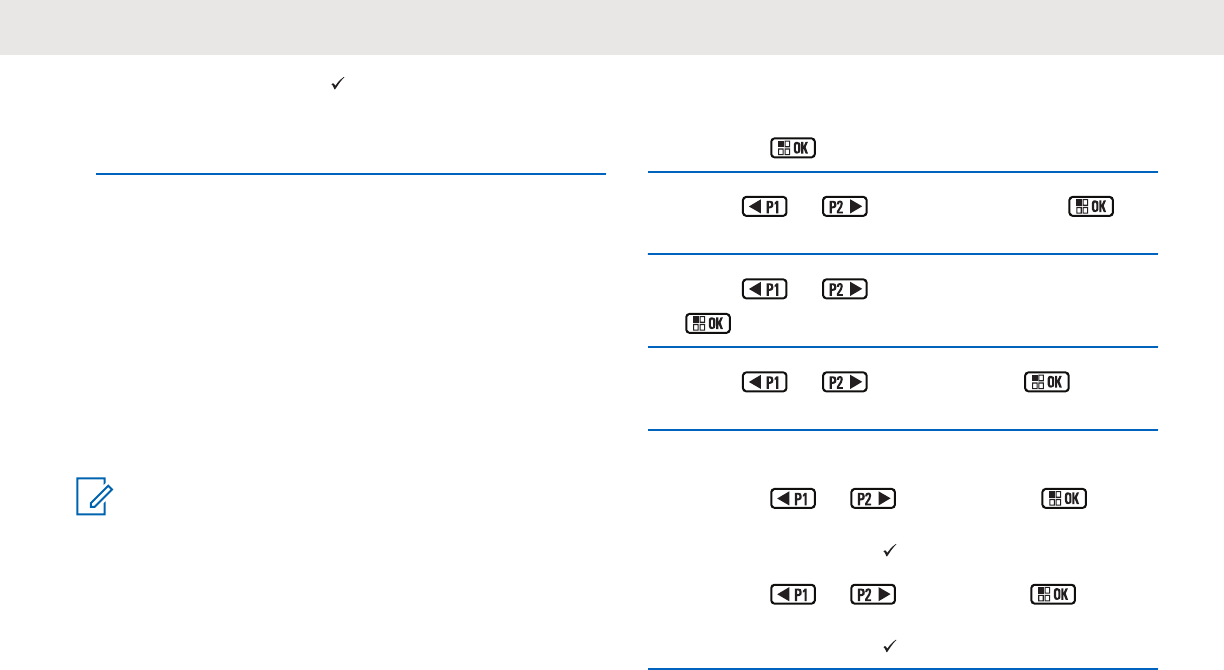
The display shows beside Tight.
The screen automatically returns to the previous
menu.
Power Levels
You can customize the power setting to high or low for
each channel.
High
This enables communication with radios located at a
considerable distance from you.
Low
This enables communication with radios in closer
proximity.
NOTICE:
This feature is not applicable in Citizens Band
channels that are in the same frequency.
Setting Power Levels
Follow the procedure to set the power levels on your radio.
1Do one of the following:
• Press the programmed Power Level button. Skip
the steps below.
• Press to access the menu.
2Press or to Utilities. Press to
select.
3Press or to Radio Settings. Press
to select.
4Press or to Power. Press to
select.
5Do one of the following:
• Press or to High. Press to
select.
The display shows beside High.
• Press or to Low. Press to
select.
The display shows beside Low.
English
108 Send Feedback
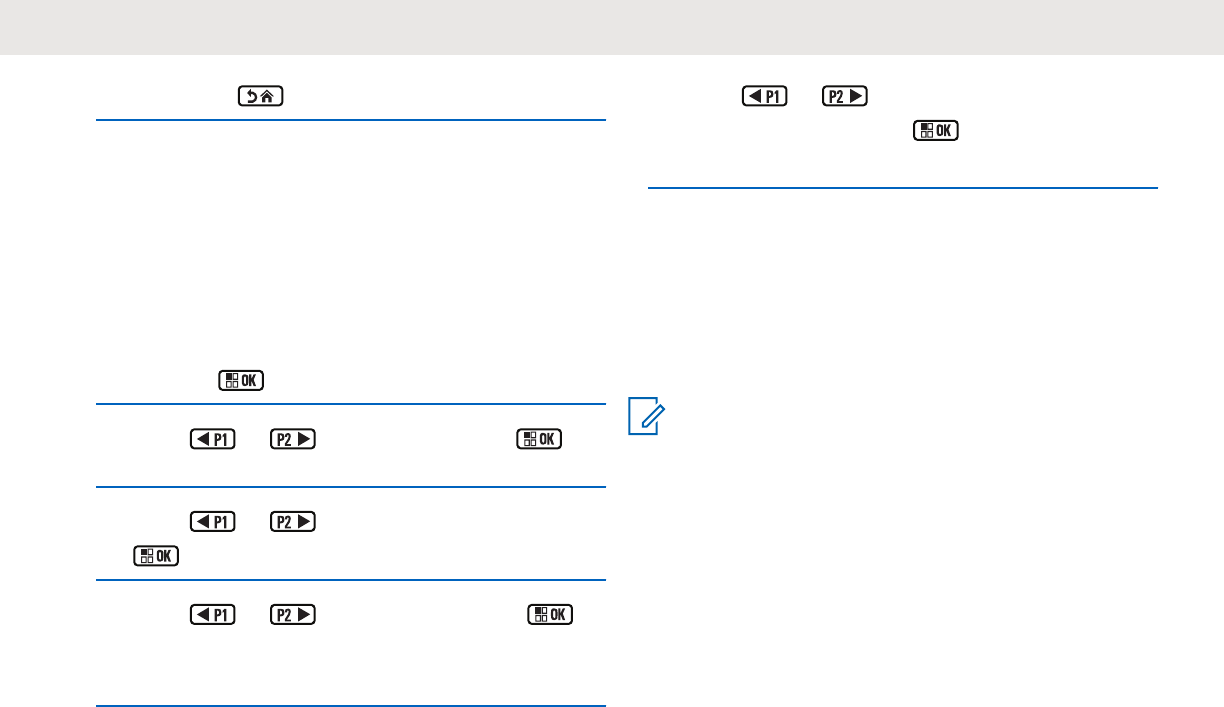
6Long press to return to the Home screen.
Adjusting Display Brightness
Follow the procedure to adjust the display brightness on
your radio.
1Do one of the following:
• Press the programmed Brightness button.
Proceed to step 5.
• Press to access the menu.
2Press or to Utilities. Press to
select.
3Press or to Radio Settings. Press
to select.
4Press or to Brightness. Press to
select.
The display shows the progress bar.
5Press or to decrease or increase the
display brightness. Press to select.
The setting value is varied from 1 to 8.
Voice Operating Transmission
The Voice Operating Transmission (VOX) allows you to
initiate a hands-free voice-activated call on a programmed
channel. The radio automatically transmits, for a
programmed period, whenever the microphone on the
VOX-capable accessory detects voice.
NOTICE:
This feature is not applicable in Citizens Band
channels that are in the same frequency.
You can enable or disable VOX by doing one of the
following:
• Turn the radio off and then power it on again to enable
VOX.
• Change the channel by using the Channel Rocker.
• Turn VOX on or off by using the programmed VOX
button or menu to enable or disable VOX.
English
Send Feedback 109
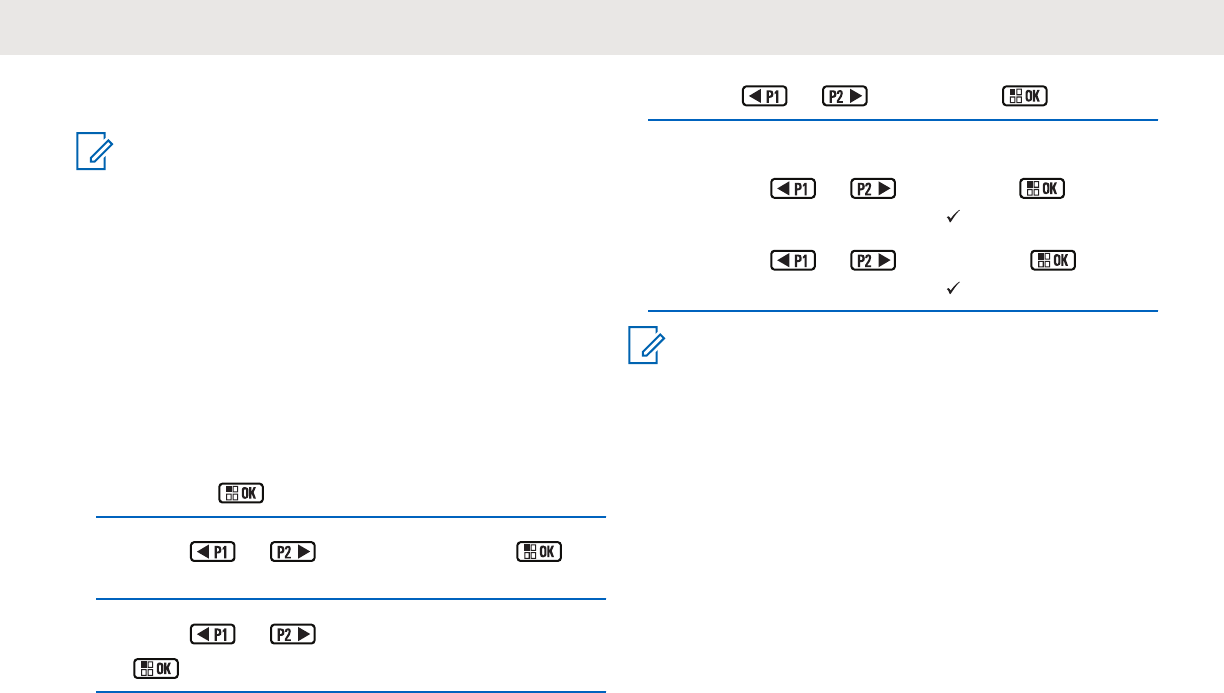
• Press the PTT button during radio operation to disable
VOX.
NOTICE:
Turning this feature on or off is limited to radios with
this function enabled. Check with your dealer or
system administrator for more information.
Turning Voice Operating Transmission
On or Off
Follow the procedure to turn VOX on or off on your radio.
1Do one of the following:
• Press the programmed VOX button. Skip the
steps below.
• Press to access the menu.
2Press or to Utilities. Press to
select.
3Press or to Radio Settings. Press
to select.
4Press or to VOX. Press to select.
5Do one of the following:
• Press or to On. Press to
select. The display shows beside On.
• Press or to Off. Press to
select. The display shows beside Off.
NOTICE:
If the Talk Permit Tone is enabled, use a trigger
word to initiate the call. Wait for the Talk Permit
Tone to finish before speaking clearly into the
microphone. See Turning Talk Permit Tone On or
Off on page 113 for more information.
Setting Display Backlight Timer
You can set the display backlight timer of the radio as
needed. The setting also affects the Menu Navigation
Buttons and keypad backlighting accordingly. Follow the
procedure to set the backlight timer on your radio.
1Do one of the following:
English
110 Send Feedback
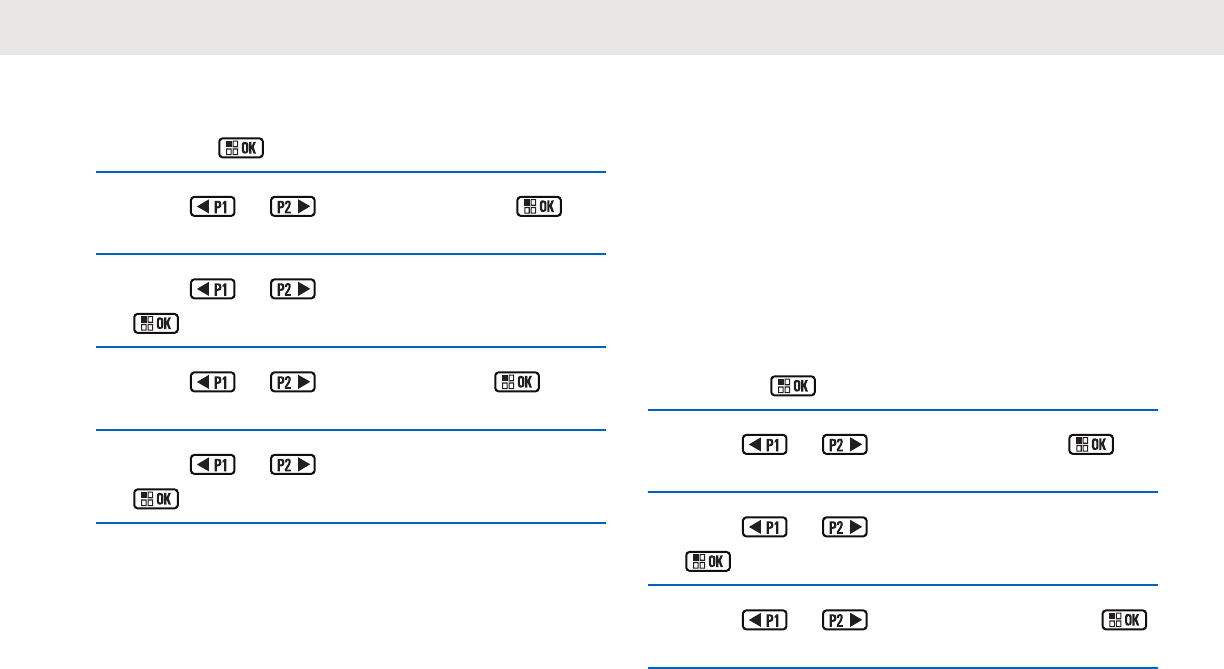
• Press the programmed Backlight button. Skip
the following steps.
• Press to access the menu.
2Press or to Utilities. Press to
select.
3Press or to Radio Settings. Press
to select.
4Press or to Display. Press to
select.
5Press or to Backlight Timer. Press
to select.
The display backlight and keypad backlighting are
automatically turned off as the LED indicator is disabled.
See Turning LED Indicators On or Off on page 114 for
more information.
Turning Radio Tones/Alerts On or
Off
You can enable and disable all radio tones and alerts, if
needed, except for incoming Emergency alert tone. Follow
the procedure to turn tones and alerts on or off on your
radio.
1Do one of the following:
• Press the programmed Tones/Alerts button. Skip
the steps below.
• Press to access the menu.
2Press or to Utilities. Press to
select.
3Press or to Radio Settings. Press
to select.
4Press or to Tones/Alerts. Press
to select.
English
Send Feedback 111
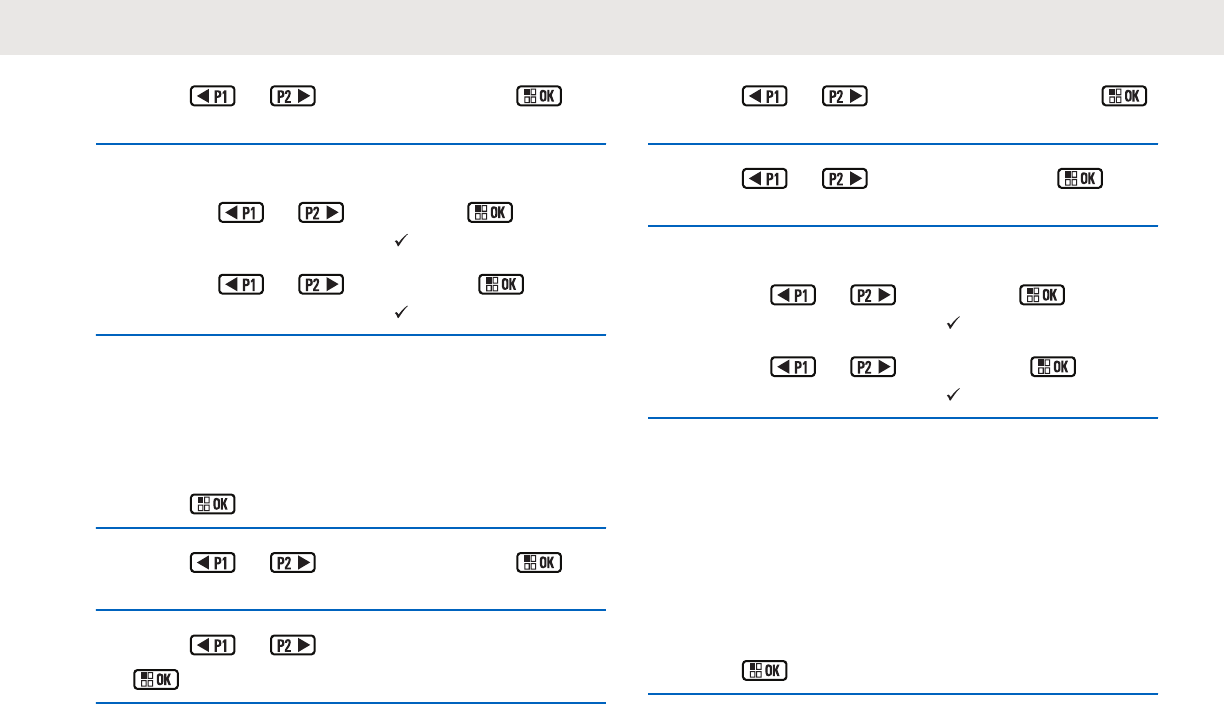
5Press or to All Tones. Press to
select.
6Do one of the following:
• Press or to On. Press to
select. The display shows beside On.
• Press or to Off. Press to
select. The display shows beside Off.
Turning Power Up Tone On or Off
Follow the procedure to turn Power Up Tone on or off on
your radio.
1Press to access the menu.
2Press or to Utilities. Press to
select.
3Press or to Radio Settings. Press
to select.
4Press or to Tones/Alerts. Press
to select.
5Press or to Power Up. Press to
select.
6Do one of the following:
• Press or to On. Press to
select. The display shows beside On.
• Press or to Off. Press to
select. The display shows beside Off.
Setting Tones/Alerts Volume Offset
Levels
This feature adjusts the volume of the tones or alerts,
allowing it to be higher or lower than the voice volume.
Follow the procedure to set the tones and alerts volume
offset levels on your radio.
1Press to access the menu.
English
112 Send Feedback
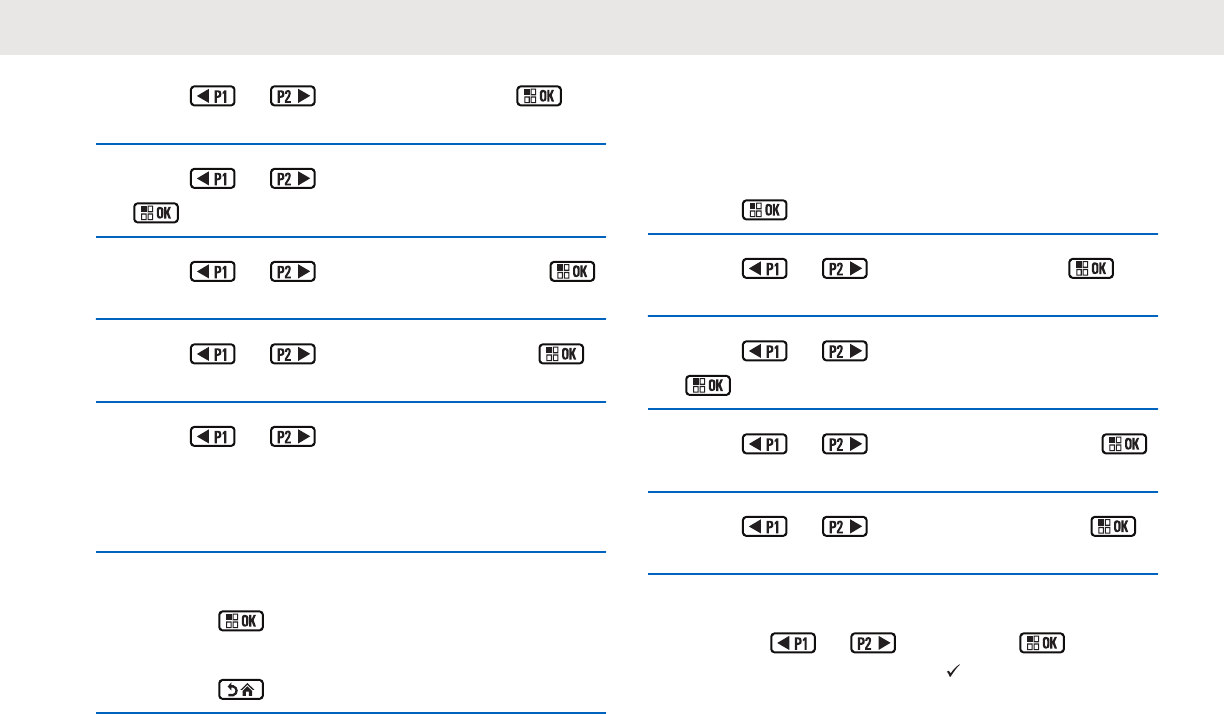
2Press or to Utilities. Press to
select.
3Press or to Radio Settings. Press
to select.
4Press or to Tones/Alerts. Press
to select.
5Press or to Vol. Offset. Press
to select.
6Press or to the required volume offset
level.
A feedback tone sounds with each corresponding
volume offset level.
7Do one of the following:
• Press to select. The required volume offset
level is saved.
• Press to exit. The changes are discarded.
Turning Talk Permit Tone On or Off
Follow the procedure to turn Talk Permit Tone on or off on
your radio.
1Press to access the menu.
2Press or to Utilities. Press to
select.
3Press or to Radio Settings. Press
to select.
4Press or to Tones/Alerts. Press
to select.
5Press or to Talk Permit. Press
to select.
6Do one of the following:
• Press or to On. Press to
select. The display shows beside On.
English
Send Feedback 113
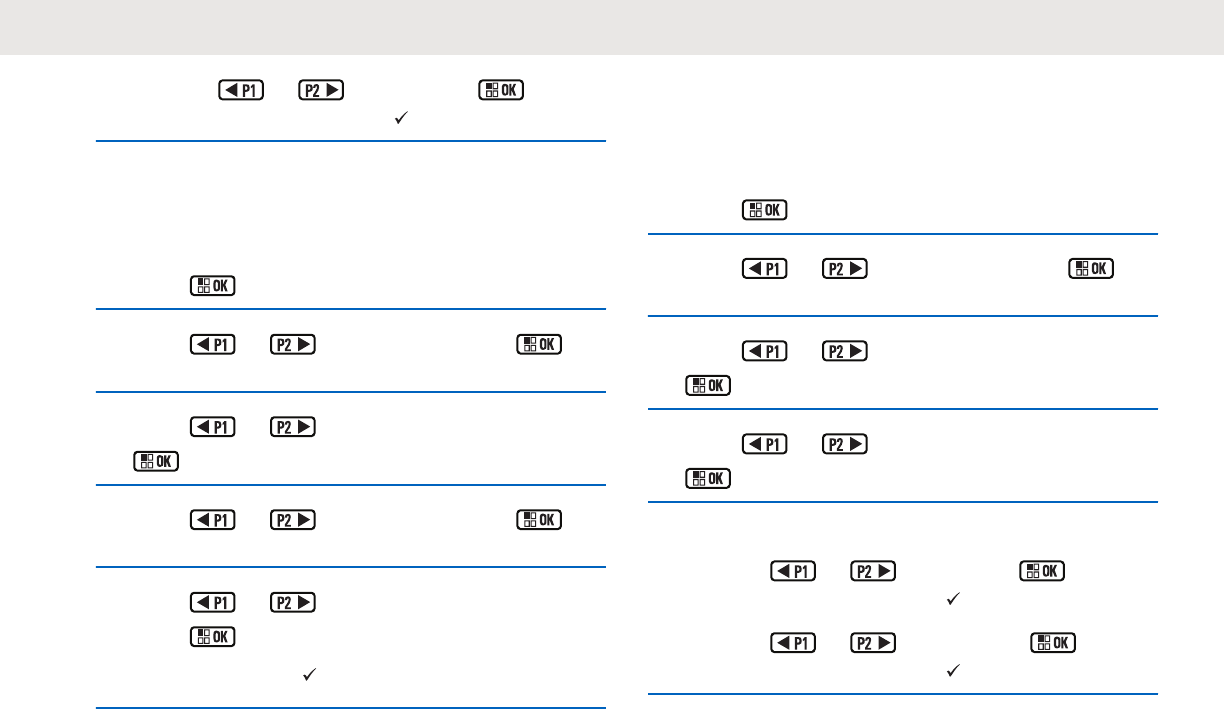
• Press or to Off. Press to
select. The display shows beside Off.
Setting Languages
Follow the procedure to set the languages on your radio.
1Press to access the menu.
2Press or to Utilities. Press to
select.
3Press or to Radio Settings. Press
to select.
4Press or to Languages. Press to
select.
5Press or to the required language.
Press to select.
The display shows beside the selected language.
Turning LED Indicators On or Off
Follow the procedure to turn the LED indicators on or off on
your radio.
1Press to access the menu.
2Press or to Utilities. Press to
select.
3Press or to Radio Settings. Press
to select.
4Press or to LED Indicator. Press
to select.
5Do one of the following:
• Press or to On. Press to
select. The display shows beside On.
• Press or to Off. Press to
select. The display shows beside Off.
English
114 Send Feedback
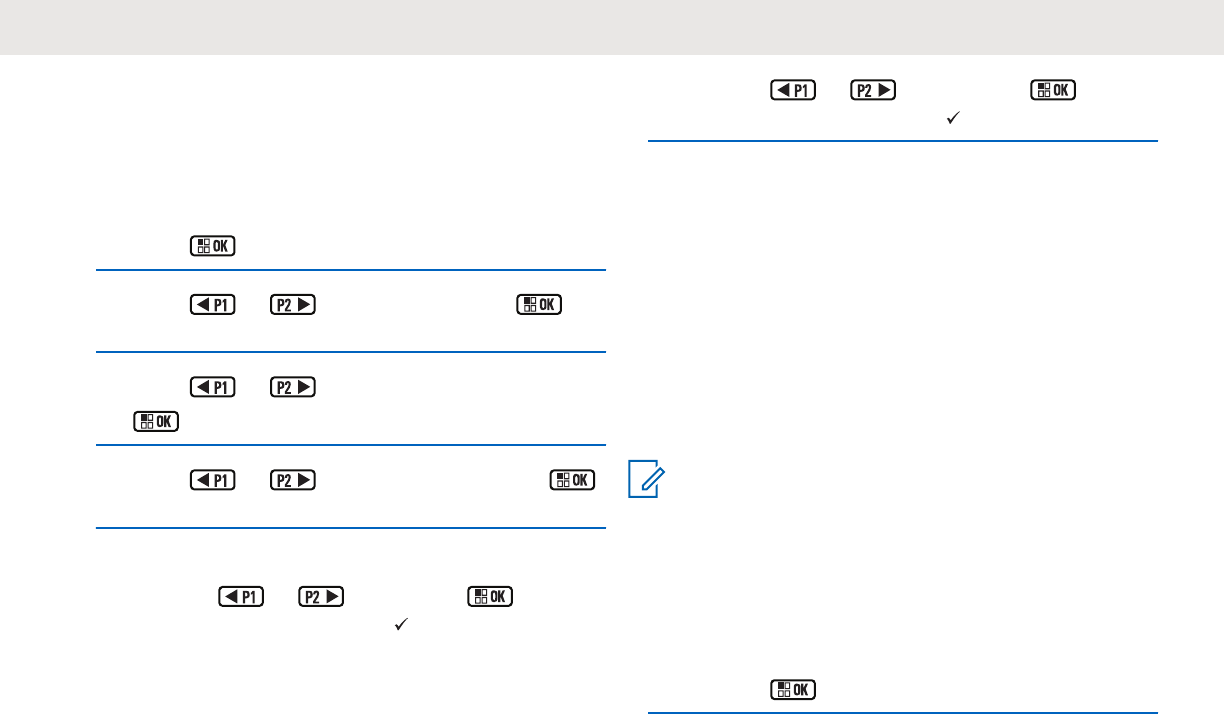
Turning Introduction Screen On or
Off
You can enable and disable the Introduction Screen by
following the procedure.
1Press to access the menu.
2Press or to Utilities. Press to
select.
3Press or to Radio Settings. Press
to select.
4Press or to Intro Screen. Press
to select.
5Do one of the following:
• Press or to On. Press to
select. The display shows beside On.
• Press or to Off. Press to
select. The display shows beside Off.
Turning Voice Announcement On or
Off
This feature enables the radio to audibly indicate the
current zone or channel the user has just assigned, or the
programmable button the user has just pressed. This is
typically useful when the user has difficulty reading the
content shown on the display. This audio indicator can be
customized according to customer requirements. Follow
the procedure to turn Voice Announcement on or off on
your radio.
NOTICE:
The Voice Announcement feature can only be
enabled through CPS. If enabled, the Text-to-
Speech feature is automatically disabled.
1Do one of the following:
• Press the programmed Voice Announcement
button. Skip the following steps.
• Press to access the menu.
English
Send Feedback 115
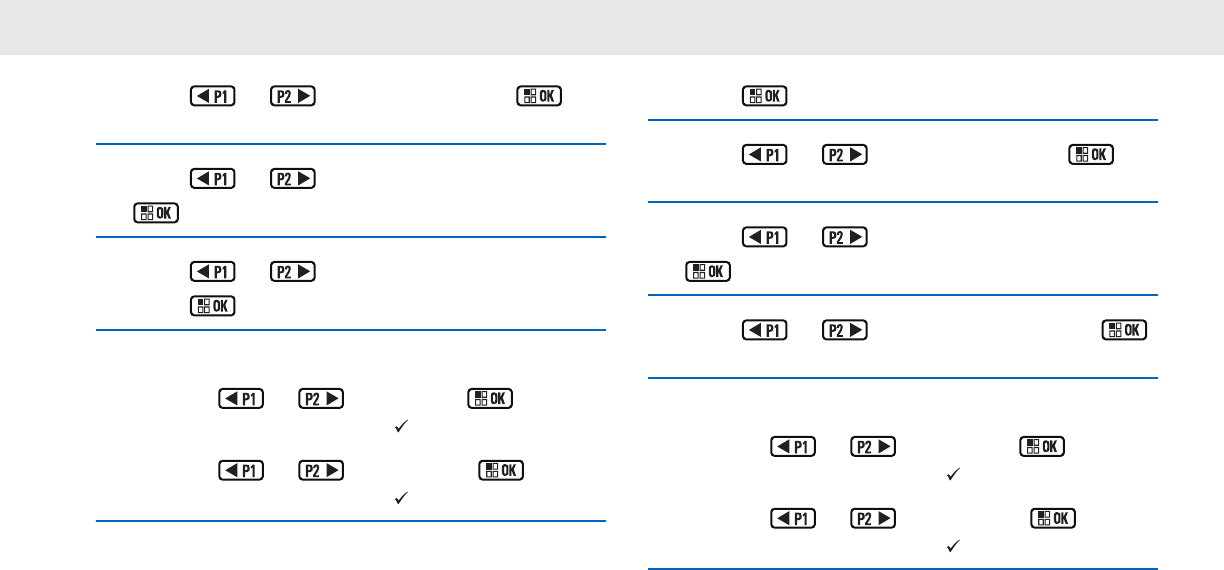
2Press or to Utilities. Press to
select.
3Press or to Radio Settings. Press
to select.
4Press or to Voice Announcement.
Press to select.
5Do one of the following:
• Press or to On. Press to
select. The display shows beside On.
• Press or to Off. Press to
select. The display shows beside Off.
Turning Automatic Call Forwarding
On or Off
You can enable your radio to automatically forward voice
calls to another radio.
1Press to access the menu.
2Press or to Utilities. Press to
select.
3Press or to Radio Settings. Press
to select.
4Press or to Call Forward. Press
to select.
5Do one of the following:
• Press or to On. Press to
select. The display shows beside On.
• Press or to Off. Press to
select. The display shows beside Off.
Setting Menu Timer
You can set the time your radio stays in the menu before it
automatically switches to the Home screen. Follow the
procedure to set the menu timer.
English
116 Send Feedback
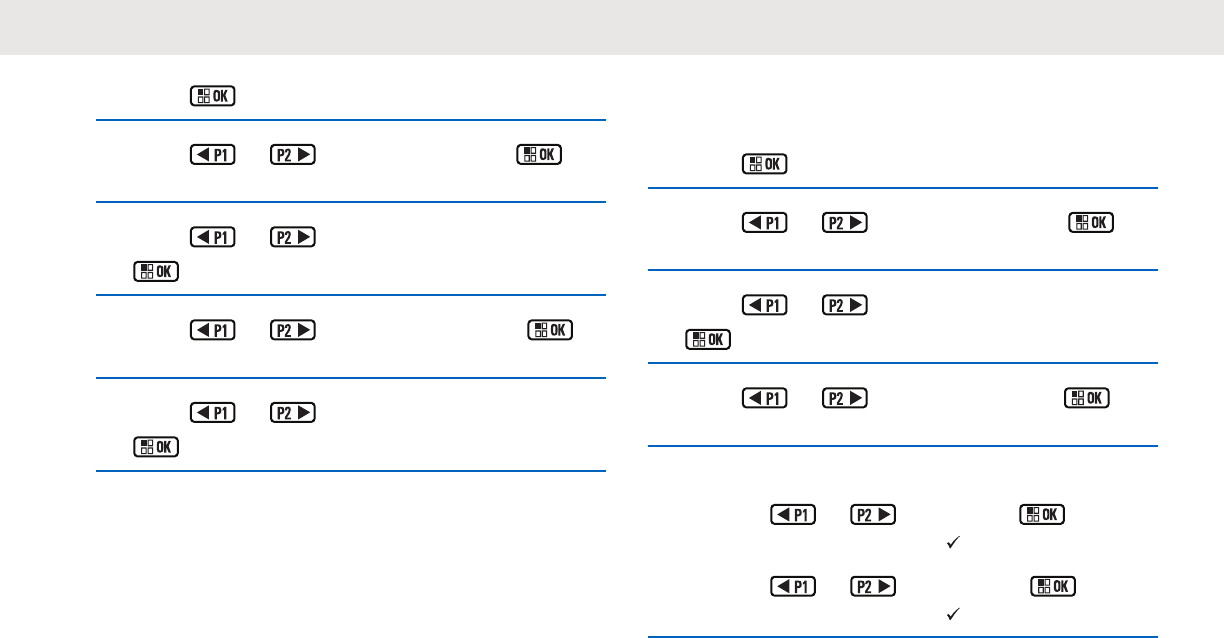
1Press to access the menu.
2Press or to Utilities. Press to
select.
3Press or to Radio Settings. Press
to select.
4Press or to Menu Timer. Press to
select.
5Press or to the required setting. Press
to select.
Turning Analog Microphone AGC On
or Off
The Analog Microphone Automatic Gain Control (AGC)
controls the microphone gain of the radio automatically
while transmitting on an analog system. This feature
suppresses loud audio or boosts soft audio to a preset
value in order to provide a consistent level of audio. Follow
the procedure to turn Analog Microphone AGC on or off on
your radio.
1Press to access the menu.
2Press or to Utilities. Press to
select.
3Press or to Radio Settings. Press
to select.
4Press or to Mic AGC-A. Press to
select.
5Do one of the following:
• Press or to On. Press to
select. The display shows beside On.
• Press or to Off. Press to
select. The display shows beside Off.
English
Send Feedback 117
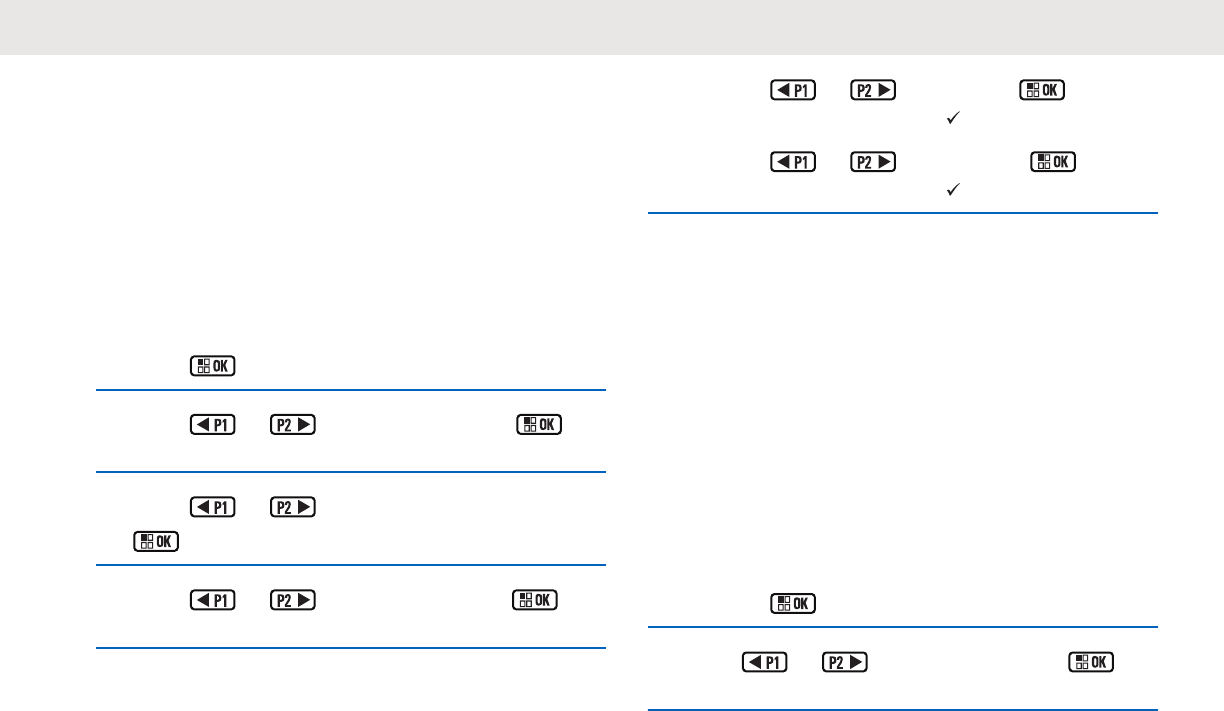
Turning Digital Microphone AGC On
or Off
The Digital Microphone Automatic Gain Control (AGC)
controls the microphone gain of the radio automatically
while transmitting on a digital system. This feature
suppresses loud audio or boosts soft audio to a preset
value in order to provide a consistent level of audio. Follow
the procedure to turn Digital Microphone AGC on or off on
your radio.
1Press to access the menu.
2Press or to Utilities. Press to
select.
3Press or to Radio Settings. Press
to select.
4Press or to Mic AGC-D. Press to
select.
5Do one of the following:
• Press or to On. Press to
select. The display shows beside On.
• Press or to Off. Press to
select. The display shows beside Off.
Turning Intelligent Audio On or Off
Your radio automatically adjusts the audio volume to
overcome current background noise in the environment,
inclusive of both stationary and non-stationary noise
sources. This is a receive-only feature and does not affect
transmission audio. Follow the procedure to turn Intelligent
Audio on or off on your radio.
1Do one of the following:
• Press the programmed Intelligent Audio button.
Skip the steps below.
• Press to access the menu.
2Press or to Utilities. Press to
select.
English
118 Send Feedback
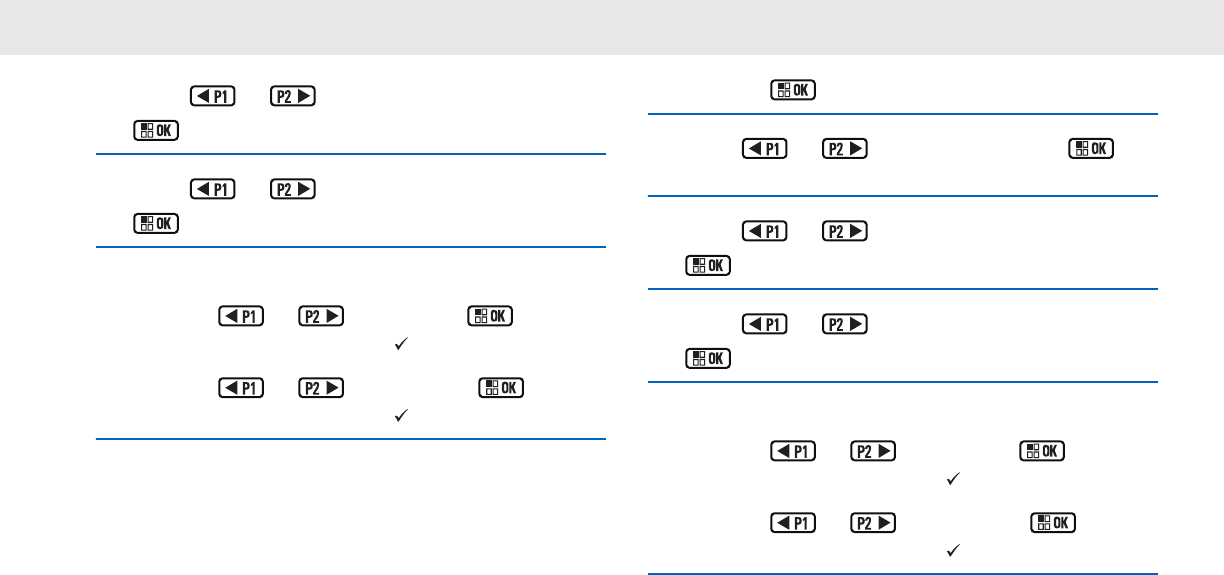
3Press or to Radio Settings. Press
to select.
4Press or to Intelligent Audio. Press
to select.
5Do one of the following:
• Press or to On. Press to
select. The display shows beside On.
• Press or to Off. Press to
select. The display shows beside Off.
Turning Trill Enhancement On or Off
You can enable this feature when you are speaking in a
language that contains many words with alveolar trill
(rolling "R") pronunciations. Follow the procedure to turn
Trill Enhancement on or off on your radio.
1Do one of the following:
• Press the programmed Trill Enhancement
button. Skip the steps below.
• Press to access the menu.
2Press or to Utilities. Press to
select.
3Press or to Radio Settings. Press
to select.
4Press or to Trill Enhance. Press
to select.
5Do one of the following:
• Press or to On. Press to
select. The display shows beside On.
• Press or to Off. Press to
select. The display shows beside Off.
English
Send Feedback 119
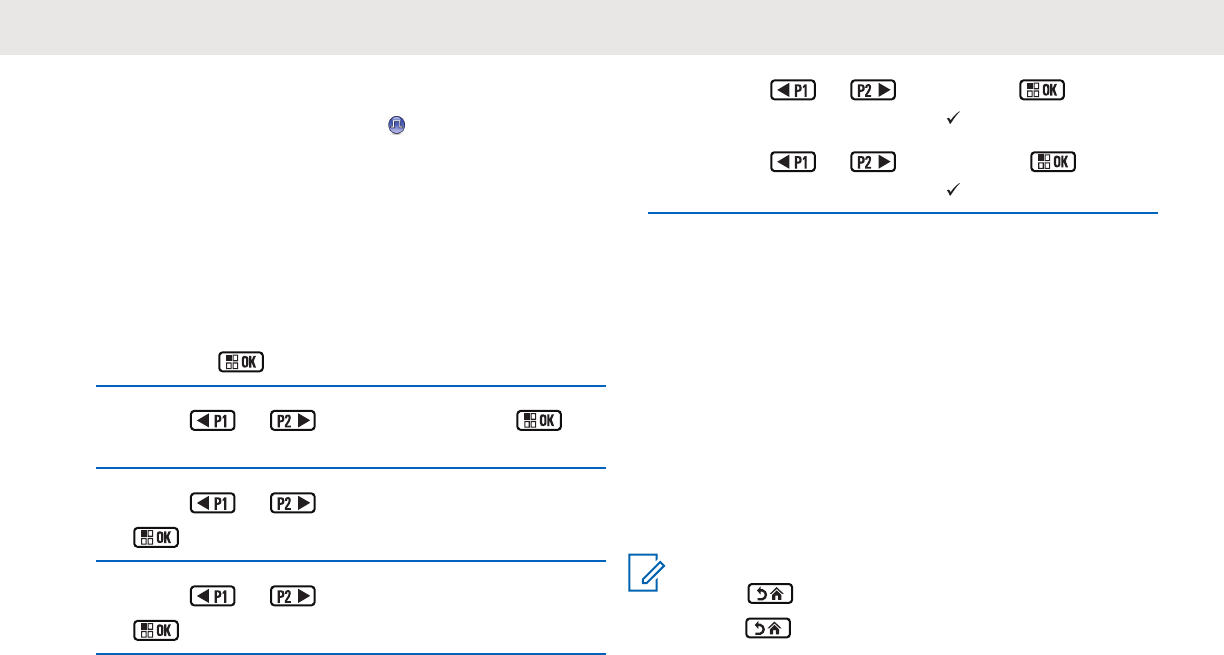
Turning Acoustic Feedback
Suppressor On or Off
The feature allows you to minimize acoustic feedback in
received calls. Follow the procedure to turn Acoustic
Feedback Suppressor on or off on your radio.
1Do one of the following:
• Press the programmed AF Suppressor button.
Skip the following steps.
• Press to access the menu.
2Press or to Utilities. Press to
select.
3Press or to Radio Settings. Press
to select.
4Press or to AF Suppressor. Press
to select.
5Do one of the following:
• Press or to On. Press to
select. The display shows beside On.
• Press or to Off. Press to
select. The display shows beside Off.
General Radio Information
Your radio contains information on various general
parameters.
The general information of your radio is as follows:
• Battery information.
• Radio alias and ID.
• Firmware and Codeplug versions.
• Software update.
• GNSS information.
NOTICE:
Press to return to the previous screen. Long
press to return to the Home screen. The radio
exits the current screen once the inactivity timer
expires.
English
120 Send Feedback
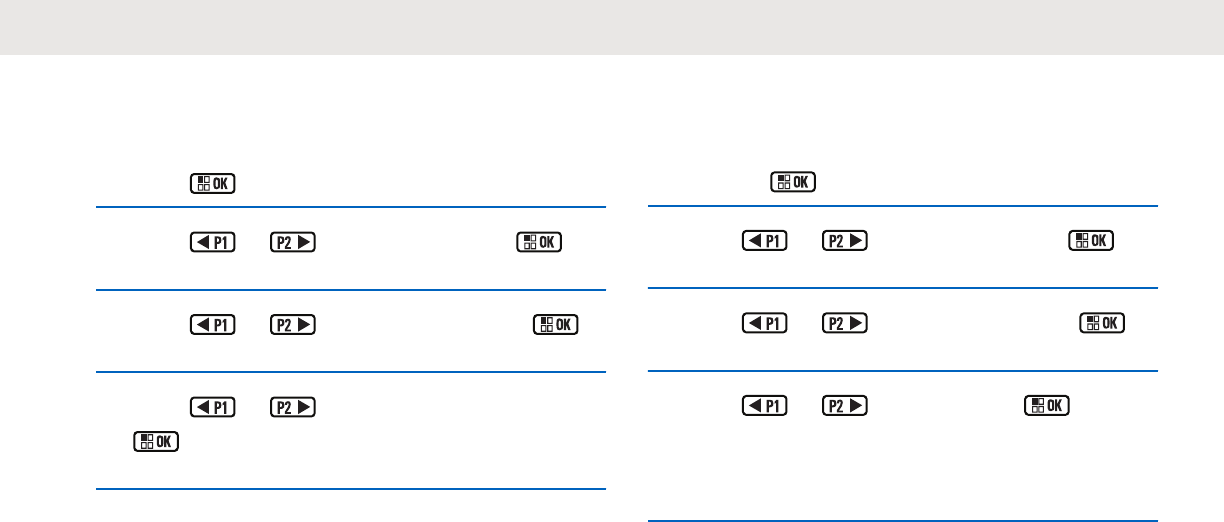
Accessing Battery Information
Displays information of your radio battery.
1Press to access the menu.
2Press or to Utilities. Press to
select.
3Press or to Radio Info. Press
to select.
4Press or to Battery Info. Press
to select. The display shows the battery
information.
Checking Radio Alias and ID
Follow the procedure to check the radio alias and ID on
your radio.
1Do one of the following:
• Press the programmed Radio Alias and ID
button. Skip the steps below.
A positive indicator tone sounds.
You can press the programmed Radio Alias and
ID button to return to the previous screen.
• Press to access the menu.
2Press or to Utilities. Press to
select.
3Press or to Radio Info. Press to
select.
4Press or to My ID. Press to
select.
The first text line shows the radio alias. The second
text line shows the radio ID.
Checking Firmware and Codeplug
Versions
Follow the procedure to check the firmware and codeplug
versions on your radio.
English
Send Feedback 121
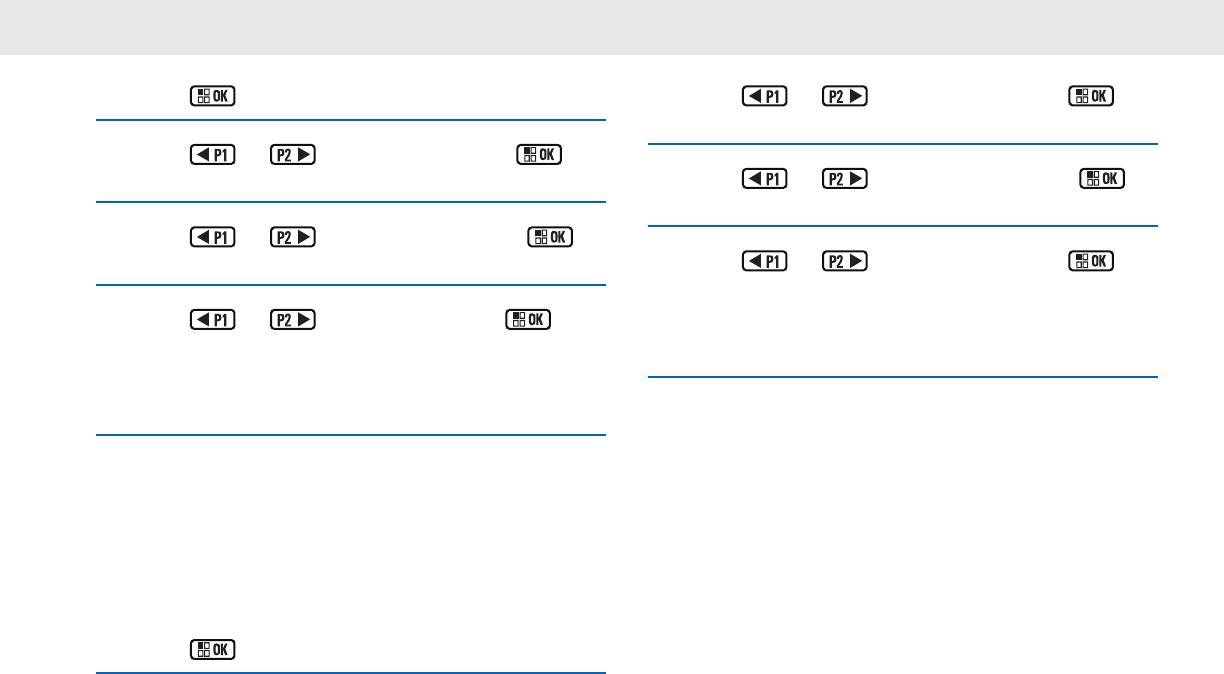
1Press to access the menu.
2Press or to Utilities. Press to
select.
3Press or to Radio Info. Press to
select.
4Press or to Versions. Press to
select.
The display shows the current firmware and
codeplug versions.
Checking Software Update Information
This feature shows the date and time of the latest software
update carried out through OTAP or Wi-Fi. Follow the
procedure to check the software update information on
your radio.
1Press to access the menu.
2Press or to Utilities. Press to
select.
3Press or to Radio Info. Press to
select.
4Press or to SW Update. Press to
select.
The display shows the date and time of the latest
software update.
Software Update menu is only available after at least one
successful OTAP or Wi-Fi session. See Over-the-Air
Programming on page 102 for more information.
Received Signal Strength Indicator
This feature allows you to view the Received Signal
Strength Indicator (RSSI) values.
The display shows the RSSI icon at the top right corner.
See Display Icons for more information on the RSSI icon.
English
122 Send Feedback

Viewing RSSI Values
Follow the procedure to view RSSI values on your radio.
When you are at the Home screen:
1Press three times and immediately press
three times, all in 5 seconds.
The display shows the current RSSI values.
2Long press to return to the Home screen.
Front Panel Programming
You are able to customize certain feature parameters in
Front Panel Programming (FPP) to enhance the use of
your radio.
The following buttons are used as required while navigating
through the feature parameters.
Left/Right Navigation Button
Press to navigate through options horizontally or
vertically, or increase or decrease values.
Menu/OK Button
Press to select the option or enter a sub-menu.
Return/Home Button
Short press to return to the previous menu or exit the
selection screen.
Long press at any time to return to the Home screen.
English
Send Feedback 123

English
This page intentionally left blank.
124

Authorized Accessories List
Antenna
• UHF, 403–425 MHz, 4.5 cm, Stubby Antenna
(PMAE4093_)
• UHF, 420–445 MHz, 4.5 cm, Stubby Antenna
(PMAE4094_)
• UHF, 435–470 MHz, 4.5 cm, Stubby Antenna
(PMAE4095_)
• UHF, 445–480 MHz, 4.5 cm, Stubby Antenna
(PMAE4099_)
• VHF, 136–144 MHz, 5.0 cm, Stubby Antenna
(PMAD4144_)
• VHF, 144–156 MHz, 5.0 cm, Stubby Antenna
(PMAD4145_)
• VHF, 156–174 MHz, 5.0 cm, Stubby Antenna
(PMAD4146_)
• VHF, 136–144 MHz, 9.0 cm, Whip Antenna
(PMAD4154_)
• VHF, 144–156 MHz, 9.0 cm, Whip Antenna
(PMAD4155_)
• VHF, 156–174 MHz, 9.0 cm, Whip Antenna
(PMAD4156_)
Batteries
• BT100x Lithium-Ion 2200 mAh Battery Pack
(PMNN4468_)
Carry Devices
• Flexible Quick Release Hand Strap (PMLN7076_)
• Heavy-Duty Swivel Belt Clip (PMLN7128_)
• Swivel Carry Holster (PMLN7190_)
• Nylon Wrist Strap (PMLN6074_)
Chargers
• Standard Multi-Unit Charger (PMLN7093_)
• Standard Multi-Unit Charger, US/NA Plug (PMLN7101_)
• Standard Single Unit Charger (PMLN7094_)
• Standard Single Unit Charger, US/NA Plug
(PMLN7109_)
• Micro USB Power Supply, 5 V 1 A, US/NA Plug
(25009298001)
English
Send Feedback 125

• Power Supply Adaptor 100V-240V, Micro USB
(PS000227A01)
Earbuds and Earpieces
• Swivel Earpiece, In-line Mic and PTT (PMLN7189_)
• Earbud with In-line Mic/PTT, MagOne (PMLN7156_)
• 2-Wire with Transparent Tube, Black (PMLN7157_)
• 1-Wire Surveillance Earpiece, In-Line Mic and PTT
(PMLN7158_)
• Adjustable D-Style with In-Line Mic and PTT
(PMLN7159_)
• Transparent Acoustic Tube (RLN6242_)
• High Noise Yellow Foam Earpieces (5080384F72)
Miscellaneous
• Battery Door (PMLN7074_)
Wireless
• Push-to-Talk Module, without Charger (NNTN8191_)
• 1-Wire Earbud, 29 cm Cord, Black (NNTN8294_)
• 1-Wire Earbud,116 cm Cord, Black (NNTN8295_)
• Eartips for Operations Critical Wireless Earbuds
(Replacement for NNTN8294_ and NNTN8295_)
(NNTN8299_)
• Wireless Neckloop Y-adapter and retention hook for
Completely Discreet Kit (NNTN8385_)
• Discreet Surveillance Kit (NNTN8433_)
• Business Wireless Accessory Kit (PMLN6463_)
• Operations Critical Wireless 1-Wire Surveillance Kit with
Translucent Tube (PMLN7052_)
• Completely Discreet Earpiece Kit (RLN4922_)5
• XBT Behind-the-Neck, Non-Secure Wireless Heavy
Duty Headset (RLN6490_)
• XBT Overhead, Non-Secure Wireless Heavy Duty
Headset (RLN6491_)
• Swivel Earpiece with In-Line Microphone (RLN6550_)5
• Non-Secure HK200 Mobile Bluetooth Headset (89409N)
• Non-Secure Wireless Headset & Push-to-Talk Device
with Push-to-Talk Audio, 12-Inch Cable (NNTN8125_)
5Contact your dealer on the availability of these accessories.
English
126 Send Feedback

• Non-Secure Wireless Headset & Push-to-Talk Device
with Push-to-Talk Audio, 9.5-Inch Cable (NNTN8126_)
• Non-Secure Wireless Push-to-Talk Device
(NNTN8127_)
• Non - Secure Bluetooth Wireless Push-to-Talk Device
(NTN8127_N)
• Non-Secure Wireless Headset & Push-to-Talk Device
with Push-to-Talk Audio, 12-Inch Cable (NNTN8189_)
• Earpiece 12-Inch Cable (Replacement for NNTN8125_)
(NTN2572_)
• Earpiece 9.5-Inch Cable (Replacement for NNTN8126_)
(NTN2575_)
• Bluetooth Accessory Kit with NA Power Supply
(RLN6500_)
English
Send Feedback 127

English
This page intentionally left blank.
128

Batteries and Chargers
Warranty
The Workmanship Warranty
The workmanship warranty guarantees against defects in
workmanship under normal use and service.
SL Series Batteries 12 Months
Chargers (Single-Unit and
Multi-Unit, Non-Display)
12 Months
The Capacity Warranty
The capacity warranty guarantees 80% of the rated
capacity for the warranty duration.
Lithium-Ion (Li-lon) Batter-
ies
12 Months
English
Send Feedback 129

English
This page intentionally left blank.
130

Limited Warranty
MOTOROLA SOLUTIONS
COMMUNICATION PRODUCTS
I. WHAT THIS WARRANTY COVERS
AND FOR HOW LONG:
Motorola Solutions, Inc. ("Motorola Solutions") warrants the
Motorola Solutions manufactured Communication Products
listed below ("Product") against defects in material and
workmanship under normal use and service for a period of
time from the date of purchase as scheduled below:
Digital Radios 24 Months
Product Accessories 12 Months
Motorola Solutions, at its option, will at no charge either
repair the Product (with new or reconditioned parts),
replace it (with a new or reconditioned Product), or refund
the purchase price of the Product during the warranty
period provided it is returned in accordance with the terms
of this warranty. Replaced parts or boards are warranted
for the balance of the original applicable warranty period.
All replaced parts of Product shall become the property of
Motorola Solutions.
This express limited warranty is extended by Motorola
Solutions to the original end user purchaser only and is not
assignable or transferable to any other party. This is the
complete warranty for the Product manufactured by
Motorola Solutions. Motorola Solutions assumes no
obligations or liability for additions or modifications to this
warranty unless made in writing and signed by an officer of
Motorola Solutions.
Unless made in a separate agreement between Motorola
Solutions and the original end user purchaser, Motorola
Solutions does not warrant the installation, maintenance or
service of the Product.
Motorola Solutions cannot be responsible in any way for
any ancillary equipment not furnished by Motorola
Solutions which is attached to or used in connection with
the Product, or for operation of the Product with any
ancillary equipment, and all such equipment is expressly
excluded from this warranty. Because each system which
may use the Product is unique, Motorola Solutions
disclaims liability for range, coverage, or operation of the
system as a whole under this warranty.
English
Send Feedback 131

II. GENERAL PROVISIONS
This warranty sets forth the full extent of Motorola Solutions
responsibilities regarding the Product. Repair, replacement
or refund of the purchase price, at Motorola Solutions
option, is the exclusive remedy. THIS WARRANTY IS
GIVEN IN LIEU OF ALL OTHER EXPRESS
WARRANTIES. IMPLIED WARRANTIES, INCLUDING
WITHOUT LIMITATION, IMPLIED WARRANTIES OF
MERCHANTABILITY AND FITNESS FOR A PARTICULAR
PURPOSE, ARE LIMITED TO THE DURATION OF THIS
LIMITED WARRANTY. IN NO EVENT SHALL MOTOROLA
SOLUTIONS BE LIABLE FOR DAMAGES IN EXCESS OF
THE PURCHASE PRICE OF THE PRODUCT, FOR ANY
LOSS OF USE, LOSS OF TIME, INCONVENIENCE,
COMMERCIAL LOSS, LOST PROFITS OR SAVINGS OR
OTHER INCIDENTAL, SPECIAL OR CONSEQUENTIAL
DAMAGES ARISING OUT OF THE USE OR INABILITY
TO USE SUCH PRODUCT, TO THE FULL EXTENT SUCH
MAY BE DISCLAIMED BY LAW.
III. STATE LAW RIGHTS:
SOME STATES DO NOT ALLOW THE EXCLUSION OR
LIMITATION OF INCIDENTAL OR CONSEQUENTIAL
DAMAGES OR LIMITATION ON HOW LONG AN IMPLIED
WARRANTY LASTS, SO THE ABOVE LIMITATION OR
EXCLUSIONS MAY NOT APPLY.
This warranty gives specific legal rights, and there may be
other rights which may vary from state to state.
IV. HOW TO GET WARRANTY
SERVICE
You must provide proof of purchase (bearing the date of
purchase and Product item serial number) in order to
receive warranty service and, also, deliver or send the
Product item, transportation and insurance prepaid, to an
authorized warranty service location. Warranty service will
be provided by Motorola Solutions through one of its
authorized warranty service locations. If you first contact
the company which sold you the Product (e.g., dealer or
communication service provider), it can facilitate your
obtaining warranty service. You can also call Motorola
Solutions at 1-800-927-2744 US/Canada.
V. WHAT THIS WARRANTY DOES
NOT COVER
1Defects or damage resulting from use of the Product in
other than its normal and customary manner.
English
132 Send Feedback

2Defects or damage from misuse, accident, water, or
neglect.
3Defects or damage from improper testing, operation,
maintenance, installation, alteration, modification, or
adjustment.
4Breakage or damage to antennas unless caused directly
by defects in material workmanship.
5A Product subjected to unauthorized Product
modifications, disassembles or repairs (including,
without limitation, the addition to the Product of non-
Motorola Solutions supplied equipment) which adversely
affect performance of the Product or interfere with
Motorola Solutions normal warranty inspection and
testing of the Product to verify any warranty claim.
6Product which has had the serial number removed or
made illegible.
7Rechargeable batteries if:
• any of the seals on the battery enclosure of cells are
broken or show evidence of tampering.
• the damage or defect is caused by charging or using
the battery in equipment or service other than the
Product for which it is specified.
8Freight costs to the repair depot.
9A Product which, due to illegal or unauthorized
alteration of the software/firmware in the Product, does
not function in accordance with Motorola Solutions
published specifications or the FCC certification labeling
in effect for the Product at the time the Product was
initially distributed from Motorola Solutions.
10 Scratches or other cosmetic damage to Product
surfaces that does not affect the operation of the
Product.
11 Normal and customary wear and tear.
VI. PATENT AND SOFTWARE
PROVISIONS
Motorola Solutions will defend, at its own expense, any suit
brought against the end user purchaser to the extent that it
is based on a claim that the Product or parts infringe a
United States patent, and Motorola Solutions will pay those
costs and damages finally awarded against the end user
purchaser in any such suit which are attributable to any
such claim, but such defense and payments are
conditioned on the following:
1Motorola Solutions will be notified promptly in writing by
such purchaser of any notice of such claim,
English
Send Feedback 133

2Motorola Solutions will have sole control of the defense
of such suit and all negotiations for its settlement or
compromise, and
3Should the Product or parts become, or in Motorola
Solutions opinion be likely to become, the subject of a
claim of infringement of a United States patent, that
such purchaser will permit Motorola Solutions, at its
option and expense, either to procure for such
purchaser the right to continue using the Product or
parts or to replace or modify the same so that it
becomes non-infringing or to grant such purchaser a
credit for the Product or parts as depreciated and accept
its return. The depreciation will be an equal amount per
year over the lifetime of the Product or parts as
established by Motorola Solutions.
Motorola Solutions will have no liability with respect to any
claim of patent infringement which is based upon the
combination of the Product or parts furnished hereunder
with software, apparatus or devices not furnished by
Motorola Solutions, nor will Motorola Solutions have any
liability for the use of ancillary equipment or software not
furnished by Motorola Solutions which is attached to or
used in connection with the Product. The foregoing states
the entire liability of Motorola Solutions with respect to
infringement of patents by the Product or any parts thereof.
Laws in the United States and other countries preserve for
Motorola Solutions certain exclusive rights for copyrighted
Motorola Solutions software such as the exclusive rights to
reproduce in copies and distribute copies of such Motorola
Solutions software. Motorola Solutions software may be
used in only the Product in which the software was
originally embodied and such software in such Product may
not be replaced, copied, distributed, modified in any way, or
used to produce any derivative thereof. No other use
including, without limitation, alteration, modification,
reproduction, distribution, or reverse engineering of such
Motorola Solutions software or exercise of rights in such
Motorola Solutions software is permitted. No license is
granted by implication, estoppel or otherwise under
Motorola Solutions patent rights or copyrights.
VII. GOVERNING LAW
This Warranty is governed by the laws of the State of
Illinois, U.S.A.
English
134 Send Feedback

MOTOROLA, MOTO, MOTOROLA SOLUTIONS and the Stylized M Logo are trademarks or registered
trademarks of Motorola Trademark Holdings, LLC and are used under license. All other trademarks are
the property of their respective owners. © 2017 Motorola Solutions, Inc. All rights reserved.
Motorola Solutions, Inc.
1303 East Algonquin Road
Schaumburg, Illinois 60196 U.S.A.
Printed in U.S.A.
www.motorolasolutions.com/mototrbo

